

How Big Are Yachts? 5 Types Explained (With Numbers)
Yachts can come in a variety of sizes and weights. Before you purchase a yacht, you must know what size yacht you need.
The size and weight of the yacht that you need will depend greatly on what your intended use is for the yacht that you are purchasing.
Table of Contents
Here’s everything you need to know about the weight of yachts:
Here’s an Idea of How Big Yachts Are:
The term “Yachts” refers to a pleasure vessel that is at least 30 feet in length and has some type of cabin with some amenities. The biggest luxury yacht is 590 feet (180 meters) and 13,136 gross tons.

What Do We Mean When We Talk About Weight?
There are two types of weight for a boat, dry weight, and wet weight.
Dry weight is the weight of the boat without any fluids in the tanks. Wet weight is the weight of the boat with the fluids in the tanks.
You can also have a loaded weight, which is the wet weight, including any additional toys or equipment you have stored onboard.
What Do We Mean When We Talk About Length?
There are many different ways to calculate a boat’s length. For this reason, you want to make sure that you have a clear idea of what the length of your boat really is.
The boat’s registered length is generally the maximum overall length, which is the length on deck plus any bowsprit or swim deck. The length of the boat on the waterline is also an important boat characteristic that you should know.
Due to the shape and construction of the hull, these numbers may differ.
For example, if you have a boat that has a 50-foot deck with no bowsprit, your registered length will be 50 feet.
Some boats are measured using “LOA,” otherwise known as length overall.
Why Is Knowing The Weight And Length Important?
The most important reason to know your boat’s weight and length is for when you choose to shop for trailers or even to determine if your vehicle can haul it.
If you try to tow a boat without an accurate representation of the weight or length, you can ruin your vehicle’s engine and even your towing equipment, not to mention have serious safety issues.
Another reason to know about your vessel’s weight is to know how much you can bring for your trip without packing more than the maximum weight allowed.
It is also important to know your weight and how it can affect your boat, especially when it comes to speed.
Different Types of Boats and Their Average Weight and Length
Below are some different types of boats and their average size and weight, and the factors that go into them.
1. Luxury Yacht

Yachts are normally classified as any watercraft that can be used for pleasure or sport and can range from 30 ft to over 100 ft.
While a yacht can be as small as 30 ft. long, a yacht is often considered a cabin cruiser until it is 39 ft. or more, then it is considered a proper yacht.
A yacht would be considered a large yacht once it’s length is over 79 feet. A yacht is considered a superyacht or megayacht if it is over 115 feet long.
The yacht the holds the record for being the longest yacht is 590 feet long. This yacht is called the “Azzam” and has held onto its title for over 5 years.
Because of the wide variety of sizes, the weight can vary greatly when it comes to yachts, and it is hard to nail down an average.
Some more distinctive differences between yachts include:
- These yachts are single-deck yachts with one living quarter below . They are often sleek and sporty.
- Also known as a sedan bridge or sport bridge yacht. This yacht has an area on top of the superstructure that features a view all the way around the vessel.
- This deck up top can offer a control station or even lounge seating, depending on its size.
- Also known as a pilothouse motor yacht, cockpit motor yacht, or sky lounge. This term can be used for any large recreational vessel that is motor powered.
- Usually, this means a multi-deck vessel similar to a flybridge but instead has a large interior deck.
- Often classified as a mega yacht, which is normally any vessel 80 ft. or more. This vessel is exactly what it sounds like.
- It is a yacht with three levels of enclosed living space.
- A sportfishing yacht is any yacht that is geared towards fishing.
- They often have areas designated to storage for rods, bait, tackle, and even areas to store the day’s catch.
2. Sailboats

Large sailboats are yachts propelled by sails and can be found in lakes, rivers, and even out on the ocean. Today, they almost all have auxiliary power in the form of an engine.
While the weight and length of a sailboat can drastically vary, the average weight of a sailboat is about 8,800 pounds. This weight does not include added gear, equipment, or fluids.
The weight will vary greatly depending on the length of the sailboat. Sailboat lengths can range between 8 feet to 472 feet.
The 472-foot sailboat also carries three masts that tower at over 91 feet each. This can definitely add more weight than the 8-foot vessel.
Listed below are 6 examples of sailboats and their weights and lengths:
- Catalina 16 LOA: 16 ft. 4 in. Hull Weight: 430 pounds
- Hunter 22 LOA: 21 ft. 4 in. Hull Weight: 3,200 pounds
- C&C 27 LOA: 27 ft. 4 in. Hull Weight: 5,180 pounds
- Erickson 28.5 LOA: 28 ft. 7 in. Hull Weight: 8,500 pounds
- Pearson 39 LOA: 39 ft. 3 in. Hull Weight: 17,000 pounds
- Swan 48 LOA: 47 ft. 11 in. Hull Weight: 36,000 pounds
3. Speed Boats (Cigarette Boats)

Speed boats are sleek and built for achieving high levels of speed.
These boats are not made for watersports and should not be confused with ski boats.
A speed boat’s average weight is slightly less than that of a sailboat at roughly 8,000 pounds.
Some of the factors that determine a speed boat’s weight can include their length, engines, and sleekness.
Listed below are some examples of speedboats and their weights and lengths:
- Cigarette 38 Top Gun LOA: 37 ft. 8 in. Hull Weight: 9,175 pounds
- 32 Thunder Cat LOA: 32 ft. Hull Weight: 5,400 pounds
- M35 LOA: 35 ft. 4 in. Hull Weight: 9,250 pounds
4. Deck Boats or Pontoon Boats

Deck boats and pontoon boats both have large decks and are mostly intended for recreational use.
Pontoon boats have the lowest average weight at 3,100 pounds .
Because they do not have large hulls, they can be lighter and cut across the water easier than boats with larger hulls.
Listed below are some examples of deck boats and their weights and lengths:
- NauticStar 211 Angler (Deckboat) LOA: 20 ft. 9 in. Weight: 2,100 pounds
- Stingray 212SC (Deckboat) LOA: 21 ft. 11 in. Weight: 3,100 pounds
- Hurricane SunDeck 2690 LOA: 26 ft. 4 in. Weight: 4,475 pounds
5. Cabin Cruisers

Cabin cruisers are large boats that are sometimes looked at as mini-yachts.
These boats allow for sleeping accommodations and other luxuries afforded in their cabin space.
Like the sailboat, a cabin cruiser’s weight can vary. However, they do tend to have a smaller range than sailboats.
The average weight of a cabin cruiser is about 8,700 pounds.
One of the major factors in the weight of cabin cruisers is the size of the sleeping accommodations below. Some models of cabin cruisers can even sleep up to 10 people.
Listed below are some examples of cabin cruisers and their weights and lengths:
- Larson 274 Cabrio LOA: 28 ft. Dry Weight: 6,001 pounds
- Rinker 301 Express Cruiser LOA: 32 ft. Dry Weight 7,640 pounds
- Bayliner 285 SB LOA: 28 ft. 9 in. Dry Weight: 8,056 pounds
Picking a Yacht:
Yachts can vary in a wide array of sizes, weights, styles, and even purposes.
You can race them, fish on them, and cruise around at an easy pace.
You can take a day trip or even take personal cruises that last days or weeks.
With ample deck and cabin space that offers activities, sunbathing, kitchens, lounges, and sleeping quarters, a yacht is often the most comfortable way to experience the open water.
To choose a yacht, you will want to know what type of yacht you are looking for and what you want to use it for.
You also want to make sure when picking a yacht; you make sure you keep the weight and length in mind to make sure you have a proper towing vehicle and trailer for your vessel.
Click to share...
A Complete Guide to Yacht Types and Sizes
- by yachtman
- August 28, 2023 August 26, 2023

Yachts, symbols of luxury and leisure, provide a stunning escape. From motor yachts to sailing yachts, the world of yachting is both diverse and captivating. Journey with us as we explore the different types and sizes of yachts, uncovering their secrets.
Climb onboard a superyacht , the queen of the seas. These floating palaces boast remarkable dimensions, with amenities such as swimming pools, helipads, and even submarines. Ideal for those seeking indulgence, superyachts are the epitome of yachting excellence.
For a more intimate experience, try a luxury motor yacht . With powerful engines, they let you visit multiple destinations quickly. Enjoy the lap of luxury as you cruise across the sea, appreciating every moment on board these vessels.
Sailing lovers will appreciate classic sailing yachts . Watch their silhouettes gracefully cut through the waves, powered by wind. Feel the passion for sailing, and the freedom, on an adventure akin to ancient seafarers. Uncover your inner explorer while savoring unparalleled serenity.
Catamarans are ideal for sailing with precision and finesse. With twin hulls offering stability and space, catamarans offer great comfort. Enjoy vibrant sunsets to tranquil anchorages, and bliss on water, with these versatile vessels.
For those keen on exploration, expedition yachts are perfect. Built tough and with advanced tech, they are designed for explorations to remote areas. Discover untouched landscapes, encounter wildlife, and make memories in the far-flung corners of the world.
Types of Yachts
Sailboats to mega-yachts – there’s a large choice of yachts. Let’s delve into the types and sizes that meet different needs.
Take a gander at the table below for an overview of yachts:
Sailing yachts are graceful and use wind power. Motor yachts are speedy and powered by engines.
Catamarans stand out with their steadiness and roominess – great for a leisurely cruise. Trawler yachts are great for long-distance trips because they’re fuel-efficient and have comfy living areas.
Adventurous souls should check out expedition yachts . Flybridge yachts have an extra deck level for entertainment and relaxation.
Sports fisher yachts are designed for fishing, with special gear and amenities.
Don’t miss out on your dream yacht – find the perfect one and go on amazing sea experiences. Start your journey now!
Sizes of Yachts
Yachts come in plenty of sizes, each with its own unique features and capabilities. To discover the perfect yacht for your needs, let us explore the sizes of yachts via a table showcasing their specifications.
Here’s what the table looks like:
Moreover, take into account that certain yachts have stability systems, others prioritize speed, and some are customized. I once met a yacht owner who wanted a retractable roof! With the help of creative builders, his dream was fulfilled and he got to enjoy a unique experience on the open seas.
Factors to Consider in Choosing the Right Yacht
Making the right yacht choice involves many key points to think about. These include size, type, budget, use and preferences, like amenities . To decide wisely, assess each factor and see how important they are. Here’s a table of the main considerations when choosing a yacht:
In addition, there are unique details you should consider, like if you plan to charter your yacht when not in use, go for a popular model. If privacy is important, choose a yacht with separate crew quarters. So, here are some tips for making the right choice:
- Get expert advice from experienced yacht brokers or naval architects.
- Choose respected brands that hold their value in case you resell.
- Visit boat shows and yacht exhibitions to explore different models and talk to professionals.
By taking all factors into account and following these suggestions, you can find the perfect yacht that fits your needs. Whether for leisure or adventure, the right yacht will give you amazing memories on the sea.
So many options! In this guide, we explore yacht types and sizes, helping you find the perfect vessel. From sailing yachts to motor yachts , each one offers a unique experience. Plus, you can customize your yacht for a truly special journey.
Let me tell you about James . He dreamed of a yacht that matched his adventurous spirit. So, he found a builder who specialized in customization. The result was amazing – a sleek motor yacht with state-of-the-art diving gear, space for fishing equipment, and luxurious comforts. On his customized vessel, James cruised beautiful coastlines and made memories that will last forever.
When you search for your yacht, remember that customization is key. You can have a tranquil sailing experience or a thrilling adventure. Dive into the ocean of possibilities – your imagination is the only limit.
Frequently Asked Questions
FAQ 1: What are the different types of yachts?
There are various types of yachts, including motor yachts, sailing yachts, catamarans, trimarans, superyachts, and expedition yachts. Each type offers unique features and advantages.
FAQ 2: What is the difference between a motor yacht and a sailing yacht?
A motor yacht, as the name suggests, is powered by an engine and offers more speed and convenience. On the other hand, a sailing yacht relies on wind power and provides a traditional sailing experience with a slower pace.
FAQ 3: What is a superyacht?
A superyacht is a luxury yacht with high-end amenities and extravagant features. These yachts often offer spacious cabins, multiple decks, swimming pools, helipads, and other luxurious facilities.
FAQ 4: What is the average size of a yacht?
Yachts can vary greatly in size. The average size of a yacht ranges from 30 to 60 feet. However, larger yachts, known as superyachts, can measure over 100 feet in length.
FAQ 5: What is the advantage of a catamaran or trimaran?
Catamarans and trimarans provide more stability due to their dual or triple hull design. They offer spacious interiors, increased deck space, and enhanced fuel efficiency compared to traditional monohull yachts.
FAQ 6: What is an expedition yacht?
An expedition yacht is designed for long-range cruising and exploring remote destinations. These yachts feature robust construction, advanced navigation systems, and ample storage for supplies and equipment.
Leave a Reply Cancel reply
Your email address will not be published. Required fields are marked *
Save my name, email, and website in this browser for the next time I comment.

The Stunning Ritz Carlton EVRIMA Yacht

Gliding Across Tokyo’s Sumida River: The Mesmerizing Zipper Boat
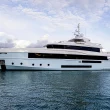
CROCUS Yacht: An 48 Meter Beauty by Admiral

PHI Yacht – Royal Huisman’s $45 Million Superyacht
- Zuretti Interior Design
- Zuretti Interior
- Zuccon International Project
- Ziyad al Manaseer
- Zaniz Interiors. Kutayba Alghanim
- Yuriy Kosiuk
- Yuri Milner
- Yersin Yacht
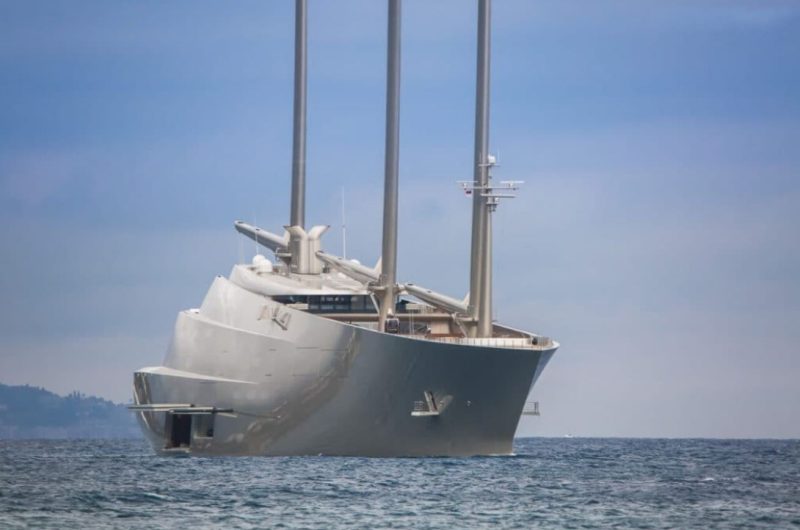
- Superyachts
SAILING YACHT A – World’s Biggest Sailing Yacht – $600 Million
SAILING YACHT A measures 143 meters making her the world’s biggest sailing yacht.
SAILING YACHT A is far more than a luxury vessel. She is a masterpiece of design and innovation combining sleek metal surfaces with futuristic naval architecture that took over two years to complete.
Launched in 2017, both the interior and exterior of this mega sailing yacht were designed by Phillippe Starck, who calls SAILING YACHT A one of his most high-profile projects.
The superyacht has taken on voyages all around the world and was most recently spotted sailing off the coasts of Gibraltar and Cyprus.
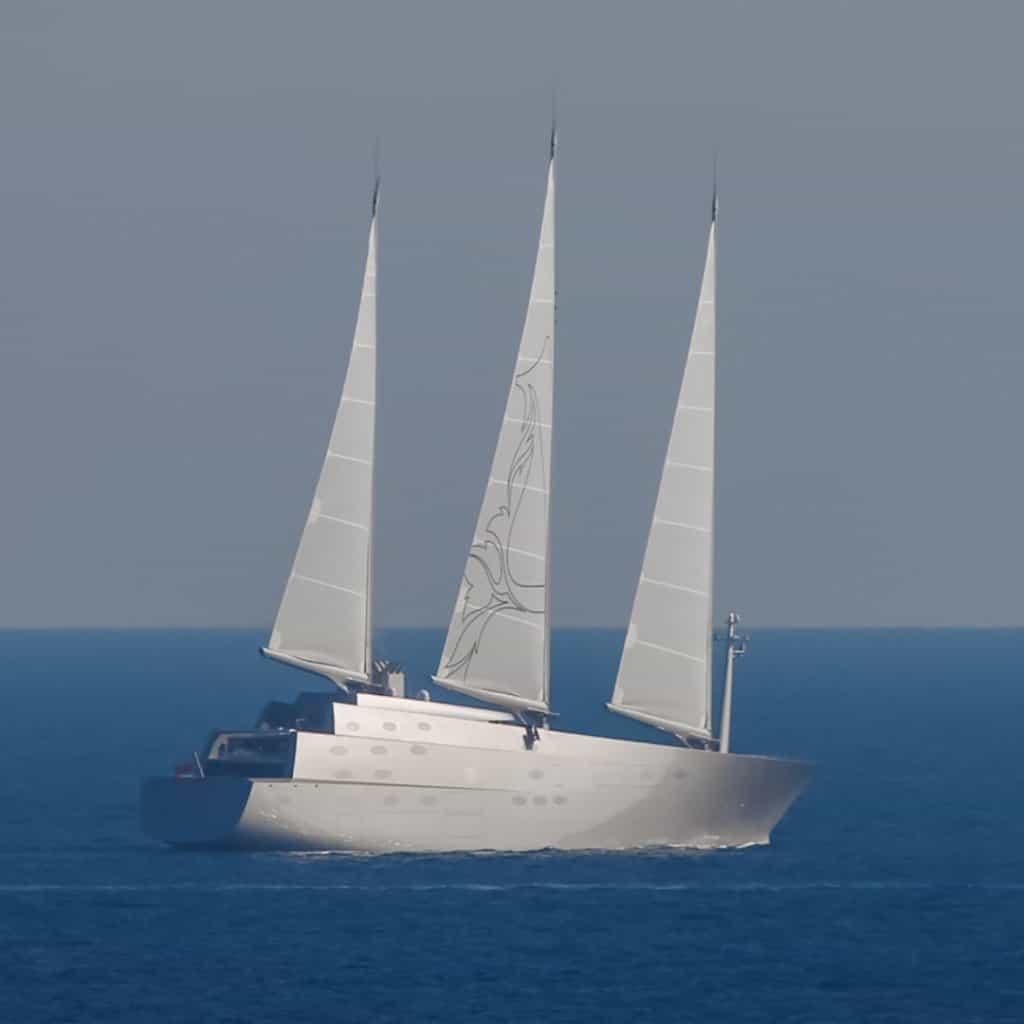
SAILING YACHT A interior
Both the interior and exterior of SAILING YACHT A were designed by Philippe Starck , a French architect known for his wide range of design projects.
He famously worked on the impressive MOTOR YACHT A, and the two iconic vessels share a lot of similarities in their layout and specifications.
Both yachts look incredibly futuristic and are sure to attract attention wherever they go.
While no exact details are known about the interior of SAILING YACHT A, it is rumored that she has an underwater observation pod with 30 cm (1 ft) thick glass located in the keel of the vessel.
This is one of the few parts where design mockups are publicly available, and the style of the interior can be examined.
The observation pod appears to have cream upholstery that stretches across the floor and ceiling of the cabin.
Two large symmetrical glass windows allow guests to view the breathtaking underwater world without even having to leave the yacht.
A third window is located at the bottom of the pod, which lets it feel like a true 360-degree experience and is almost comparable to a submarine.
A small floating side table provides guests with a space to place drinks or snacks in the pod and enjoy a one-of-a-kind dining experience in this unusual location.
Since the pod is located at the keel of the yacht, the large propellers are most likely visible from the windows suggesting it is most commonly used at anchor.
The superyacht has ten cabins that can accommodate 20 guests as well as a further 54 crew member.
Paparazzi photos and the work of yacht spotters provide a rare glimpse into the interior of SAILING YACHT A.
No official footage of cabins or salons has been released, although Starck’s past work suggests that the yacht would be furnished with opulent elements that perfectly combine luxury with style.
Silver and metal decorations play a large role and tie the interior design of the yacht together.
However, SAILING YACHT A was launched much later than her motorized companion suggesting her interior might be more modern with minimalistic elements rather than lavish furnishings.
Occasional photographs shot through open doors, and portholes show expensive art pieces decorating the interior of the yacht and rather absurd design choices like a set of chairs shaped like large human heads.
The yacht appears to feature a large, open salon with an elevated seating area and symmetrical arches on either side.
While details aren’t known to the public, it is rumored that SAILING YACHT A features a luxurious spa area, a sizable gym as well as an owner’s suite with several rooms that is only accessible via fingerprint.
The massive private area is said to feature a 60-inch television that disappears into the floor as well as a rotating bed.
Considering she is the largest sailing yacht in the world, it is surprising that SAILING YACHT A can only host 20 guests.
This suggests that there are spacious entertainment areas located on board, including several saloons and ample below-deck space for crew members.
Due to her large size and a small number of cabins, it is assumed that SAILING YACHT A can welcome a large number of day guests onboard for special events and celebrations.
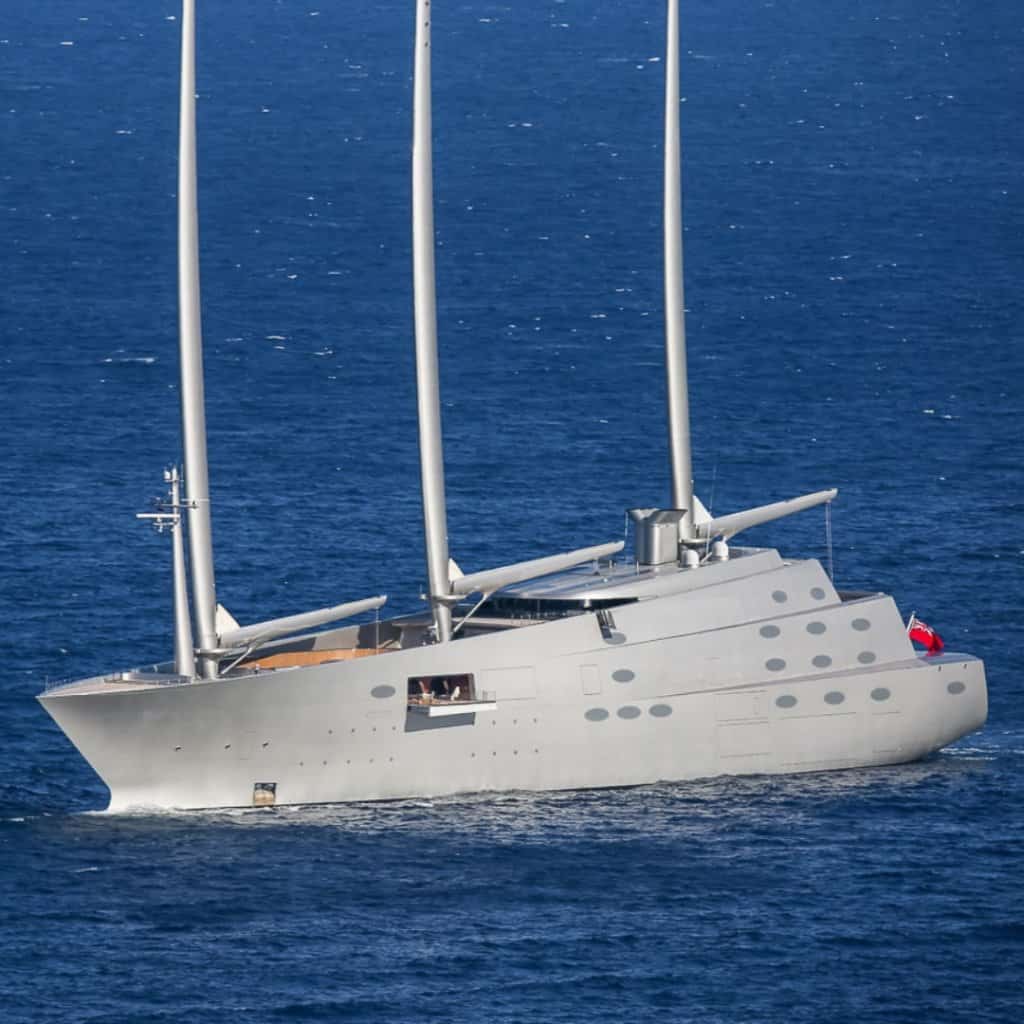
Biggest sailing yacht controversy
It has been the topic of debate that SAILING YACHT A is not the largest yacht in the world but instead the ‘largest sail-assisted motor yacht.
Depending on the definition used, that would make BLACK PEARL the biggest sailing yacht in the world.
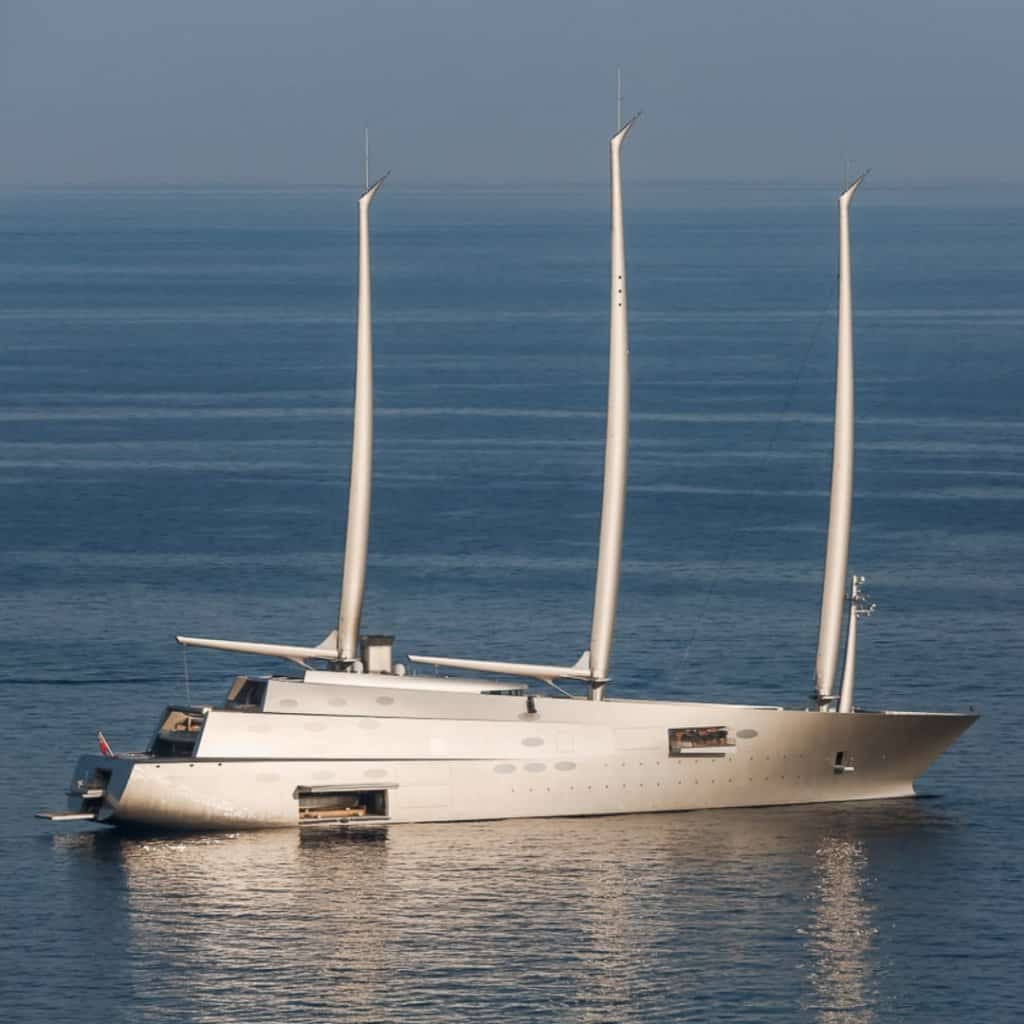
The most expensive sailing yacht
SAILING YACHT A is the most expensive sailing yacht in the world and cost an estimated price of US $600 million – a relatively “affordable” price considering her large size and tonnage.
A calculated US $48,000 per ton is considered low in the yachting industry, where European yachts are usually priced at US $60,000 per ton and over.
This average price would bring the value of SAILING YACHT A up to nearly US $800 million. However, due to the fact that the official sales price has not been released to the public, these numbers are mere estimates and cannot be validated officially.
Since the yacht is a custom project and one of a kind, it can be assumed that the total value of SAILING YACHT A lies far higher than her initial price.
In addition to any cost for the crew, supplies, and docking fees, she has annual running costs of US $50-75 million.
SAILING YACHT A is currently not available for sale or charter.
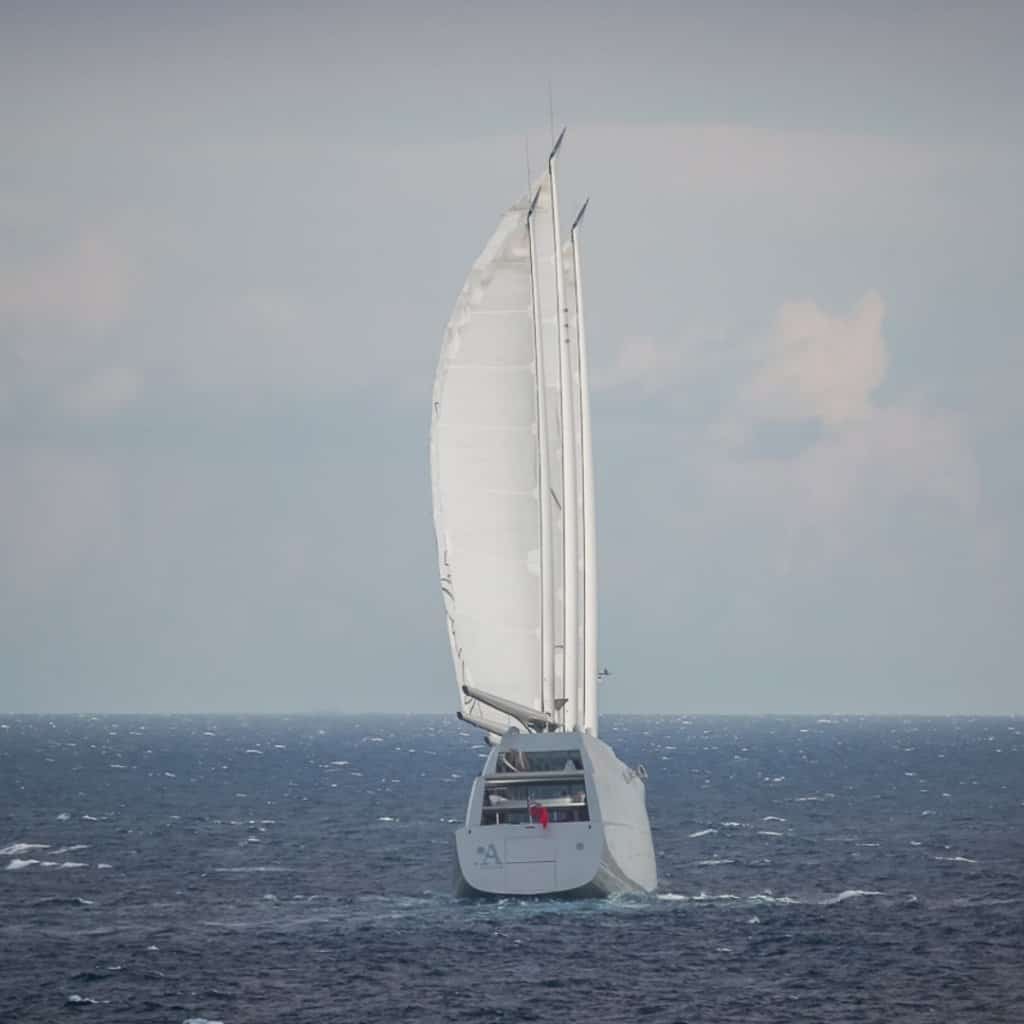
Specifications
SAILING YACHT A is incredibly large for a sailing yacht, and even compared to the longest motor yachts in the world, she would rank in the top ten.
Paired with her unusual futuristic design, this mega sailing yacht has a length of 143 meters (469 ft), a beam of 25 meters (82 ft), and a draft of 8 meters (26 ft) making her a more than an impressive vessel.
SAILING YACHT A was built by Nobiskrug , a German superyacht builder at their Kiel shipyard, and launched in 2017 after more than two years of construction.
To date, SAILING YACHT A is the largest yacht ever built by Nobiskrug and remains their flagship.
It is considered the most complicated project to ever be completed in the sailing industry and gained international media attention on its launch date. It has a total volume of 12.558 tons and is powered by hybrid diesel-electric engines.
SAILING YACHT A is considered the longest sailing yacht in the world and is more than 36 meters (118 ft) longer than BLACK PEARL, which ranks in second place on the list.
Coincidentally her project name was WHITE PEARL which is a reference to her brilliant white exterior, although it couldn’t have referred to BLACK PEARL since she was only launched in 2018, a year after Melnichenko’s masterpiece.
Her three-carbon masts stand at an impressive 100 meters (328 ft), making them some of the largest in the world and taller than Big Ben in London.
However, her large size is sometimes also limiting as she struggles to fit underneath most bridges and is therefore constrained to certain routes.
She once passed under the Golden Gate Bridge in San Francisco with only 20 feet to spare between her masts and the bottom of the famous bridge.
She is rumored to have an electric gimbal crow’s nest, which allows for remote operation and advanced wind measurements. Her sails are all white, and her masts have nearly sickle-like shapes, which add to her striking futuristic appearance.
It is noteworthy that she is commonly photographed with her sails down, which suggests she might be using her support engines more frequently than true wind power.
With a sail area of more than 3.700m^2 (40.000 square ft), she can reach top speeds of up to 21 knots which is supported by her twin 4895 Horsepower MTU engines .
Her average cruise speed lies at 16 knots, and her total range is estimated to lie at 5320 nautical miles. She features a state-of-the-art sail system that is able to raise and lower the sails and anchors at the touch of a button.
SAILING YACHT A has a steel hull and composite steel superstructure, which is unusual in the superyacht industry as most shipyards choose aluminum to reduce weight and keep the vessel light.
She currently sails under the flag of Bermuda, which is common for prominent sailing yachts.
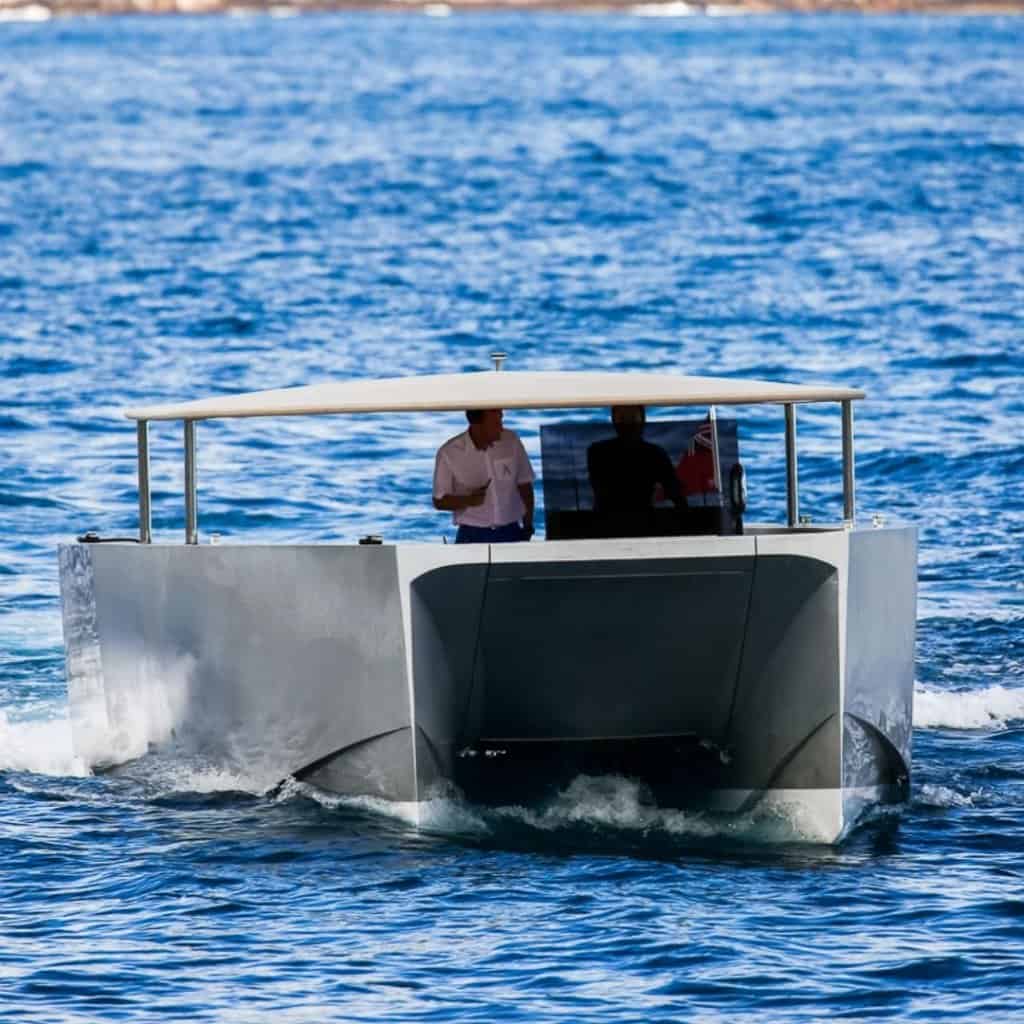
During construction, SAILING YACHT A was called project WHITE PEARL, a fitting name for this sizable vessel.
Like her interior, the exterior of SAILING YACHT A was designed by Philippe Starck, although the Dutch studio Dykstra Naval Architects played a role in the naval architecture of the vessel.
They specialize in sailing yachts of all sizes and have been involved in many prominent projects in the industry over the years.
She features eight teak decks with a large swimming pool located in the center and several elevators spread across the yacht.
She is even said to carry a submarine. The main pool is lowered into the deck allowing for additional privacy for the owners.
Her hull has 24 shell doors, which are used to access equipment and provide additional deck space if needed. She is accompanied by four tenders also designed by Philippe Starck and built by Lloyd Stevenson in New Zealand.
Their sleek and elegant design matches that of the main vessel, and they are used for transporting guests and taking them on excursions.
One of the tenders of SAILING YACHT A is a carbon fiber speedboat especially reserved for the owner who can operate the vessel autonomously whenever required without the aid of crew members.
This allows Melnichenko, who is a fan of driving high-speed cars to be independent when staying aboard his luxury yacht. The tender is small but powerful, reaching speeds of up to 53 knots.
The larger tenders can seat up to eight passengers and feature panoramic windows ideal for sightseeing and exploring but are much slower at only 30 knots.
The aft features a large garage used for storing jet skis, tenders, and other equipment.
High-profile artists such as Snoop Dogg are rumored to have performed here, although detailed evidence of such concerts remains unknown.
Whenever the aft isn’t used for performances or parties, it can be transformed into a swimming platform designed in the yacht’s iconic futuristic style.
However, despite her cutting-edge design features, SAILING YACHT A surprisingly also includes classic nautical elements. She has a wooden steering wheel that is reminiscent of a pirate ship, although it is not operational.
The captain of the vessel can instead use modern technologies to operate the massive yacht via a small joystick and touchscreen.
There are symmetric extendable balconies that protrude from the bridge of the yacht and allow the crew to have a better view to be able to gauge the dimensions of the immense vessel.
Of course, SAILING YACHT A has a modern underwater lighting system that illuminates the vessel perfectly at night.
Do you have anything to add to this listing?
- Phillipe Starke
- Reymond Langton Design
Love Yachts? Join us.
Related posts.
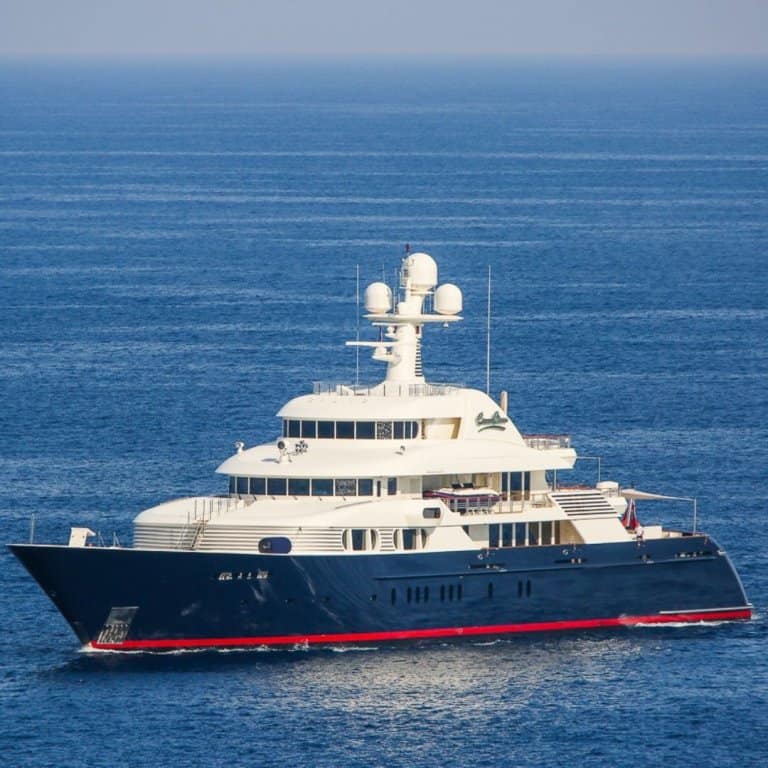
COCOA BEAN Yacht – Captivating $90 M Superyacht
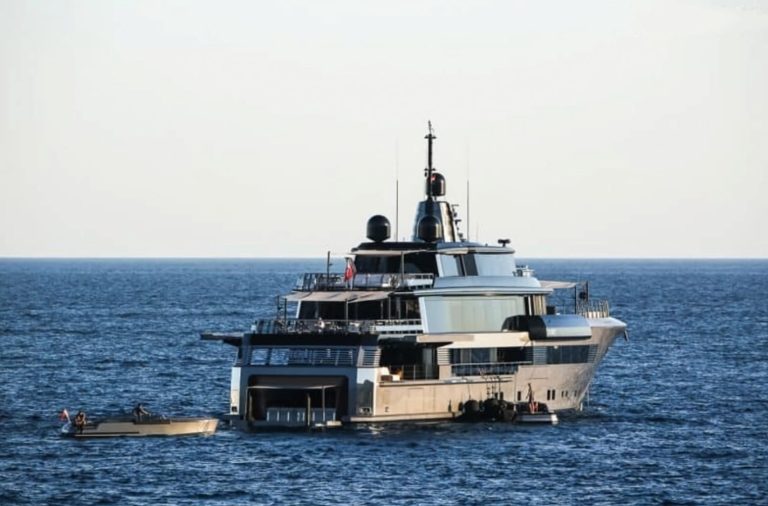
ATLANTE Yacht – Impeccable $40M Superyacht
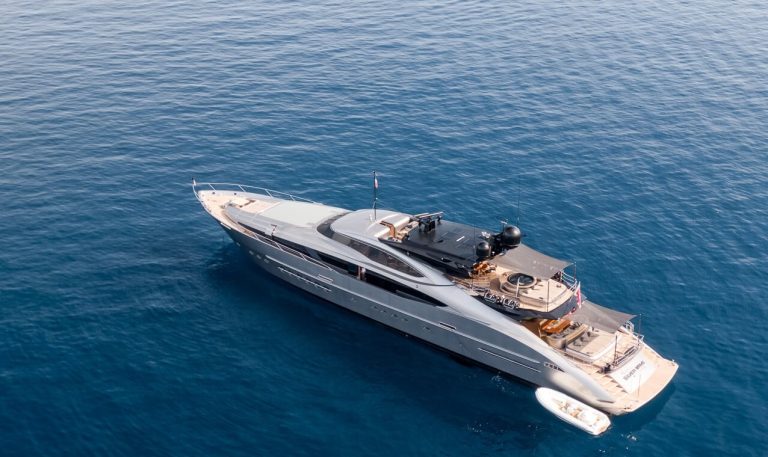
SILVER WAVE Yacht – Glamorous $20 M Superyacht
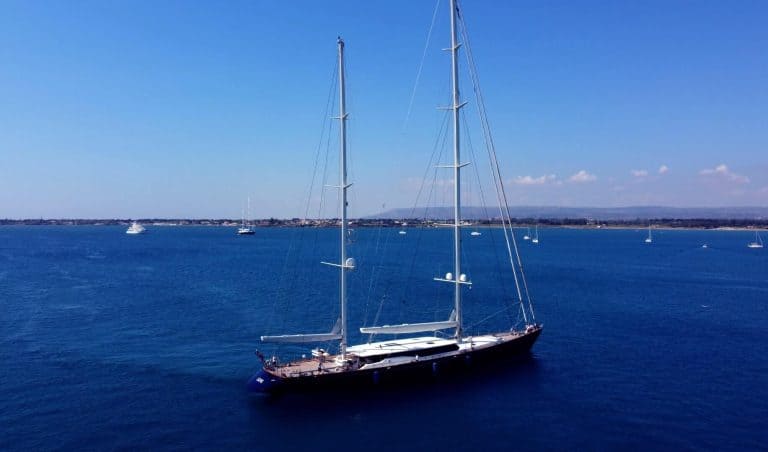
SQUALL YACHT – Inside the Amazing Perini Navi Sailing Yacht

Yacht Types and Sizes
Which yacht types and sizes exist in the world.
Are you curious which yacht types and sizes exist in the world? Spoiler: there are plenty!
In this article, we explore different types of yachts, such as motor yachts, sailing yachts, catamarans and trimarans.
We talk about their unique features, advantages and disadvantages.
We also cover the difference between serial, semi-custom and custom yachts and see which one is right for you.
Finally, we learn about how yacht size is measured and how it affects overall yacht volume and operations.
Let’s get started!
YACHT TYPES
If you consider buying a yacht, you need to decide on its type.
Which yacht type do you prefer: motor yachts, sailing yachts or catamarans?
These three categories are the most popular types of yachts, although there are also other ones.
Let’s look at each of them separately.
Yacht Types: Motor Yachts
Motor yacht is the most common type of a superyacht. Around 80% of world’s yachts are motor yachts.
These luxury boats are powered by strong engines, do not have sails and over time have become symbol of a classy and laid-back lifestyle.
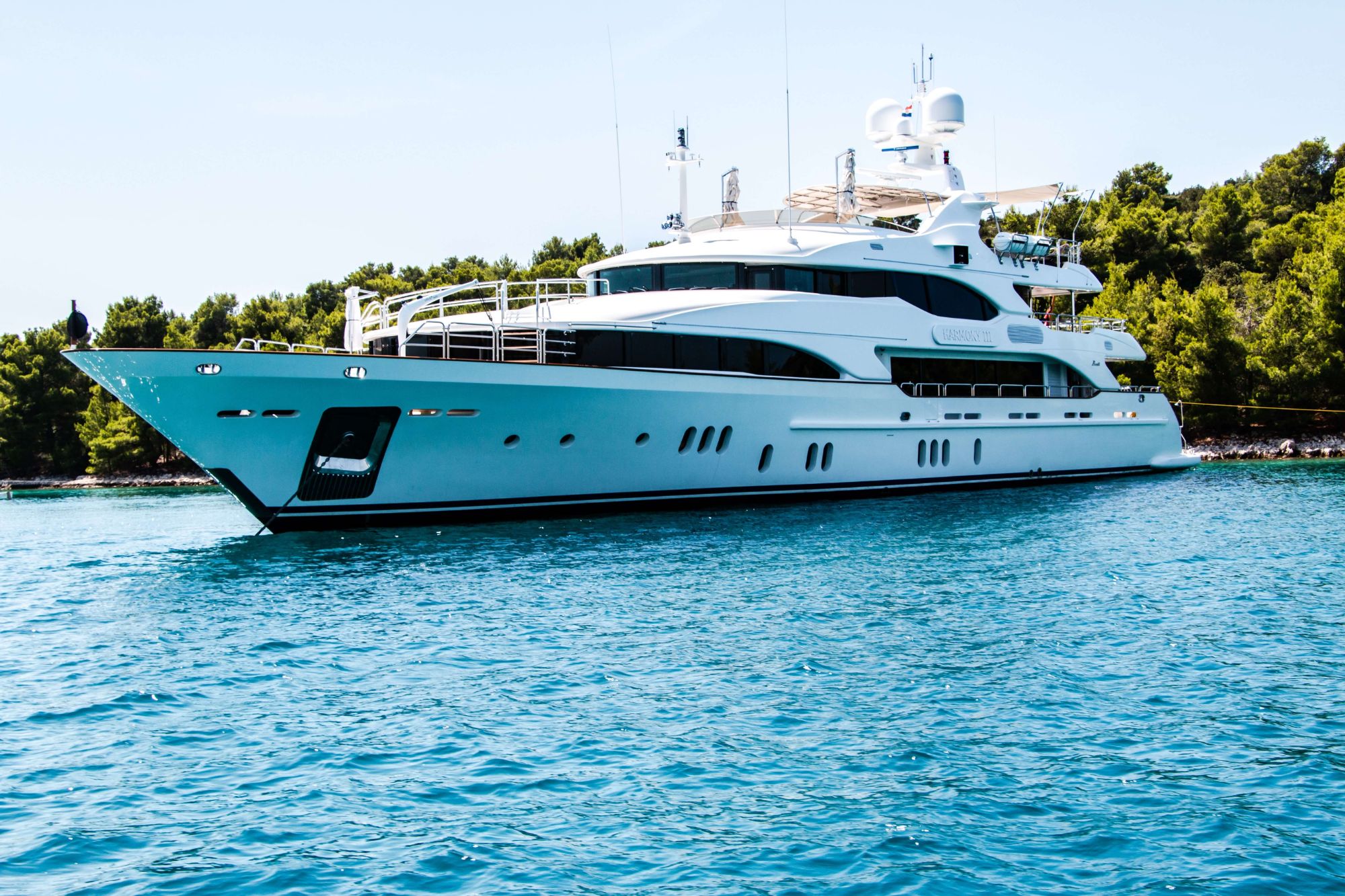
Pros of Motor Yachts:
- Powerful and fast
- Greater technological advances
- Greater deck space, more living volume
- Easier to find suitable crew members
- Easier to operate than a sailing yacht
- Easier to host guests of all personalities
Contras of Motor Yachts:
- Less sustainable, higher fuel consumption
- Less adventurous feel (if you are looking for it)
- Shorter range (can only be powered by motor)
- Engine noise
Motor yacht is probably the first thing which comes to your mind when you think superyachts.
Classy and sleek design, plenty of deck space, comfortable staterooms and lots of entertainment options – all this you can find aboard a motor yacht.
Motor yachts come in different types and sizes and with different purposes. The latest trend is explorer motor yachts, which are explicitly equipped for cruising in cold polar regions.
Yacht Types: Sailing Yachts
Sailing yachts are the second most popular yacht type. If you love the wind and want that classy sporty feel while aboard, then a sailing yacht is the right yacht type for you.
Another advantage is that when not powered by motor, sailing yachts are very quiet. It is only the sound of waves and wind (and an occasional seagull) around you.
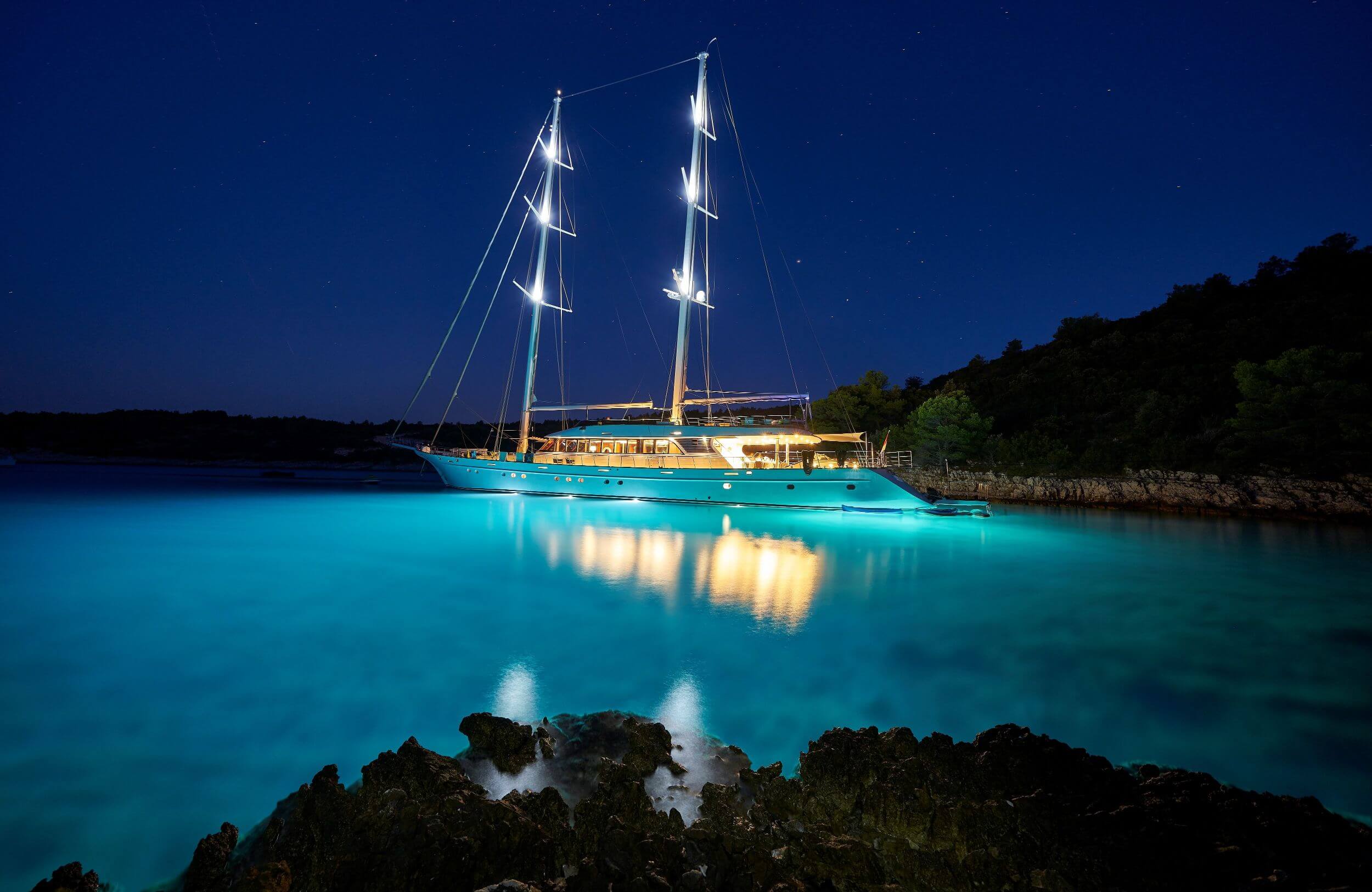
Pros of Sailing Yachts:
- Unique feel of adventure
- Can combine peaceful cruise with racing
- Very quiet when powered by sail
- Lower fuel consumption
- Lower maintenance cost
- Can sail in shallower waters
Contras of Sailing Yachts:
- Tend to be slower that motor yachts (in case you like speed)
- Less stabilization
- Smaller cabin space
- Might have less lifestyle equipment available (Jacuzzi, gym, cinema) …
There are only two types of people out there: sailing yacht fans and motor yacht fans. Rivalry between fans of the two yacht types has become legendary.
Probably, you already know which group you belong to. Nevertheless, we still recommend you charter both sailing and motor yachts to be sure you are making the right choice. If you are still unsure, read about the third yacht type below.
Yacht Types: Catamarans
Catamaran is defined as a vessel with two parallel hulls which are joined together. Due to its form, catamaran is the most stable of all yacht types.
If you are looking for stability and comfort, or have family members who easily get seasick, buying a catamaran is a valid option to consider.
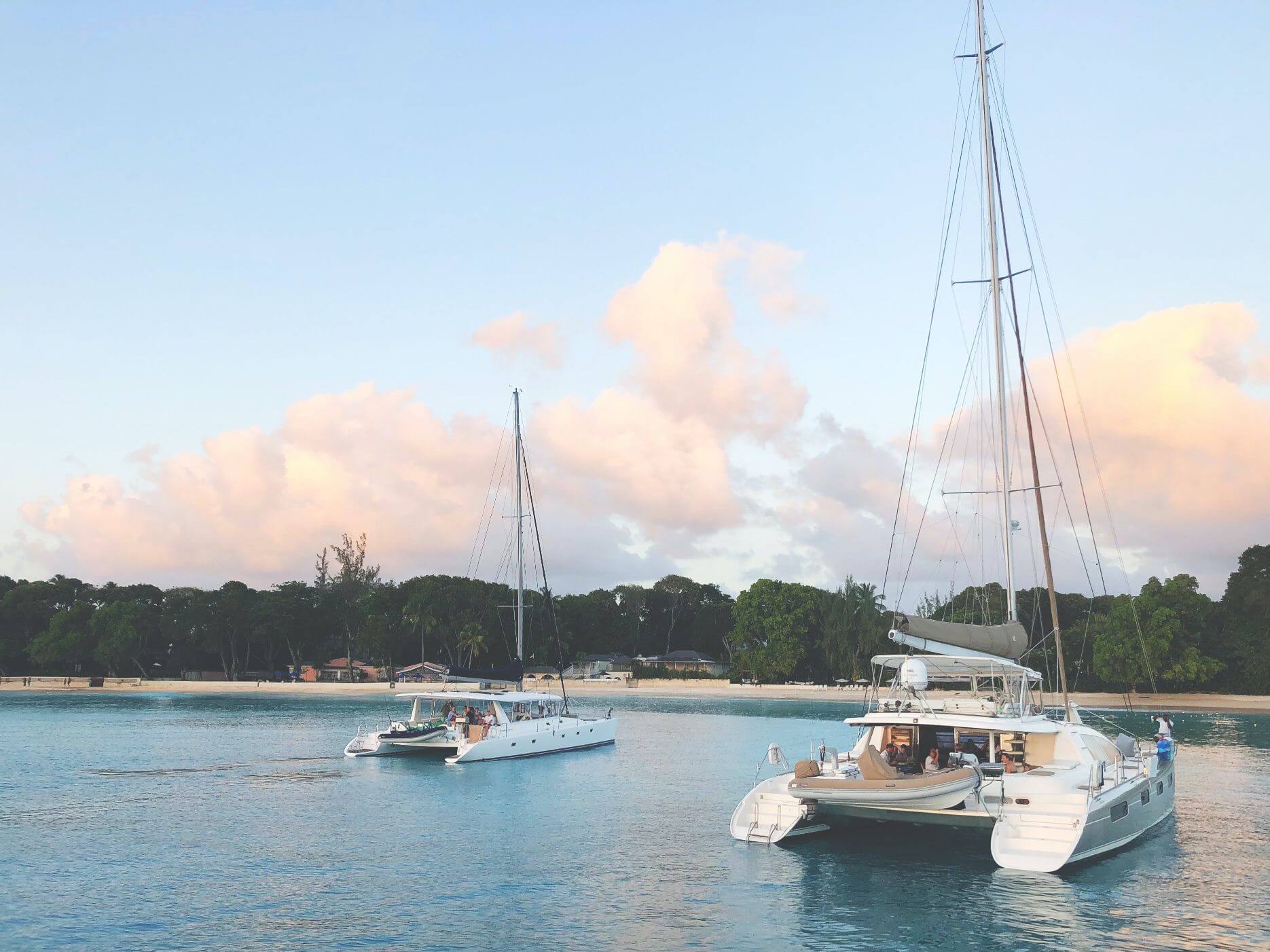
Pros of Catamarans:
- More fuel efficient & sustainable
- More stability
- Can be used in shallow waters
Contras of Catamarans:
- Less volume for staterooms
- Higher dockage rates than for a monohull
- Different sailing feeling compared to a sailing boat
Catamarans offer a great opportunity for taking family vacations, which will leave every family member happy. Since they are more difficult to sink, they are also considered the safest boats.
If you are looking for extra stability, comfort and space, but also do not want to compromise on adventures and possibility to explore shallow waters, catamaran is right yacht type for you.
Yacht Types: Trimarans
Big brother of a catamaran, a trimaran, has even three hulls – one main hull in the center, and two smaller hulls on each side.
You will not see them as often, but there are certainly also big fans of trimarans out there. Trimarans are designed for racing or leisure but are also widely used for military and shipping purposes.
YACHT PRODUCTION TYPES: SERIAL, SEMI -CUSTOM, CUSTOM YACHTS
Now that we’ve covered yacht types, let’s investigate which production options are out there. Unlike the automotive industry where most of the car models come from production lines, the yachting world offers future owners more possibilities.
SERIALS YACHTS
This is the most common and less expensive way to get to your new dream boat. Serial or production yachts are yacht models which are produced by shipyards in various quantities based on model and size.
Serial does not mean that you cannot tune it to your taste though. Manufacturers offer different sets of modifications with certain yacht models. You will likely get to choose between several layout models and different equipment options.
Obviously, if you order a newly build yacht, you are likely to get more space for your improvements, than if you decide to refit an already existing yacht.
SEMI-CUSTOM YACHTS
A good way for owners who wish more character and comfort to their boats but at the same time do not want to order a fully customized vessel, is to order a semi-custom yacht.
Semi-custom yachts stand between serial and fully customized boats. You save a lot of time and effort by picking an existing engineered platform from which to start planning.
Then, together with experienced naval architects and designers, you enhance it up to your expectations by customizing layout (possibly including superstructure) and interiors.
Ordering a semi-custom yacht gives you more freedom to decide how your yacht will look like. Construction time is also much shorter in comparison with a fully customized yacht, since many parts are already designed, engineered and possibly even pre-built.
By ordering a semi-custom yacht, you can shorten construction time from two – three years up to several months!
Shipyards are also less likely to fall behind the delivery schedule, since they have produced similar yachts before and know which time is needed for delivery.
Most semi-custom yachts are designed to suite majority of potential future owners, which means that layout, size, engineering etc will be well thought-through in advance.
Due to extensive previous testing & refining of semi-custom hulls by the shipyard, it is possible that your new yacht will turn out more reliable and problem-free than a fully customized yacht.
CUSTOM YACHTS
If you wish to be unlike anybody else and want to take your dream a step further, a fully custom-built yacht is exactly what you need.
Almost anything is possible and achievable in today’s superyacht building industry. The only considerations are your budget and international safety and security standards, more on which you can read in our article on Safety and Security Onboard Superyachts.
With a custom-made yacht, you can be sure you will get exactly the boat you want, tailored just for your preferences, no other yacht in the world being similar.
Consider longer delivery time and substantially higher cost, since R&D expenses are not shared between yachts of the same series.
Many owners buy a smaller replacement yacht, while they are waiting for their customized dream boat to leave the docks.
A fully customized superyacht is surely the most exclusive type of a yacht one can own.
Yacht Sizes
Now let’s look at different yacht sizes. But first, let’s find out what yacht size actually is.
How is yacht size measured?
Length Overall (LOA) is the most widely used metrics of yacht length. It is measured from the aftmost tip of the hull to the furthermost point of the stem, measured parallel to the waterline. It is probably the only yacht length definition you need to know as an owner.
*For yachting geeks out there, here are other yacht size definitions used in the industry:
Length of Deck (LOD) : deck length excluding bow sprits and other projections. Makes particular sense for sailing boats, since their Length Overall can considerably vary from their Length of Deck.
Length of Hull (LH or LOH): Length of hull including fixed fendering but excluding any bow sprits. It can be shorter than LOA.
Length of Waterline (LWL): length of a boat at the level where the boat sits in the water.
Interesting fact: Did you know that with each additional 1 meter of length, the internal volume of a yacht increases by 6-7 cubic meters? A 40-meter yacht is not just twice longer than its 20-meter companion. According to Cube Law, it is also 6-7 times larger in volume!
Motor yacht sizes by group
Let’s look at different sizes of motor yachts. To make things easier, we divided them into 4 groups.
Please note that the following crew and guest numbers per yacht size are only approximate.
Factual crew numbers will depend on specific yacht length, cruising style, owner preferences and whether the yacht charters or not.
Factual guest numbers will depend on yacht registration type, especially with larger yachts.
22 – 40 meter motor yachts
Motor yachts in of this size are most likely serial production yachts. This means that you can buy a specific yacht model which has been designed before, and choose your own details, such as finishings and furniture.
Yachts of this size will need 4-6 crew members: yacht captain, one or two deckhands, one or two stewardesses, a yacht chef, and presumably an engineer.
22-40 meter long motor yachts normally can host up to 8 guests.
40-60 meter motor yachts
Motor boats of 40 meters length and larger are considered superyachts also within circles of superyacht industry professionals.
This is where operations and crew requirements become considerably more sophisticated. There are also more semi-custom and custom boats in this size segment.
A 40-50 meter motor boat will require a crew of approximately 9-13 crew members, depending on specific owner requirements and cruising / charter preferences.
A possible crew setup would be: yacht captain, first officer, bosun, two engineers, three or two stewardesses, two deckhands, one or two chefs (often a guest and a crew chef).
Crew of a 60 meter motor yacht will count around 20 members.
40-60 meter long motor yachts normally can host up to 12 guests.
60 – 80 meter motor yachts
Here the yachts grow much larger, and so do the costs of maintenance.
A yacht of 60 meters length will have a crew of 20-23 members. A yacht of 80 meters length can have a crew of up to 80 members.
The maximum number of guests will depend on yacht registration type. Many owners choose to keep maximum of 12 guests, since it allows for a simpler regulation regime.
80 – 180 meter motor yachts
A 100 meter motor yacht will require 80-100 members crew. Its tonnage will exceed 500 GT, which means that the yacht will fall under more regulations: STCW, SOLAS, ISSC, ISM and others.
A 170 meter motor yacht can have up to 100 crew members.
The largest yacht worldwide at the time of writing is Azzam, at 180 meters built by Lürssen. Azzam can host 36 guests and a least 80 crew.
Maximum guest number on a yacht of this size can still be only 12 guests. But if the yacht is registered as a passage vessel, it can be significantly more.
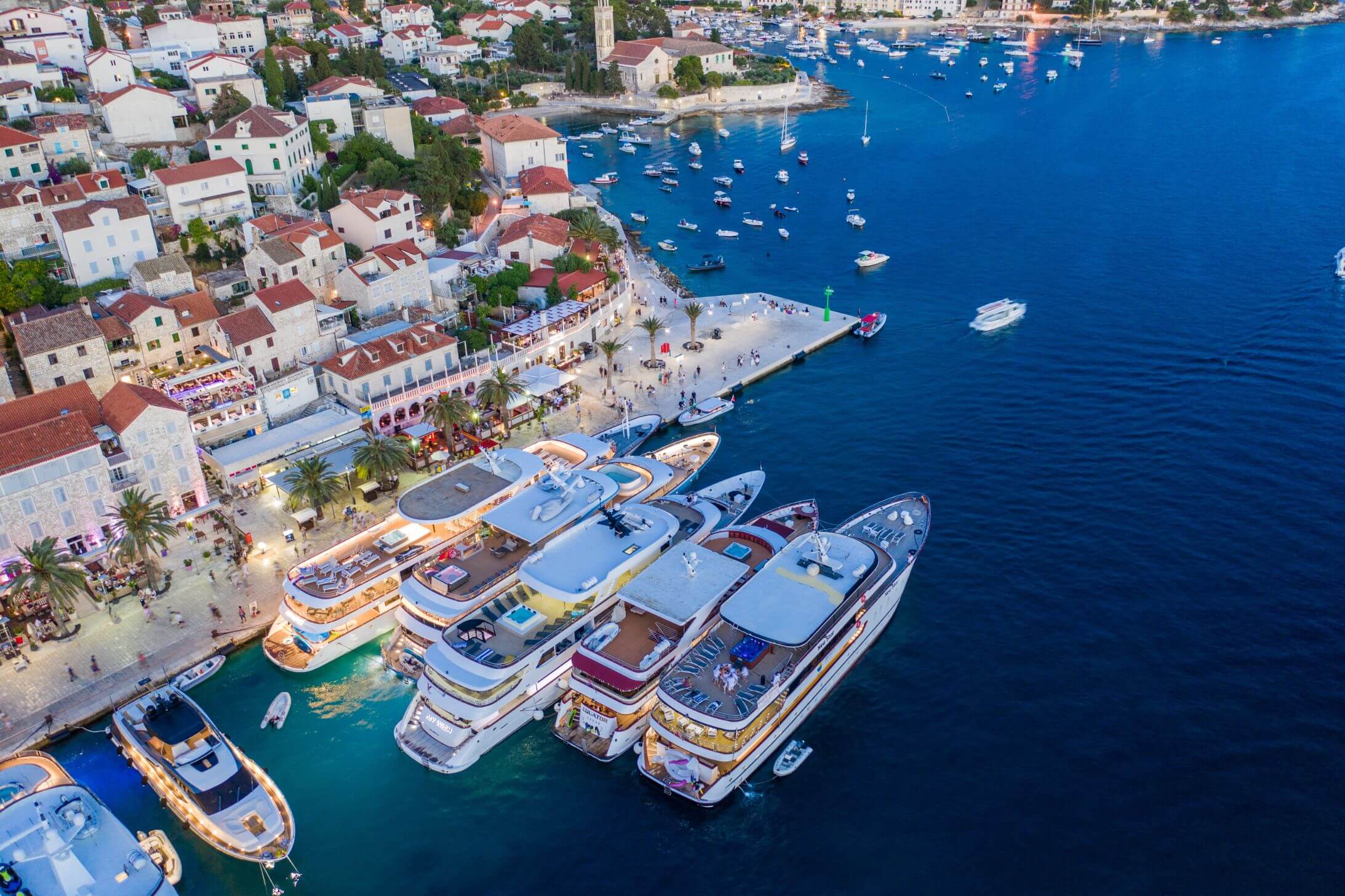
How does yacht size affect my yachting experience?
Size does matter after all.
Let’s look at factors that change with the growing size of a yacht.
While thinking of upgrading to a bigger vessel, do not forget that as the yacht size grows, following factors also increase:
- Yacht price
- Availability and price of marina dockage
- Fuel consumption
- Number of full-time crew members
- Time you can spend away from ports
- Quantity of water and other supplies the yacht can carry
- Functionality and entertainment options
- Complexity of repairs
- Applicability of laws & regulations
- Time needed to sell the yacht
Budget is the main factor which determines how big your boat can be. To learn more about the cost of yacht ownership, read this article.
During the past decade, superyachts increased in size dramatically, and this trend continues. According to an article by Boat International, there has been around 10.000 yachts over 24-meter LOA in the world. Around 80% of them were motor yachts.
Most of the owners start small and upgrade their boats over years. Once you owned a smaller yacht for some time, you will understand exactly what you love about it.
Also, you will know what you want to improve. So why not initiate a new-build of a new more exciting and possibly larger boat? You can still have the older yacht at your disposal, while waiting for the new delivery.
SUMMARY: YACHT TYPES AND SIZES
In this article, we classified all yachts into 3 main types: motor yachts, sailing yachts & catamarans. We also discussed their pros & contras.
We explained the difference between serial production, semi-custom and custom yachts.
Finally, we learned how yacht size is measured and how it affects various aspects of yacht operations. We looked at crew and guest numbers for each yacht size.
Another important factor to consider is whether you want to commission a new-built yacht or buy a second hand one . More on this in our next article .
Drop us an email if you need help with choosing a yacht or booking a yacht charter. We will define your needs and find the best solution together.
Are you a motor yacht, sailing yacht, or catamaran fan?
Comment below!
Article by Olympiada Wohlin-Elkovsky from Yachtowner.co
More Articles
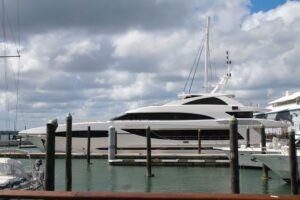
Superyacht Management
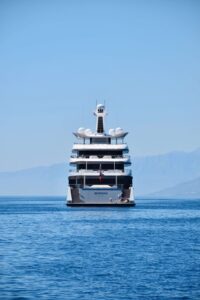
Comprehensive List of 193 Superyacht Brands
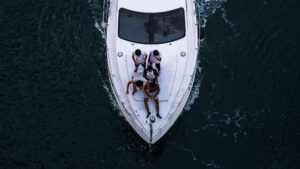
Superyacht Websites List

Superyacht Brokers List
Leave a reply cancel reply.
Your email address will not be published. Required fields are marked *
Save my name, email, and website in this browser for the next time I comment.
Yes, add me to your mailing list
Privacy Overview

The Healing Powers Of Hot Springs Unlocking The Magic Of Hot Springs

6 Surprising Factors Behind Inflated Cost Of Goods In Airports

Here’s Why Public WiFi Could Be Your Downfall

What London Borough Is The Best Base For A Weekend Trip?

Overcome Travel Challenges With These Helpful Tips

Best Places To Visit In April In India
Sorry, but nothing matched your search " ". Please try again with some different keywords.
A Beginner’s Guide To Understanding Yacht Types And Sizes
Feb 13, 2023
Travel Guides
When it comes to buying a yacht, there are many different factors to consider.
One of the most important is understanding the various types and sizes of yachts available on the market. With so many options to choose from, it can be overwhelming for a first-time yacht buyer.
This beginner’s guide will help you understand the different types of yachts and their sizes, so you can make an informed decision when buying your first yacht .
Before we dive into the different types and sizes of yachts, it’s important to have a good understanding of what is available on the market. To get started, check out a list of yachts for sale in various locations . This will give you an idea of the types of yachts that are available and their prices.
Yacht Types
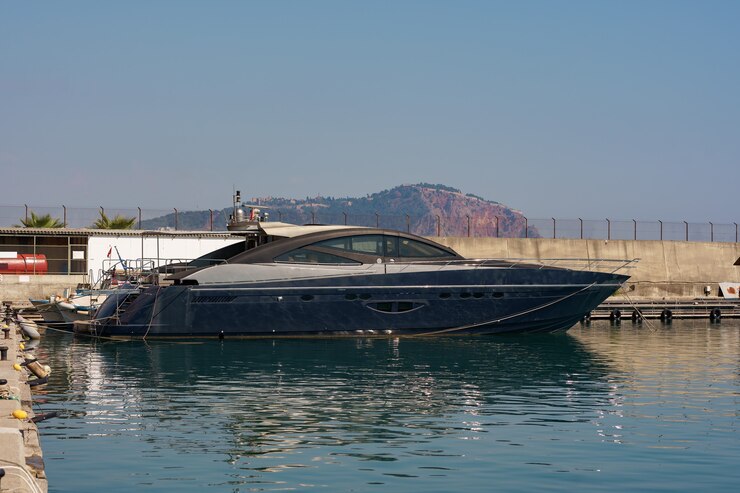
1. Motor Yachts
Motor yachts are powered by engines, and they are designed for luxury cruising. They come in a variety of sizes and styles, ranging from smaller, more intimate vessels to larger, more spacious yachts that can accommodate several guests.
2. Sail Yachts
Sail yachts are powered by the wind and are perfect for those who want a more adventurous boating experience. They are typically larger than motor yachts and offer more space for guests to relax and enjoy the scenery.
3. Catamarans
Catamarans are two-hulled vessels that are known for their stability and comfort. They offer spacious cabins, large outdoor areas, and plenty of room for guests to relax and enjoy the surroundings.
4. Power Catamarans
Power catamarans are similar to catamarans, but they are powered by engines. They are perfect for those who want the stability of a catamaran, but with the speed and convenience of a motor yacht.
5. Trawlers
Trawlers are designed for long-distance cruising and are known for their spacious interiors, comfortable cabins, and excellent fuel efficiency. They are perfect for those who want to explore distant destinations and enjoy extended periods at sea.
Yacht Sizes

A. Small Yachts
Small yachts are typically less than 40 feet in length and are perfect for short trips and intimate gatherings. They are ideal for those who want a simple, low-maintenance vessel that is easy to handle.
B. Mid-Size Yachts
Mid-size yachts are typically between 40 and 80 feet in length. They offer more space and amenities than small yachts, and they are perfect for those who want a comfortable and spacious vessel for extended trips.
C. Large Yachts
Large yachts are typically over 80 feet in length and offer an unparalleled level of luxury and comfort. They are perfect for those who want the ultimate boating experience, with spacious cabins, large outdoor areas, and top-of-the-line amenities.
Perks Of Buying A Yacht
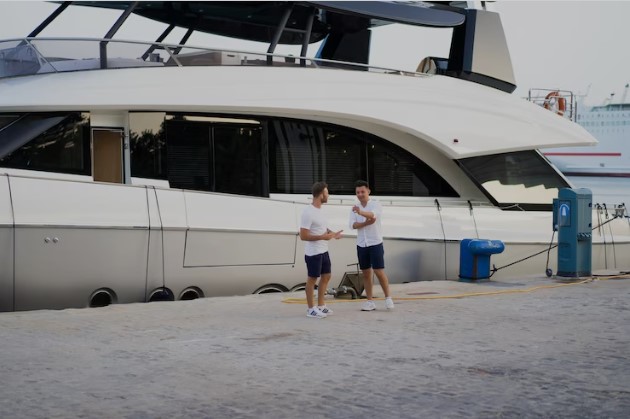
1. Freedom and independence
With a yacht, you have the freedom to travel to any location you choose and set your itinerary. You have the independence to spend time on the water and explore new and exotic destinations.
2. Privacy and exclusivity
Yachts offer a level of privacy and exclusivity that is difficult to find on land. You can escape the crowds and enjoy your own space, away from the hustle and bustle of everyday life.
3. Luxury and comfort
Yachts are designed for luxury and comfort, with high-end amenities and spacious living quarters. You can relax in comfort and style, and enjoy all the amenities you would expect from a five-star hotel.
4. Adventure and excitement
Owning a yacht opens up a world of adventure and excitement. You can go fishing, diving, and exploring, and experience new and exciting destinations.
5. Increased social status
Owning a yacht is often seen as a symbol of success and social status, and can be a great way to network and make new connections.
6. Investment Opportunity
Yachts can also be a wise investment, as they often hold their value over time and can generate rental income if you choose to charter your yacht.
7. Quality family time
Spending time on a yacht can provide quality family time and create unforgettable memories. It’s a great way to bond and connect with loved ones while experiencing new and exciting destinations.
There are many beautiful places you can visit on a yacht, depending on your preferences and interests.
Listed Below Are Some Of The Destinations That Are In High Demand:

A. Mediterranean
The Mediterranean is one of the most popular yacht destinations in the world, offering stunning scenery, warm weather, and a rich cultural heritage. You can visit countries like France, Italy, Spain, Greece, and Turkey, and experience their unique history, architecture, food, and wine.
B. Caribbean
The Caribbean is a popular destination for yacht enthusiasts, offering crystal-clear waters, white sand beaches, and a warm and relaxed atmosphere. You can visit islands like the Bahamas, Barbados, Saint Lucia, and the Virgin Islands, and enjoy activities like snorkeling, diving, and island-hopping.
C. Maldives
The Maldives is a breathtaking destination for yacht enthusiasts , offering a remote and unspoiled environment, with pristine beaches, vibrant coral reefs, and abundant marine life. You can explore the atolls, relax in the sun, and enjoy the tropical paradise that is the Maldives.
D. South Pacific
The South Pacific is a popular destination for yacht enthusiasts, offering a remote and exotic environment, with lush tropical landscapes, turquoise waters, and abundant marine life. You can visit countries like Fiji, Tahiti, and the Cook Islands, and experience their unique culture, history, and natural beauty.
E. Thailand
Thailand is a popular destination for yacht enthusiasts, offering stunning beaches, tropical landscapes, and a rich cultural heritage. You can visit the famous islands of Phuket, Koh Samui, and Koh Phi Phi, and experience their stunning scenery, vibrant nightlife, and tropical paradise.
When it comes to buying a yacht, understanding the different types and sizes of yachts is essential. From small and intimate vessels to large and luxurious yachts, there is a type and size of yacht that is perfect for everyone. With this guide, you will be well on your way to making an informed decision when it comes to buying your first yacht.
- Travel To Turkey
- 12+ Best Hamilton Island Restaurants: Must Visit In 2023!
- Top Luxury Escapes Bucket List Ideas For Wanderlust Jetsetters
- buying a yacht
- convenience of a motor yacht
- first-time yacht buyer
- luxury yacht
- luxury yacht charter
- sizes of yachts
Share on Social Media
Arnab Day is a passionate blogger who loves to write on different niches like technologies, dating, finance, fashion, travel, and much more.
Leave a reply cancel reply.
Your email address will not be published. Required fields are marked *

How Far Is Tampa From Miami? – A Detailed Travel Guide

Eco-Travel: Exploring The World With A Hybrid Car

Quality Traveling: Use Your Free Days To The Fullest

Top Five Treks in Nepal
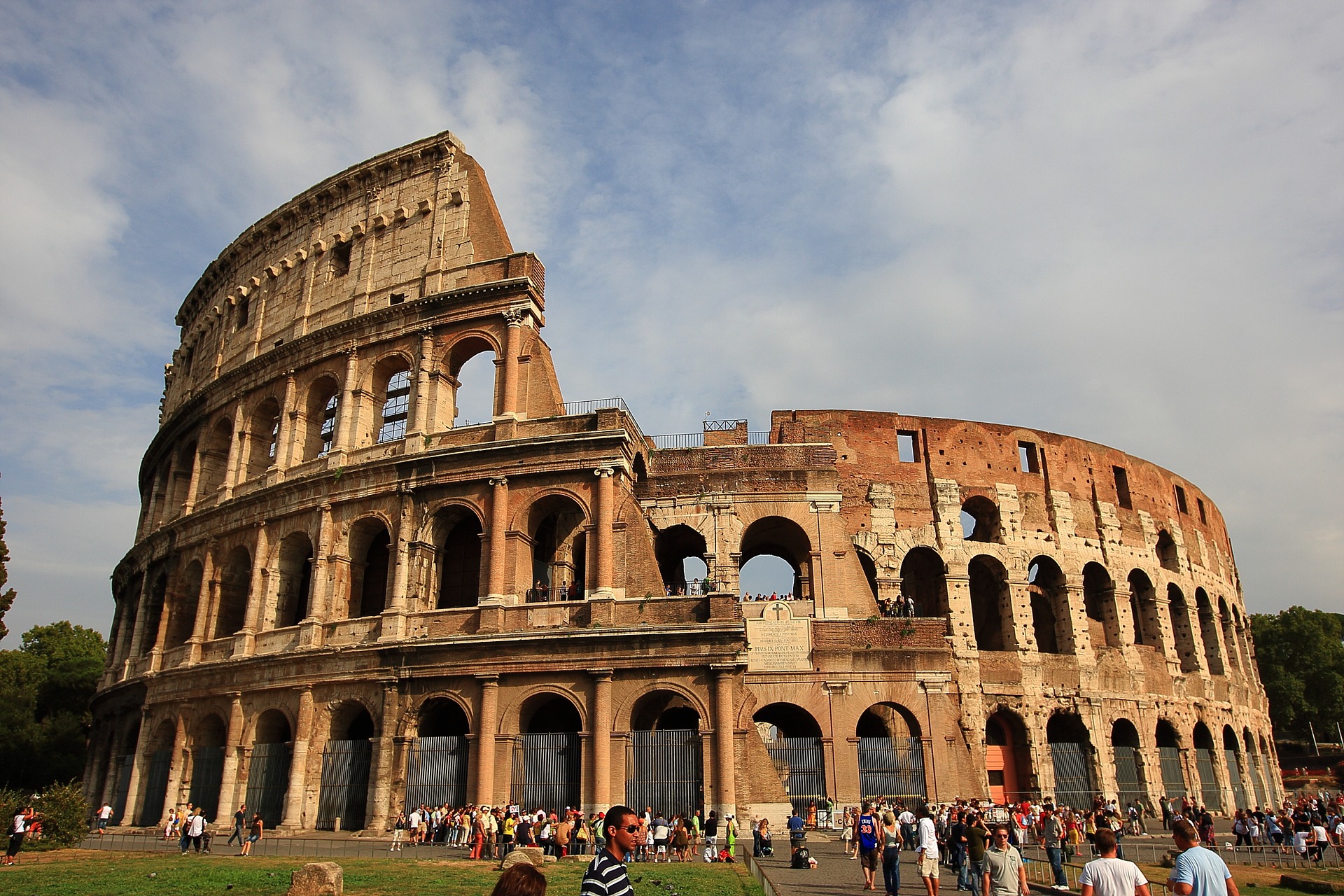
The New Seven Wonders of the World

10 Famous Temples in South India for a Spiritual Journey

Top Sahara Desert Countries You Should Visit
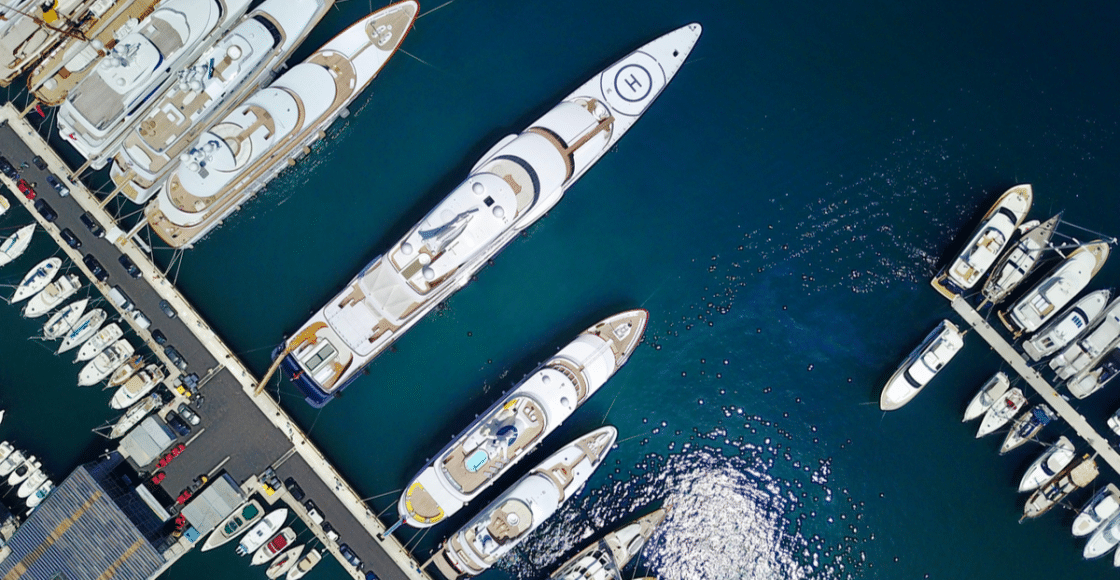
What Size Yacht is Best For You – Ultimate Guide to Choosing a Yacht

Table of Contents
Choosing a yacht is sometimes just as complicated as choosing a new car, if not more. Besides, choosing a yacht is often a lifetime investment, unlike our vehicles which have a shelf life of around 30 years at best. By understanding your preferences, educating yourself on your choices, and testing out some options, you can make an educated decision before making a purchase. Buying a yacht is not something you want to jump into without first weighing out your options.
The size of the yacht you choose will most certainly be an individual decision based on your goals and budget. From going to expos and boat shows to online forums, there’s no shortage of places to get information about yachts. It’s important to gain as much information as possible before making your final decision. This ultimate guide to choosing a yacht will ease the process of figuring out exactly what size yacht is best for you.
Preferences
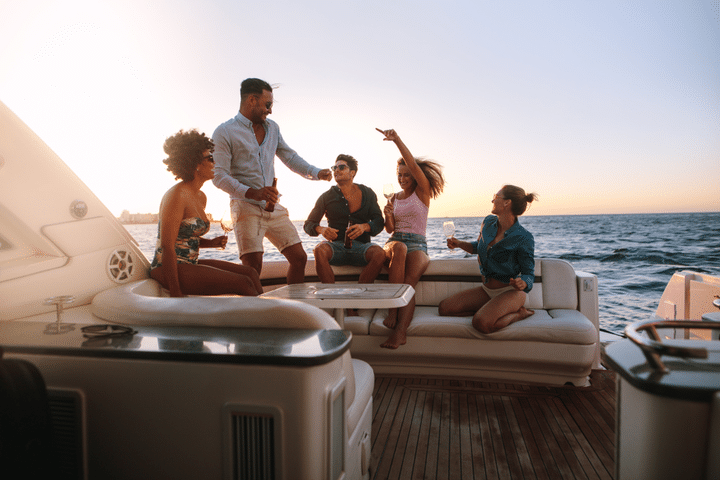
The first step you need to take when deciding on what size yacht is right for you is making a list of preferences. Take some time to think about what’s important to you. What kind of boating will you primarily be doing? Once you’ve figured out your preferences, the decision-making process becomes a whole lot easier. By eliminating choices that don’t fit your needs, you are left with a shortlist of good options.
What will you be using your yacht for most of the time?
This is an important question to ask yourself. Will you be spending multiple nights at sea with your entire extended family? Or will you mostly be making daytime fishing trips with your buddies? The size of your yacht will vary greatly depending on what end of the spectrum you’re on.
How many guests would you like to accommodate?
As with the above question, it’s important to figure out exactly how many guests you’d like to have onboard at any given time. While you may be getting your boat for intimate family trips, you may want to consider something bigger if you’re thinking of hosting birthday or bachelor parties.
What is your budget?
It’s a good idea to look at the short-term and long-term costs when deciding on what size yacht is right for you. Once you’ve made the initial purchase, the price of owning a yacht doesn’t end there. A bigger yacht will ultimately cost you more in transport, storage, operating, maintenance and repairs. This is also a good time to look into insurance and registration fees associated with owning a yacht.
Are you on board with buying something used?
If your preferences aren’t quite aligned with your budget, purchasing a pre-owned yacht may be a good option if you can’t find the right size in your price range. Just like buying a used car, buying a second-hand boat comes with both benefits and risks. Buying from a dealer will usually come with some sort of warranty, whilst purchasing a boat from a private seller could cost you considerably less.
Education

When deciding to take the plunge and buy a yacht , one of the crucial steps you need to take is educating yourself on the types and sizes of yachts available on the market. For most enthusiasts, buying a yacht isn’t a quick decision. Finding out exactly what’s out there will help you narrow down your choices. It’s easy to get distracted when researching online; the key is staying focused and take notes.
Do your research:
By this time, you’ve probably got an idea of the size and style you’re leaning toward. Find out if there are any boat shows, expos, or dealerships in your area. This is also a good opportunity to look up the registration requirements and insurance options, even if it’s just to get an idea of what to expect. There is so much information out there; fine-tune your focus and learn all you can.
Visit some of the local boat dealers in your area: Going to the dealership and looking around can give you valuable information about the yacht you’re thinking of purchasing. Most dealerships have experienced salespeople working who can answer questions and give recommendations. Additionally, most boat dealers will let you take tours of the yachts in their showroom.
Join social media groups or online forums:
Joining online yacht groups like those on Facebook and Twitter is a great place to seek answers when deciding on the right size yacht. Most yacht groups have some knowledge on the subject. The same goes for online forums like Reddit and Quora; a wealth of information at your fingertips if you ask the right people the right questions.
Subscribe to yacht and boating magazines :
Whether in print or online, subscribing to magazines like Yachting Magazine can give you up-to-date information on yachts and sailing. Subscriptions like Passagemaker even have a classifieds section for buying and selling boats. You don’t have to join a magazine club to get the most out of yachting-related publications; take a look online to see what sparks your interest and only subscribe to a few.
Check the ratings and reviews:
It doesn’t make sense to purchase a yacht with poor consumer reviews, especially if it’s due to mechanical issues. Many first-time yacht purchasers will think they found the perfect boat at a steal of a price; this would be a good time to check the reviews for that particular boat. Asking friends, club members, and online forums what the pros and cons are of owning a yacht of their particular size can give you a more personalized review.
Attend a boat show:
Boat shows, like visiting a dealership, allow you to check out potential yachts and sizes as well as pry for information. Most boat dealers aren’t going to spill out all the negative aspects reviewers have pinned on their product, but they will certainly be able to tell you if any of their models fit your preferences. This is also a good place to network with locals in your area who may be attending; introduce yourself as often as possible because you never know where a new friendship might take you.
Go to an expo:
Attending a boat or yacht expo will most likely leave you more confused than confident at first. It’s tempting to want to take a tour of the 130′ party boat or snap a selfie with the new space-age-looking prototype, but gaining information should be your primary goal. The advantage of going to an expo is that you are likely to come away with some reading material to mull over at home. Additionally, you’ll often find other vendors at these types of gatherings like insurance or financing options .
The Test Phase
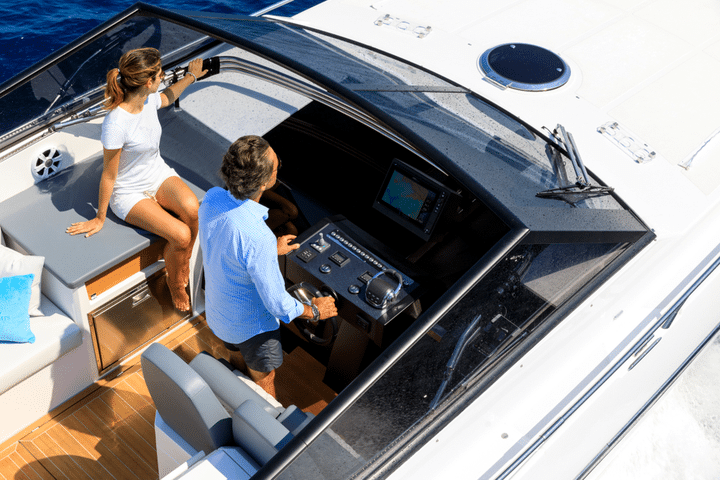
This is one of the most important steps when choosing the appropriate size yacht. There can be a point where your boat is just too big for your needs, budget, or storage capabilities. It’s not as easy to test drive a yacht as for a car, but there are some ways to try out a yacht before purchasing.
Tag along with others:
Chances are you know someone personally or indirectly with the same or similar yacht you are thinking of buying. This might take some finagling, but there’s a good chance someone will take you out. Once aboard, ask questions, explore the boat and ask for a turn at the helm .
Rent a yacht:
Renting a yacht is by far the best way to test out a few options. This method might be pricey, but there’s a good chance you’ll be able to rent a yacht that is the same or similar to the ones on your shortlist. Modern technology has created an avenue linking boat owners with boat seekers making this an easy, streamlined process.
Sizing Up Your Options
The test phase of this process should bring some insight into what size yacht suits your needs. By this time, you should have been able to narrow it down to three or four choices at best. This is a good time to revisit your preferences list to try and eliminate any contenders that don’t fully meet your size and lifestyle criteria. Think of it as a job applicant; you’re trying to narrow down your selection until you’re left with the perfect choice.
Fine Tuning Your Decision
If you haven’t been able to make a decision by now, you most certainly should have narrowed down your choices to two or three. If you are left with only two choices, it’s best to go bigger if that works for your budget and sailing capabilities.
If you’ve already decided on the size and are having trouble choosing between two manufacturers of yachts, this may be a time to revisit and update your preferences. Outside of size, style, comfort, and capability options, what else is important to you. Are you interested in buying products that are made locally? Is the environmental impact of the yacht and manufacturing practices important to you? Going beyond the surface preferences can most often seal the deal, but you will need to go back and do some more research.
Taking the Plunge
If you’ve figured out your preferences, done your research, and tested out your options, you’re ready to make your purchase. Owning a yacht of any caliber is an accomplishment since the decision-making process alone can be taxing. Aside from figuring out an appropriate size, potential captains are also faced with storage, insurance, and registration decisions which add to the effort and excitement of buying a yacht.
There’s nothing like feeling the water moving beneath you as you make the way to the helm of your new yacht. While the steps you need to take to decide what size yacht is best for you may seem time-consuming, you’ll be on the water in no time. Taking the time to make the most educated decision will serve you well in the long run with less anxiety about a big purchase. The online forums and social media sites boast grand adventures for yacht owners with very few stories of buyer’s remorse.

Boatsetter empowers people to explore with confidence by showing them a world of possibility on the water. Rent a boat, list your boat, or become a Boatsetter captain today.
Browse by experience

Explore articles
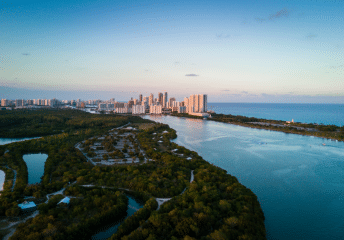
How to Navigate the Florida Intracoastal Waterway (ICW)

7 Great Boating Gifts Mom Will Love
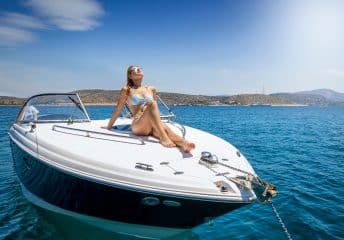
5 Best Winter-Sun Destinations in the US
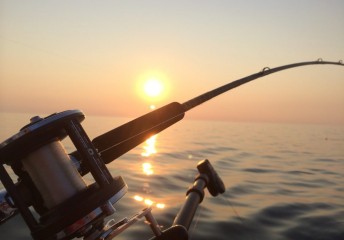
Trolling with Live or Dead Bait: 5 Tricks from Fishermen
How Big Are Yachts? 5 Types Explained
The world of yachts is a realm of luxury, adventure, and boundless horizons, offering enthusiasts the opportunity to explore the seas and oceans in style. What makes this domain even more intriguing is the vast array of yacht sizes available, each designed to cater to distinct preferences and purposes. In this article, we embark on a journey through the world of yachts, where size truly matters.
Yachts, from the modest to the magnificent, serve as the ultimate vessels for those seeking the thrill of open waters. Whether you’re dreaming of a serene day cruise or a grand voyage, there’s a yacht perfectly suited to your desires. From intimate day boats to sprawling superyachts, we’ll delve into five common types, each distinguished by its typical size and unique features. So, whether you’re a seasoned mariner or a novice dreaming of setting sail, join us as we explore the diverse world of yachts and discover which size best suits your nautical aspirations.
1. Day Sailers
Day sailers are the perfect choice for those seeking a leisurely day on the water. These small, compact yachts are specifically designed for day trips and short outings, making them an ideal option for individuals or small groups looking to enjoy a few hours of sailing bliss.
Typically ranging from 16 to 24 feet in length, day sailers strike a balance between size and maneuverability. Their relatively small stature allows for easy handling, making them an excellent choice for novice sailors or those looking for a hassle-free sailing experience.
One of the key features of day sailers is their simplicity. They often feature a single mast and a basic rigging setup, making them uncomplicated to operate. This simplicity is not only appealing to beginners but also to experienced sailors seeking a relaxing day on the water without the complexities of larger vessels. Whether you’re exploring tranquil coves, enjoying a picnic on deck, or honing your sailing skills, day sailers offer an accessible and enjoyable way to embrace the beauty of sailing.
2. Cruising Sailboats
Cruising sailboats are the epitome of adventure on the water, designed for extended voyages and comfortable living aboard. These vessels are tailored to meet the needs of sailors who dream of exploring distant horizons, anchoring in remote bays, and experiencing life at sea for more extended periods.
Cruising sailboats are known for their generous size, and they typically fall within the range of 30 to 60 feet in length. This ample size allows for spacious interiors equipped with numerous amenities, making them suitable for long-term cruising. These yachts often feature multiple cabins, a well-appointed galley, comfortable living spaces, and ample storage for provisions and gear.
What sets cruising sailboats apart is their capacity to carry everything needed for extended journeys, including provisions, water, and equipment for navigation and safety. They are designed for self-sufficiency, allowing sailors to explore remote destinations with confidence. Whether you aspire to sail to far-flung islands or live aboard while circumnavigating the globe, cruising sailboats offer the space and amenities needed for extended and comfortable voyages.
3. Motor Yachts
Motor yachts represent the epitome of luxury and power on the water. These vessels are designed for those who prefer the convenience of engines to sail power and seek the ultimate in comfort and opulence.
Motor yachts are characterized by their powerful engines, making cruising swift and efficient. They come in various sizes, ranging from 40 feet to well over 100 feet in length, catering to a wide range of preferences. The larger motor yachts often resemble floating mansions, with multiple decks, spacious cabins, and luxurious amenities.
What sets motor yachts apart is their opulence. These vessels are equipped with all the comforts of a luxury home, including fully-appointed kitchens, opulent living spaces, multiple cabins with en-suite bathrooms, and expansive decks for entertainment. They often feature state-of-the-art navigation and entertainment systems, along with crew quarters for those who prefer to sail with professional staff.
Whether you aspire to host grand parties on the water, explore distant coastlines in style, or simply enjoy the pinnacle of luxury living afloat, motor yachts offer an indulgent experience that’s hard to match.
4. Mega Yachts
Mega yachts represent the zenith of luxury and extravagance on the high seas. These vessels are the epitome of opulence, offering unparalleled amenities and unparalleled space.
Mega yachts are defined not just by their luxury but by their impressive size. Typically, they exceed 100 feet in length, with some truly mega yachts stretching beyond 200 feet. These vast dimensions provide ample space for opulent features, making them floating palaces.
What sets mega yachts apart are the lavish amenities they offer. These can include swimming pools, helipads for quick arrivals and departures, movie theaters, spacious lounges, and sprawling deck spaces for entertaining. The interior of a mega yacht is a marvel of luxury, often boasting multiple lavish cabins, each with its own en-suite bathroom, along with expansive living areas, dining rooms, and fully-equipped kitchens.
Mega yachts are often staffed with a full crew to cater to the desires of their discerning owners and guests, ensuring that every need is met with the utmost attention to detail. For those who demand the very best in maritime luxury and seek a lifestyle of uncompromising opulence, mega yachts offer an experience like no other.
5. Superyachts
Superyachts, as the name suggests, are the apex of luxury and size in the world of yachting. These vessels represent the ultimate expression of opulence and sophistication on the open seas.
Superyachts are defined by their extraordinary size and lavish amenities. They are the largest and most luxurious yachts available, typically ranging from 100 to well over 300 feet in length. These dimensions provide a canvas for the inclusion of the most extravagant features and facilities imaginable.
The hallmark of a superyacht is its opulent interior and exterior spaces. These vessels often boast multiple decks, each dedicated to a specific form of entertainment or relaxation. You might find features such as cinemas, complete spa facilities, gyms, helipads, and sprawling lounges. Superyachts frequently include a range of cabins and suites, each impeccably designed and featuring its own en-suite bathroom.
The interior of a superyacht is a world unto itself, often showcasing exquisite craftsmanship, sumptuous furnishings, and state-of-the-art technology. The exterior spaces are equally breathtaking, offering expansive decks for sunbathing, dining, and socializing.
Superyachts are typically crewed by a highly-trained and professional staff, ensuring that every need and desire of their owners and guests is met with unparalleled attention to detail. For those who seek the ultimate in luxury and are accustomed to the finest things in life, superyachts offer an unrivaled maritime experience.
Choosing the Right Size Yacht
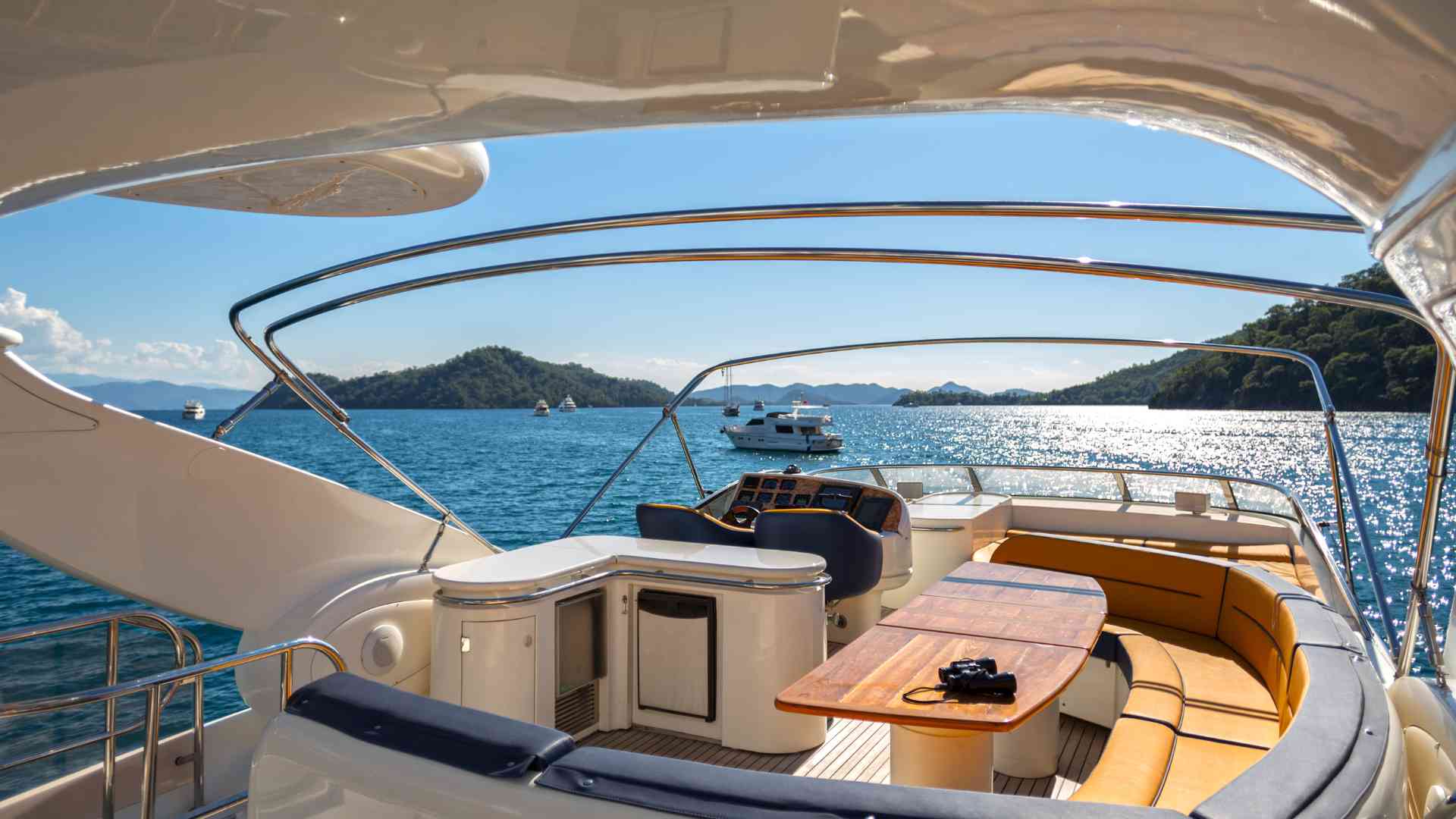
Selecting the right size yacht is a pivotal decision that should align with your preferences and needs. Here’s some guidance on how to make this important choice:
- Budget: Determine how much you’re willing to spend on purchasing and maintaining a yacht. Larger yachts generally come with higher purchase prices, operational costs, and maintenance expenses. Ensure that you choose a size that fits comfortably within your budget.
- Intended Use: Consider how you plan to use your yacht. If you’re looking for day trips and short outings with a few friends or family members, a day sailor in the 16 to 24-foot range might suffice. For extended cruising or living aboard, you’ll need a larger vessel. Cruising sailboats in the 30 to 60-foot range are ideal for this purpose. If you’re more interested in power and luxury, motor yachts, mega yachts, or superyachts in excess of 100 feet may be suitable.
- Experience Level: Your familiarity with boating and yachting is a significant factor. Smaller vessels like day sailers are easier to handle for beginners, while larger yachts demand greater skill and experience. If you’re new to yachting, consider starting with a smaller yacht and working your way up as you gain proficiency.
- Number of Passengers: Think about the number of people you’ll typically have on board. Smaller yachts are intimate and cozy, perfect for small groups. Larger yachts provide more space for guests, crew, and amenities, making them suitable for hosting parties, events, or extended family trips.
- Luxury Level: Assess your desire for luxury and onboard amenities. If you’re seeking the ultimate in opulence, mega yachts and superyachts offer a level of extravagance that smaller vessels can’t match. They come equipped with features like swimming pools, helipads, and spacious interiors.
- Research: Take your time to research different yacht sizes and types. Understand the pros and cons of each category. Consider consulting with experienced yacht brokers or naval architects who can provide valuable insights based on your specific needs and preferences.
Ultimately, the right size yacht is one that aligns with your lifestyle, budget, and aspirations. It’s a vessel that enables you to enjoy the boating experience to the fullest, whether you’re embarking on day trips, long cruises, or extravagant adventures on the open water.
Conclusion – How Big Are Yachts
In conclusion, this article has delved into the fascinating world of yachts, exploring five common types and their typical sizes. Here’s a recap of the key points:
- Day Sailers: These compact vessels, ranging from 16 to 24 feet, are perfect for short outings and day trips, known for their ease of handling and simplicity.
- Cruising Sailboats: Designed for extended voyages and comfortable living, cruising sailboats typically fall between 30 and 60 feet, offering amenities for long-term cruising.
- Motor Yachts: Powered by engines, motor yachts range from 40 to over 100 feet, offering luxury features and spacious interiors.
- Mega Yachts: These opulent vessels, often exceeding 100 feet, are associated with extravagance, featuring amenities like swimming pools and helipads.
- Superyachts: The epitome of luxury and size, superyachts range from 100 to over 300 feet, boasting extravagant features such as cinemas and spas.
When choosing the right size yacht, factors like budget, intended use, experience level, number of passengers, and desired luxury level play crucial roles. It’s essential to conduct thorough research and possibly seek expert advice to make an informed decision.
Remember, the size of your yacht significantly impacts your boating experience, from intimate day trips to grand ocean adventures. Ultimately, the perfect yacht is the one that aligns with your unique needs and aspirations, ensuring a lifetime of enjoyable moments on the water.
Share Symptoms of a Bad Primer Bulb on an Outboard Motor with your friends and Leave a comment below with your thoughts.
Read Mercury Outboard Shifting Problems and Solutions until we meet in the next article.
Similar Posts

5 Most Common Problems with Suzuki 350 Outboard
The Suzuki 350 outboard is a powerhouse engine, revered for its speed, fuel efficiency, and reliability. However, even the most robust machines can encounter issues, and the 350 is no exception. So, before you hit the throttle, let’s dive into the most common Suzuki 350 outboard problems and how to tackle them: 1. Water Intake…
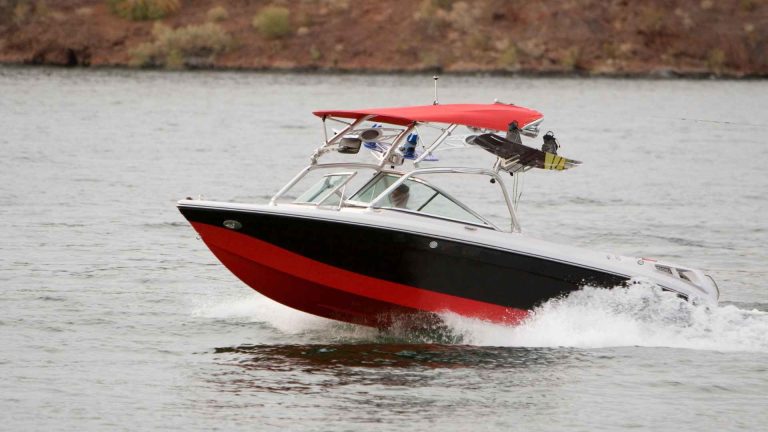
How Much Does a Boat Weigh? A Guide with Factors to Measure
Boats have always captivated human imagination, from ancient voyages of discovery to leisurely cruises on serene waters. Their elegance, versatility, and ability to take us to new horizons make them objects of fascination. But have you ever wondered how much a boat weighs? Delving into a boat’s weight can unveil a world of insights, from…
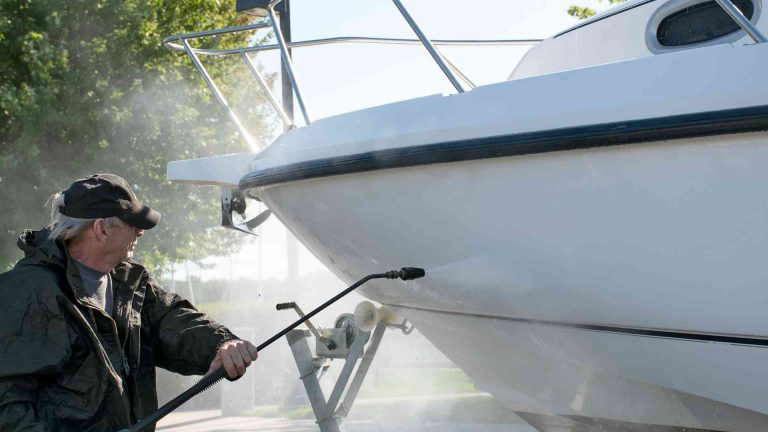
How to Prevent Osmotic Blisters on Fiberglass Boat Hulls?
In the mesmerizing world of boating, where the horizon stretches endlessly and adventure beckons with every wave, the allure of fiberglass boat hulls stands as a testament to both beauty and durability. These sleek vessels glide through the water, embracing the elements with a grace that captures the heart of any seafarer. Yet, beneath the…
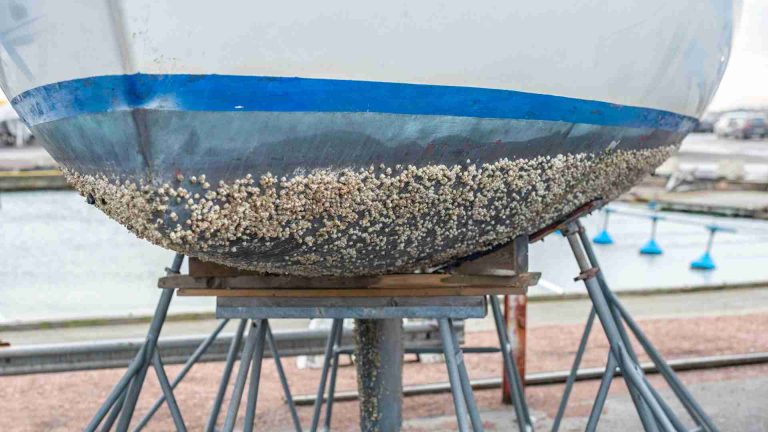
How to Prevent and Remove Barnacles from Boat Hull?
As the gentle waves embrace the hull of your boat, a hidden adversary lurks beneath—the relentless growth of barnacles. This common challenge has plagued boaters for centuries, leaving its mark not only on the vessel’s appearance but also on its performance and fuel efficiency. What Barnacles Are and How They Attach Themselves to Boat Hulls?…
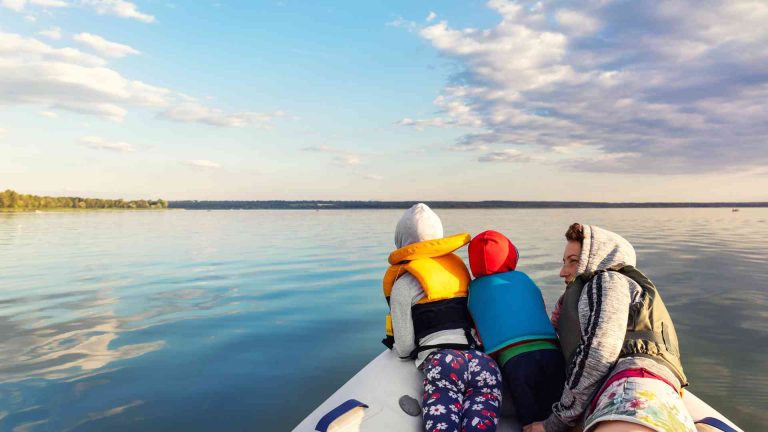
Can a River Boat Go in the Ocean? Guide with Limitations
Imagine the vastness of the open ocean, where waves crash against the horizon, and the sea stretches as far as the eye can see. Now, picture the serene beauty of a peaceful river, winding its way through lush landscapes and charming towns. Boats have the remarkable ability to traverse these diverse waters, each offering a…
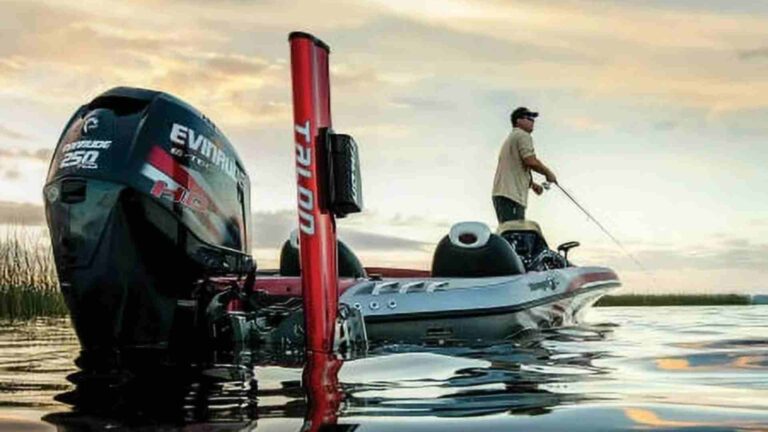
5 Most Common Problems with Minn Kota Talon
Minn Kota Talons, with their rugged design and anchor-like hold, have revolutionized shallow water anchoring for countless anglers and boaters. But even the most dependable equipment encounters snags. So, before venturing into the shallows, let’s dive into the depths of common Minn Kota Talon problems and explore effective solutions: 1. Deployment Difficulties: 2. Retraction Ruckus:…

- (954) 633-4878
- [email protected]

Compass Articles
- November 29, 2023
The Buyer’s Guide to Yacht Size and Capacity
Venturing into the world of yachting requires a discerning look at size and capacity to ensure your seafaring vessel truly meets your lifestyle needs. Fly Yachts is adept at guiding future yacht owners through the considerations and nuances of selecting the right size yacht for their adventures.

Considering the Scale: Matching Size to Your Seafaring Desires
Yacht size affects everything from where you can dock to the overall experience on board. It’s crucial to choose a size that not only fits where you want to go but also reflects how you wish to live on the waves.
Determining the Right Size
- Intended Use : Will your yacht be a tranquil getaway for family, an entertainment hub, or a globe-trotting explorer? Your intended use will shape the size requirements.
- Number of Guests : Account for the number of guests you aim to accommodate. More guests mean you’ll need additional cabins and social spaces.
- Crew Capacity : Larger yachts require more hands on deck, which means providing space for crew quarters and operations.
Maneuverability and Docking
- Handling and Navigation : Consider how size impacts the ease with which you can navigate different waters and berth in various marinas.
- Docking Options : Larger yachts might limit where you can dock, both geographically and economically. Smaller yachts offer more flexibility.
The Comfort Question: Space and Amenities On Board
A yacht is a home away from home; hence, space optimization for living quarters and amenities is paramount for maximum enjoyment.

Living Space
- Layouts : Prioritize a layout that accommodates your lifestyle. Open, multifunctional spaces may benefit social butterflies, while more compartmentalized designs offer privacy.
- Storage : Sufficient storage is vital for convenience and clutter-free living, especially on longer voyages.
- Entertainment and Leisure : Match your wish for amenities – from outdoor dining to wellness facilities – with the yacht size that can feasibly accommodate them.
- Technological Needs : Ensure the yacht can support the technological infrastructure you require, from connectivity to state-of-the-art navigation.
Financial Implications of Yacht Size
The size of a yacht has a direct impact on the acquisition and operational budget. It’s imperative to choose a yacht that aligns with your financial expectations.

Budget Considerations
- Purchase Price : Larger yachts carry a heftier price tag not only in terms of initial cost but also when considering customization and finishing.
- Ongoing Costs : Factor in how size influences maintenance, refueling, crew salaries, insurance, and berthing fees.
The Cost-Benefit Analysis
- Value for Money : Ensure that the additional space and capabilities of a larger yacht genuinely augment your yachting pleasure relative to the added expense.
- Resale Value : Larger yachts can be more challenging to sell and may depreciate differently. Assess market trends for an informed purchase.
Streamlining Your Decision: The Fly Yachts Advantage
Fly Yachts provides industry expertise to buoy your decision-making process, drawing upon a deep understanding of how size and capacity fit within the wider framework of yacht ownership.
Professional Guidance
- Ocean Trials : Experience various yacht sizes firsthand to gauge your comfort with handling and living conditions.
- Expert Matchmaking : Rely on Fly Yachts’ understanding of your lifestyle to recommend yachts that are the perfect fit in size and scope.
A Personal Touch
- Custom Consultations : We tailor our approach based on your specific use cases, preferences, and enjoyable necessities.
- After-Sale Support : Fly Yachts offers continued guidance on managing, maintaining, and maximizing your investment.
Navigating Your Yacht Ownership Journey
Whether it’s a cozy cruiser for intimate getaways or a majestic vessel for grandiose galas, your yacht should be a testament to your lifestyle and aspirations. Partner with Fly Yachts to chart a course to the ideal yacht where size, capacity, and dreams align seamlessly with practicality.
Embark on a journey with Fly Yachts, and let us guide you to a yacht that not only accommodates your guests but fulfills your visions of life at sea.
(Note: While our expertise covers an array of yacht types and sizes, the emphasis in our guidance is on finding the perfect match for each unique buyer, regardless of category.)

How Do I Determine the Right Size Yacht for My Needs?
Consider factors such as the number of guests you plan to accommodate, the types of voyages you will undertake, whether you need a crew, and your comfort level with piloting larger vessels.
What Impact Does Yacht Size Have on Maintenance and Operating Costs?
Larger yachts typically incur higher maintenance and operating costs due to more extensive systems, higher fuel consumption, and the potential need for a professional crew.
Is There a Recommended Size for First-Time Yacht Buyers?
First-time buyers may benefit from starting with a smaller yacht for ease of handling and lower maintenance costs, allowing them to gain experience before moving up in size.
How Does Yacht Capacity Affect My Entertainment and Hospitality Options?
The yacht’s capacity determines how many guests can comfortably be onboard, affecting the scale and type of entertainment you can offer, from intimate gatherings to large parties.
Does a Larger Yacht Necessarily Mean More Luxurious Amenities?
Not necessarily—luxury depends more on the quality of finishes, craftsmanship, and amenities rather than size alone. A smaller yacht can have high-end, luxurious features just as a larger one can.
Should I Factor in Future Needs When Deciding on Yacht Size?
Considering future needs, such as family growth or changing lifestyle ambitions, can be wise when deciding on yacht size to ensure your investment remains suitable for longer.
What Are Some Challenges Associated with Operating Larger Yachts?
Challenges may include needing a qualified crew, navigating and docking complexities, higher costs for maintenance and berthing, and more elaborate operational planning.
Does the Intended Cruising Range Influence the Ideal Size of a Yacht?
Yes, intended cruising range can influence size choices, as longer trips may require larger fuel capacity, more storage space for provisions, and additional accommodations for crew and guests.
How Can I Use Size and Capacity to Compare Different Yachts?
Compare yachts by looking at overall length, beam, draft, gross tonnage, and passenger capacity to evaluate how each vessel will meet your space and performance needs.
How Will Fly Yachts Assist Me in Choosing the Correct Size and Capacity?
Fly Yachts’ experts will analyze your requirements, provide comparisons of different yacht sizes and capacities, and guide you in making a selection that aligns with your current and anticipated needs.
If you’re setting your sights on the high seas, Fly Yachts presents a stunning array of yachts for sale , including the grandeur of super yachts and the practicality of center consoles. Starting at their welcoming homepage , you can get a snapshot of what they bring to the boating table. Gain insight into their reputable background and skilled crew by browsing the About Us section. For hands-on enthusiasts, the Build a Yacht feature invites you to put your unique signature on your next floating masterpiece. Meanwhile, wanderlust is catered to with an enticing lineup of charter destinations , each promising a different slice of paradise. The Compass Articles serve as an educational hub, brimming with information perfect for yachting enthusiasts of all levels. And when the time comes to transition from yacht owner to seller, the Sell Your Yacht page will guide you through the process with support from seasoned professionals. For those looking for a short-term sea voyage, the array of yachts charter is replete with luxury options for a memorable escape. But it’s not all nautical; aerial adventures await with a selection of aircraft for sale , blending sky-high luxury with the thrill of flight. Keep up with the latest in boating and lifestyle through Gulfstream News , and when you’re ready to step forward or have questions, reach out on the contact page, where the Fly Yachts team is on standby to help guide your journey to the ultimate luxury experience.
About FLY Yachts
Unmatched Industry Knowledge, Paired With Brokers Who Care Equals Yachting You Love.
Recent Posts
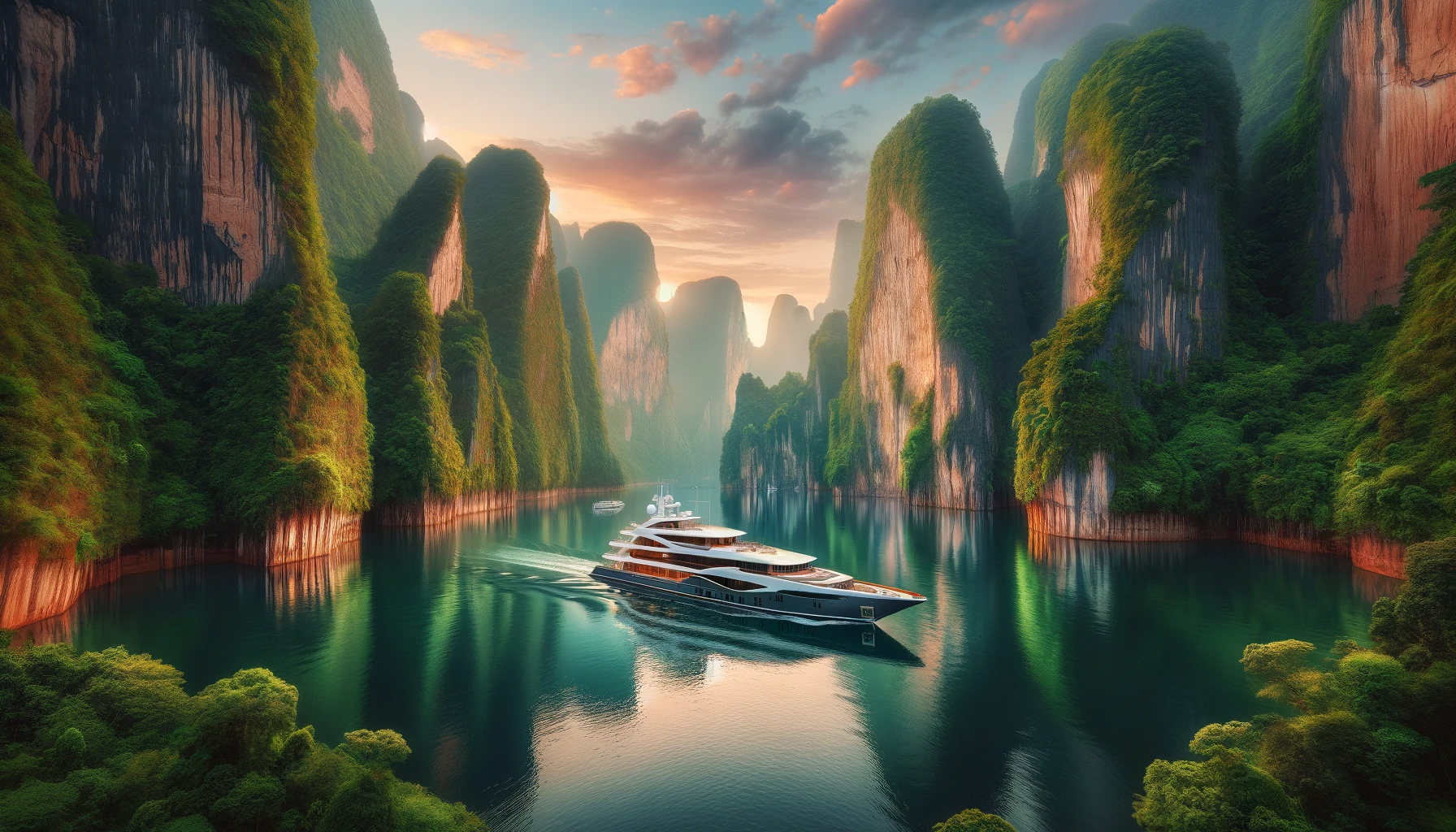
Exclusive Insights into Yacht Buying: How to Embark on a Journey of Luxury
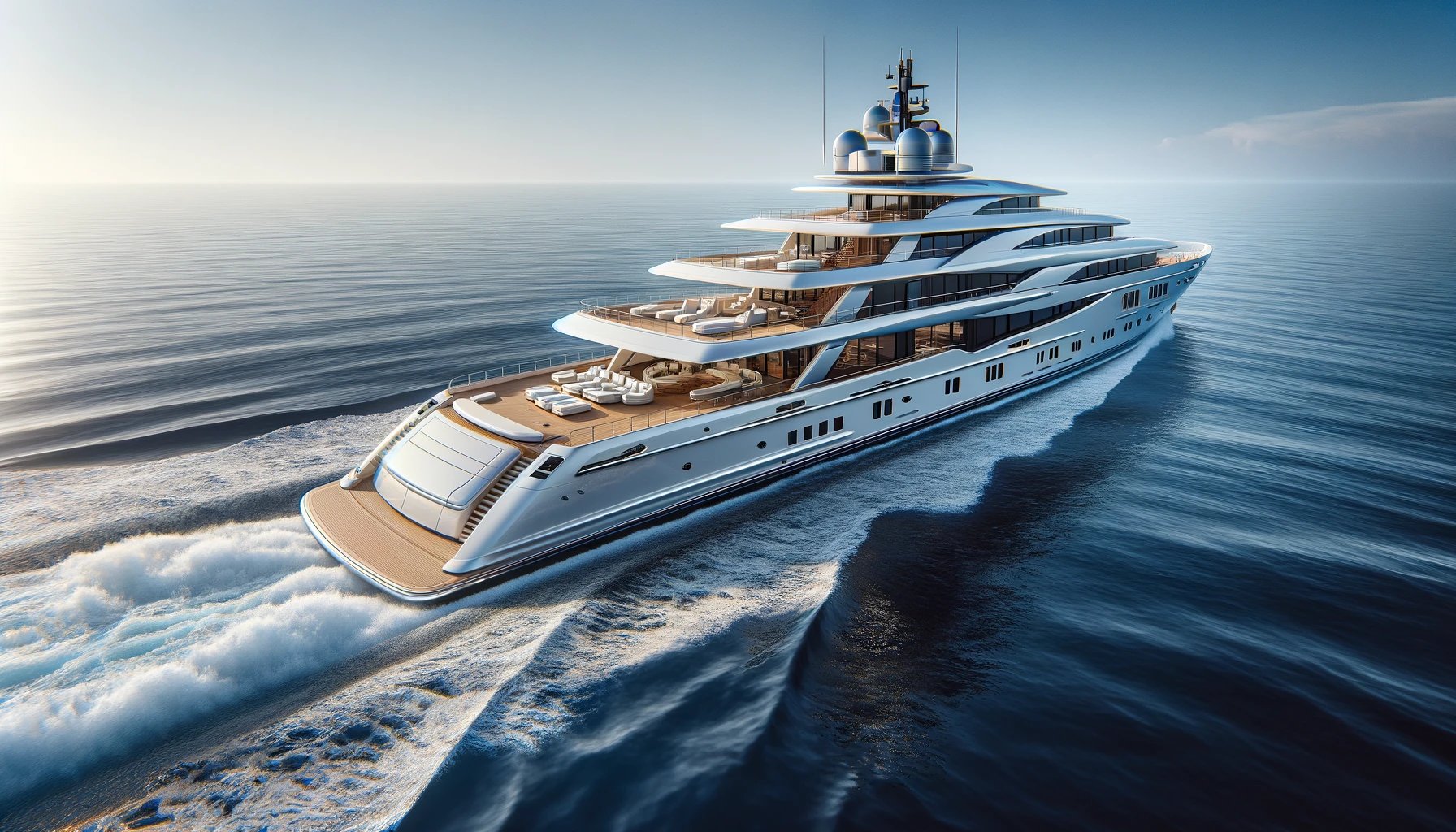
Elevate Your Horizon: The Definitive Guide to Buying a Prestigious Yacht
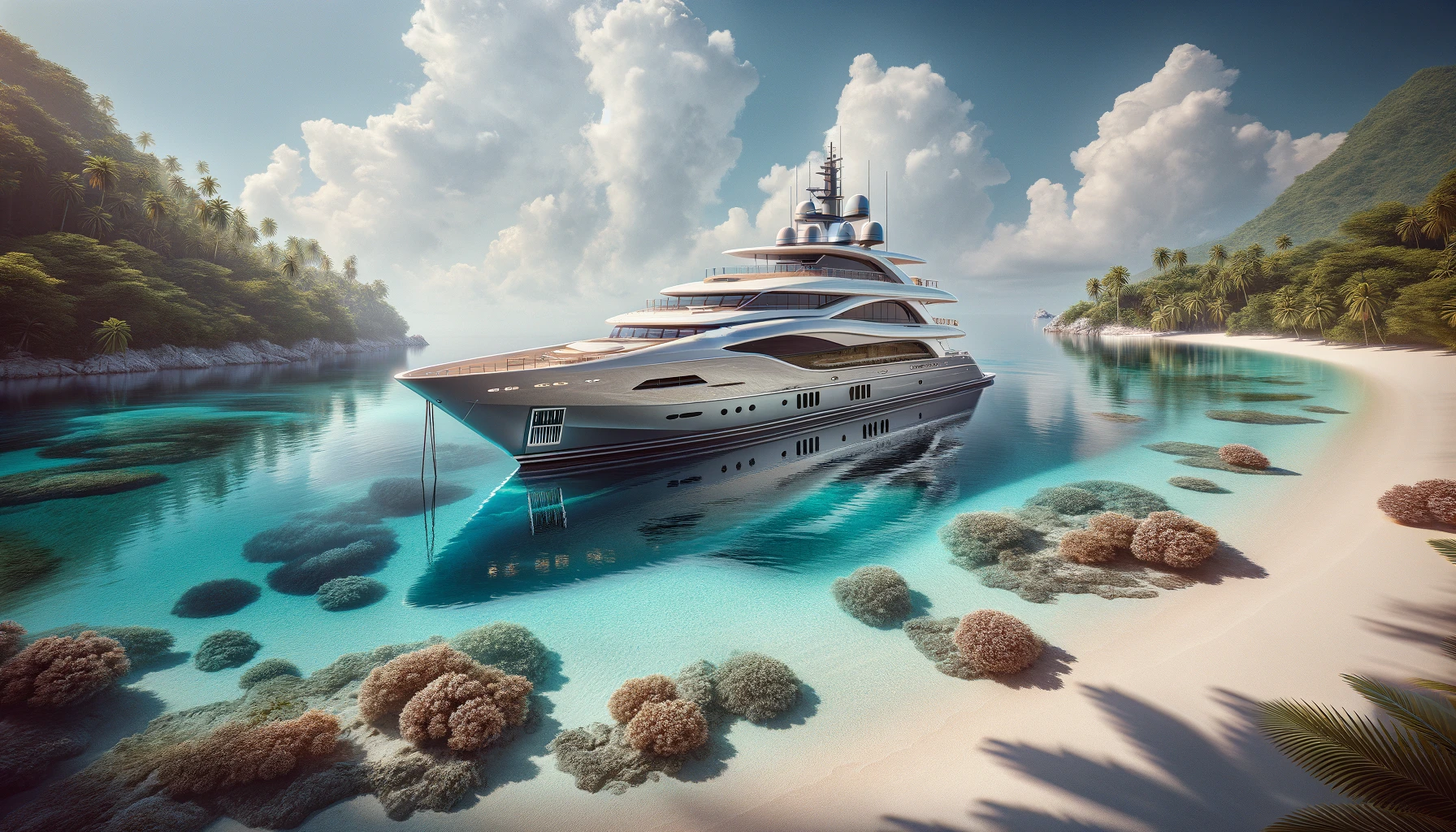
Yacht Buying for the Connoisseur: Crafting a Legacy of Luxury


Introduction To Different Types Of Yachts
We have discussed the differences between cruise ships and their older counterparts, ocean liners in one of our previous articles. We have also learned about the various types of cruise ships.
In this article, we shall discuss the types of yachts.
To begin with, what are yachts? Yachts are those small to average-sized vessels used for pleasure, vacation, or sports activities like racing. The most distinct feature that distinguishes yachts from any other boat or vessel is their aesthetics.
Yachts are attractive and sleek in appearance, have narrow and streamlined beams, and are often pleasing to the eye. However, size is also another important parameter taken into consideration.
As per classification rules, a vessel dedicated for the aforesaid purposes is deemed to be a yacht only when it is over a certain length of at least 10 meters or 33 feet.
Though sizes of yachts can be as large as more than 70-80 meters, they are rarely 100 meters or more. Larger vessels of such extents come under the purview of cruisers or passenger ferries as discussed before. A handful of exceptions exist.
The private megayacht Azzam, having a length of 180 meters, is the longest existing motor vessel in the world to be classified as a yacht.
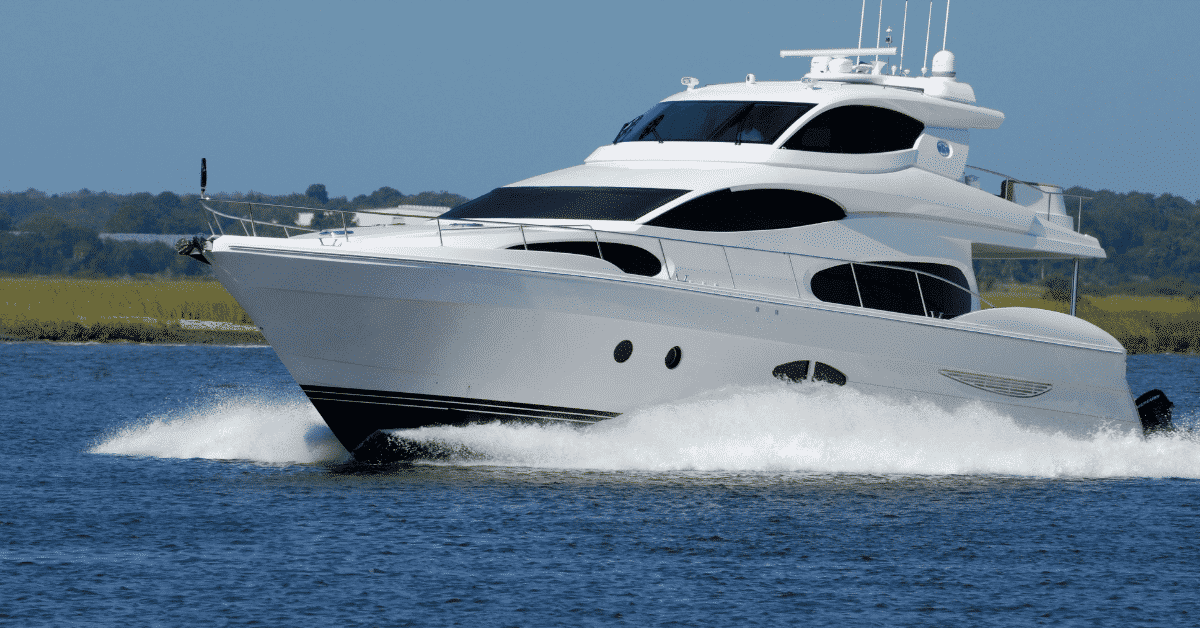
Types of Yachts
Based on length and size, yachts can be classified into the following categories:
Megayachts: These are the largest of their kind. Most yachts under this category have lengths of over 50 meters. They are used for leisure or recreational purposes and are suitable for large families or groups. Most of such yachts are owned and operated by organizations similar to cruise lines but private ownership also exists. These vessels have dedicated crew to cater for the services of passengers. In terms of facilities and amenities, they are very much close to luxury cruisers and are often replete with everything from swimming pools to pubs, cafeterias to movie halls, gyms to restaurants, suite rooms to conference banquets. Of course, provisions of all these depend on the size of the vessel.
Superyachts: These are lesser in size than the former. Their average length ranges from 30-50 meters. They also have appealing features like Jacuzzis, sky lounges, dining rooms, and bars. Superyachts can be both motor-driven or have sails (shall discuss more on this later). They also are often served by professional crew members. Both superyachts and megayachts are also called offshore yachts for their ability to tread deeper waters.
Medium-sized luxury yachts: With lengths ranging from 20-30 meters, they are suitable for large families or tourist groups. They may have a small number of dedicated crew members. Though not having many amenities like their larger counterparts, they offer a significant degree of comfort and luxury. They operate near the shore or in rivers.
Smaller Yachts: These vessels range between 10 meters to 18 or 20 meters. Most of such vessels are privately owned and are used for purposes such as leisure or water sports. They can be both motor or sail-driven or a combination of both. They have the main deck and living quarters comprising of at most 2 or 3 rooms below it. These yachts may have a small promenade deck or a flybridge. These yachts are compact, streamlined, and aesthetically attractive. Such yachts have limitations for venturing beyond a certain limit of the sea or river.
By propulsion
Sailboats: Like most other ships, yachts have evolved from having prominent sails for plying in the waters by the virtue of wind forces to having motorized propulsions. Unlike cruisers and ferries which became popular at a much later date during the 17th or 18th centuries, yachts or the concept of pleasure boats saw their advent as early as the Pharaonic Egyptian era.
For several centuries, these pleasure boats were characterized by different forms and sizes of sails. The areas of the sails depended on the size of the vessel, of course, and were primarily composed of natural materials such as flax or cotton fibers.
However, with the introduction of synthetics, sails made of polyester or nylon became increasingly popular and have continued to be used to date. Sail yachts are of numerous types, most of their designs derived from traditional variants of monohull sailboats like sloop, catboats, cutter, ketch, or schooner.
These vessels can be single sail-single mast (like catboats), double sail-single mast (sloop), or other versions of multiple sails-multiple masts (like ketches or schooners). Though almost all modern yachts employ mechanized propulsion, many still feature sails simply for aesthetics (see gullet yachts below).
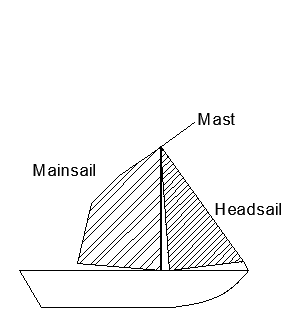
Motor Yachts: After the Industrial revolution, yachts, in tandem with other vessels, incorporated engines for their propulsion. Coal-fired steam engines used both fire-tube and water-tube boilers. Over the years, steam engines became superseded by modern fuel-powered combustion engines. Yachts feature both four-stroke gasoline engines, especially for smaller and high-speed designs, as well as two-stroke diesel engines, for larger designs. Yachts may use single or twin-screw propellers of 3-blade, 4-blade, 5-blade, or even 6-blade propellers based on the requirements.
Gulet Yachts: They are a hybrid of the above types and employ both sails and engines for propulsion. As mentioned above, often the sails, even when no longer required, are kept for aesthetic appearance.
Based on Hull Design
Monohull: Commonly, yachts are of monohull configuration. Such hulls can be either of displacement or planing type. For displacement-type hulls, the buoyancy is created by the displacement and such vessels have average speeds not exceeding a certain limit.
Planing hulls, as we know, are meant for high-speed crafts where a substantial portion of the hull weights at high speeds are supported by the component of hydrodynamic lift as opposed to the hydrostatic lift from buoyancy. These vessels have very low wetted surface area during high speeds (and thus less frictional resistance) and the forward portion of the hull mainly stays above the waterline.
During rest or low speeds, once again, they are supported by buoyant forces. Yachts with planing-type hulls are quite small in size and are primarily meant for pleasure or water sports activities. Some designs combine both the elements of planing and displacement characteristics forming semi-displacement hulls.
Multihull: Yachts can also be multi-hull configurations, i.e., catamaran (two hulls) or trimaran (three hulls) types. Catamaran designs are chiefly characterized by two slender hull structures joined by the extension of the bridge deck or a large crossbeam. These vessels are highly stable and seaworthy.
Trimarans have a central hull and are further connected to a pair of hulls on either side by beams, superstructures, or decks. Multihull yachts mainly rely on their inherent stability and are not very fast like planning crafts. As expected, they are very expensive in construction. They are mainly composed of fibreglass and other composites.
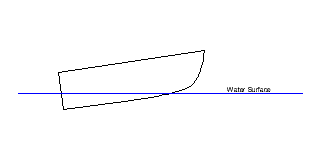
Based on Purpose
Cruiser Yachts: They are conventional yachts of varying sizes meant for passenger pleasure and vacationing. These vessels are permitted for long-distance travel up to moderate depths of the ocean. They are mainly of displacement type. Luxury yachts often come under this category.
Fishing Yachts: These yachts are chiefly built for fishing purposes as a recreational activity. These yachts have space for ample fishing equipment and gear and are characterized by open decks favourable for fishing as well as hauling up the catch. These vessels are permitted to venture into areas having the best chances of fishing but are barred from deeper depths of the seas.
Trawler Yachts: Their purpose is similar to a conventional fishing vessel designated for mass-scale commercial fishing. However, unlike the bland design of trawlers, these vessels imbibe some degree of aesthetics familiar to a yacht.
Sports Cruisers: These cruisers are meant for recreational or sports activities and short fast trips. Such vessels are mostly characterized by either planning or semi-displacement hulls. They are relatively smaller in size and thus accommodation spaces are limited. Such vessels have a stylish and sleek-appearing flybridge and an open deck for a better experience. Such vessels reach speeds from 30 knots to 50 knots. Sports yachts are also often deployed for racing purposes. They are sometimes also known as open yachts. For those willing to indulge in a bout of adrenaline rush like in sports cars, these yachts are the apt choice!
Sport Fishers: These vessels combine both the purposes of luxury as well as fishing. Like fishing yachts, they are equipped with fishing gear as well as have features for ample passenger comfort and amenities. They often have semi-displacement or planing configurations. During fishing activities, they are idle or operate at low speeds and during pleasure, they may be operated at high speeds. Though generally not very big in size, larger vessels with sizes around 30 meters exist.
Expedition Yachts: For those having an appetite for some real adventure or exploration, these yachts are just the right ones. They are designed for longer voyages and often receive permits for long-distance trips, often to uncharted and remote locations. Since adventure or exploration groups involve quite a number of people and unpredictable sea states, these vessels are significantly large in size. They are strict of displacement hulls, often strengthened to suit various types of conditions likely to be encountered. For those vessels venturing into icy waters, the hulls are designed and constructed based on Ice-Class regulations. From coral reefs to the wilds of the Pacific, such vessels are capable of literally traversing anywhere! Modern competent designs incorporate all elements of passenger comfort, luxury, amenities, power, endurance, strength.
Classic Yachts: Some still have a taste for vintage times. Classic yachts are the older restored and retrofitted vessels or newly built ones designed in a way similar to yachts built in the yesteryears. The hull is as per the older variants and often has sails. They are strictly for shallow water and near-shore leisure for those seeking a touch of royalty and the glorious past. These are mainly owned by vintage collectors or connoisseurs.
You might also like to read:
- Top 10 Biggest RoRo Ships In The World
- Top 10 Biggest Ice Breaker Ships in the World in 2022
- Top 10 Largest Cruise Ships in 2022
- Top 10 Biggest LPG Carriers
- Top 10 Biggest LNG Ships of 2022
Disclaimer: The authors’ views expressed in this article do not necessarily reflect the views of Marine Insight. Data and charts, if used, in the article have been sourced from available information and have not been authenticated by any statutory authority. The author and Marine Insight do not claim it to be accurate nor accept any responsibility for the same. The views constitute only the opinions and do not constitute any guidelines or recommendations on any course of action to be followed by the reader.
Do you have info to share with us ? Suggest a correction

Latest Naval Arch Articles You Would Like :
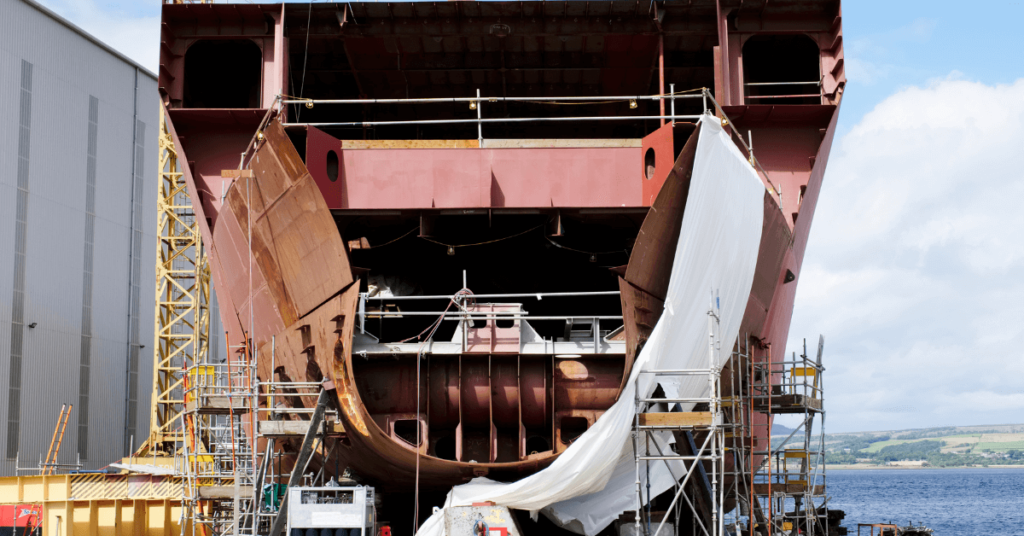
Shipbuilding Process – Plate Stocking, Surface Treatment and Cutting
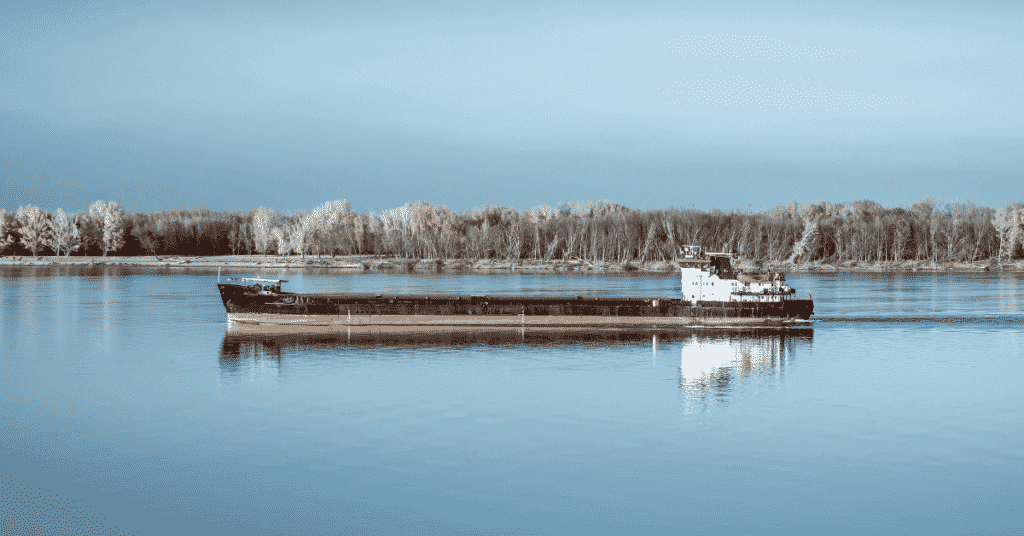
Ship Stability – Introduction to Hydrostatics and Stability of Surface Ships
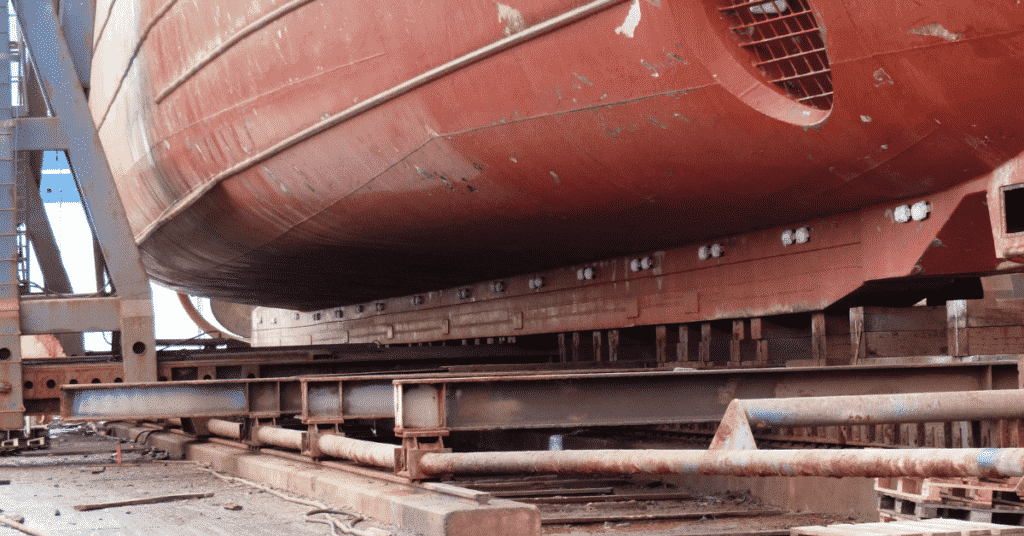
What are Keel Guards?
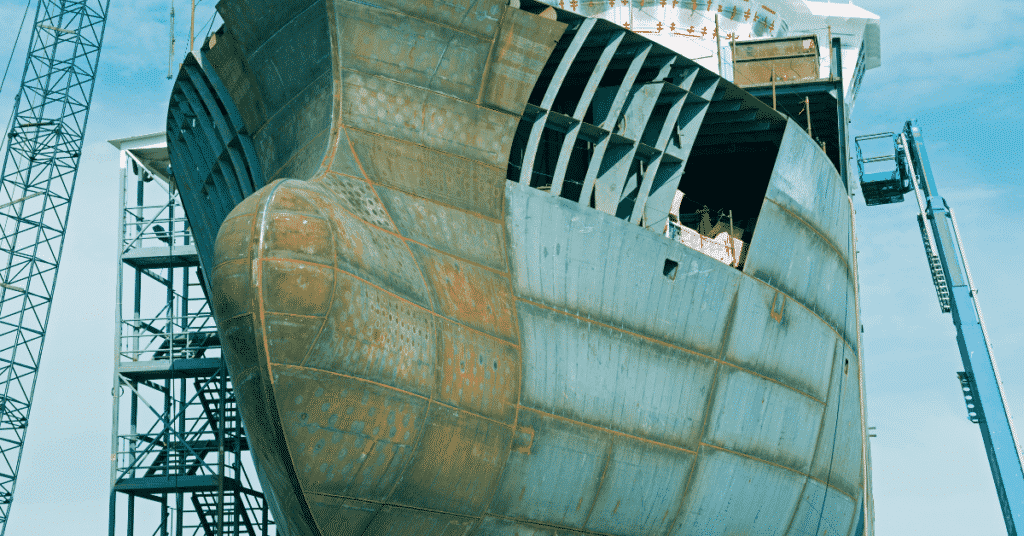
How Shipyards Can Adopt Advanced Outfitting?
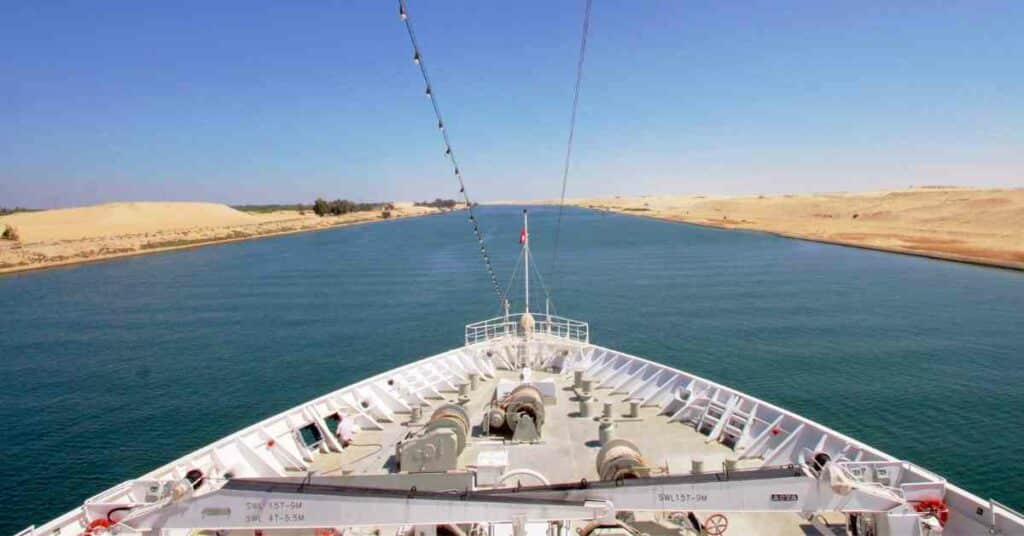
Understanding “Making Way” And “Underway” Nautical Terms
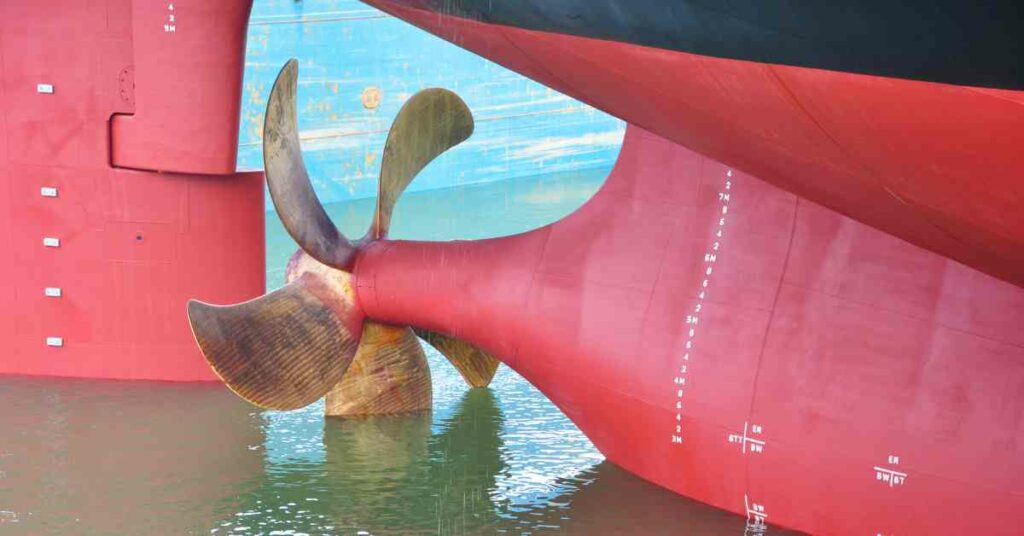
What is a Skeg in a Vessel?
Web Stories
Subscribe To Our Newsletters
By subscribing, you agree to our Privacy Policy and may receive occasional deal communications; you can unsubscribe anytime.

About Author
Subhodeep is a Naval Architecture and Ocean Engineering graduate. Interested in the intricacies of marine structures and goal-based design aspects, he is dedicated to sharing and propagation of common technical knowledge within this sector, which, at this very moment, requires a turnabout to flourish back to its old glory.
Leave a Reply
Your email address will not be published. Required fields are marked *
Subscribe to Marine Insight Daily Newsletter
" * " indicates required fields
Marine Engineering
Marine Engine Air Compressor Marine Boiler Oily Water Separator Marine Electrical Ship Generator Ship Stabilizer
Nautical Science
Mooring Bridge Watchkeeping Ship Manoeuvring Nautical Charts Anchoring Nautical Equipment Shipboard Guidelines
Explore
Free Maritime eBooks Premium Maritime eBooks Marine Safety Financial Planning Marine Careers Maritime Law Ship Dry Dock
Shipping News Maritime Reports Videos Maritime Piracy Offshore Safety Of Life At Sea (SOLAS) MARPOL
What Size Yacht Requires a Crew? (For Different Lengths)
While smaller yachts can be operated by a single person, larger yachts require a trained crew to operate them safely. Different types of yachts also have different crew needs, which can depend on the yacht's size, features, and intended use. In this article, we'll let you know what size yacht requires a crew, and how many crew are needed for different types and lengths of yacht.
Yachts that are over 30 feet in length require a crew to operate them safely. A yacht that is 100 feet in length requires a crew of at least four to six people, including a captain, engineer, stewardess, and deckhand. Meanwhile, yachts that are under 30 feet in length can be operated by a single person.
Recreational yachts are typically smaller and used for leisure activities like fishing, cruising, and water sports. Since these yachts are usually 30 feet or smaller, they can be operated by a single person without a crew. Let's see how many crew members are needed for other types of yachts.
- If the yacht is under 30 feet and is being used for recreational cruising, a crew of two is usually sufficient.
- A 90-foot yacht with multiple decks and luxury amenities may require a crew of 8–12 people, including a captain, first mate, chef, stewardess, and deckhand.
- For sailing yachts between 30 and 50 feet, a crew of four to six is typically required.
- A small superyacht may have a crew of around 20 people, while a larger one may require a crew of 50 or more.
- The cost of hiring a full-time yacht crew can range from $50,000 to $200,000 per crew member per year.
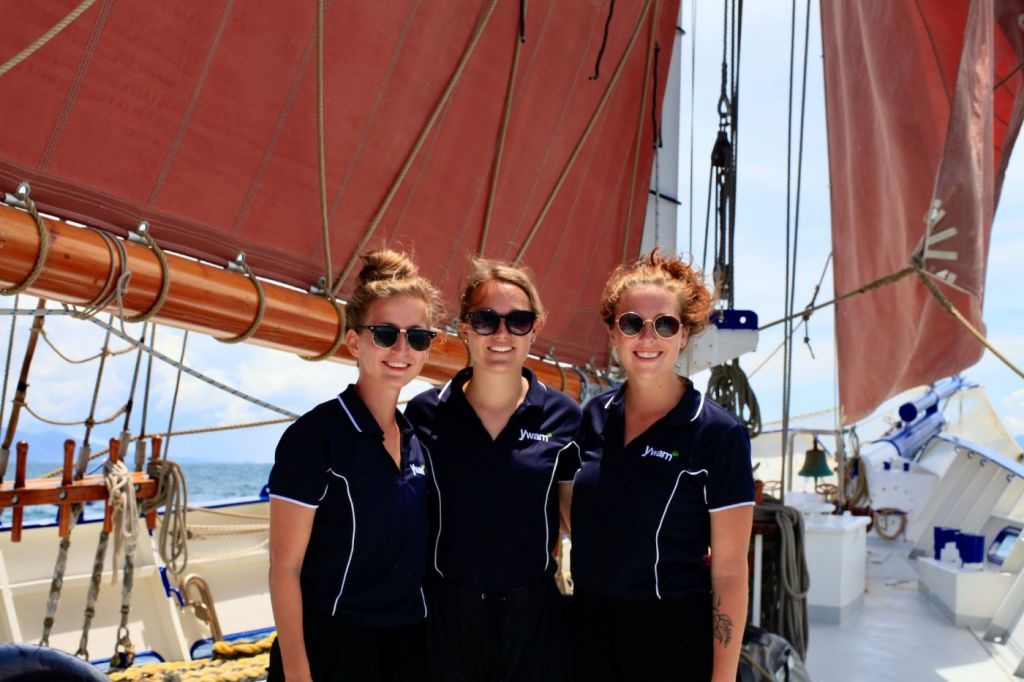
On this page:
Crew requirements for different yacht sizes, yacht types and their crew needs, the cost of hiring a yacht crew and the role of each member.
The size of the yacht is a key factor in determining whether you will need a crew and how many crew members you will require. Below is a table summarizing the crew size requirements for different yacht sizes:
Crew size for yachts under 30 feet
Yachts that are under 30 feet in length are generally small enough to be operated by a single person. However, you still need to have some experience and knowledge of boating to operate them safely. It is also recommended to have at least one additional person on board for safety reasons.
If the yacht is being used for recreational cruising, a crew of two is usually sufficient. You may also need to obtain a recreational boating license depending on your location.
Not sure how to get a boating license? Find which state you're in and get a boating license here.
Crew size for yachts between 30 and 75 feet
Yachts that are between 30 and 75 feet in length may require a crew. These yachts are designed to be operated by a small crew or a couple, with one person serving as captain and the other as crew.
If you have experience and the yacht has upgraded features like autopilot, you may be able to captain your own yacht without a crew. However, if you are new to yachting or the yacht has more advanced features, you may need to hire a crew.
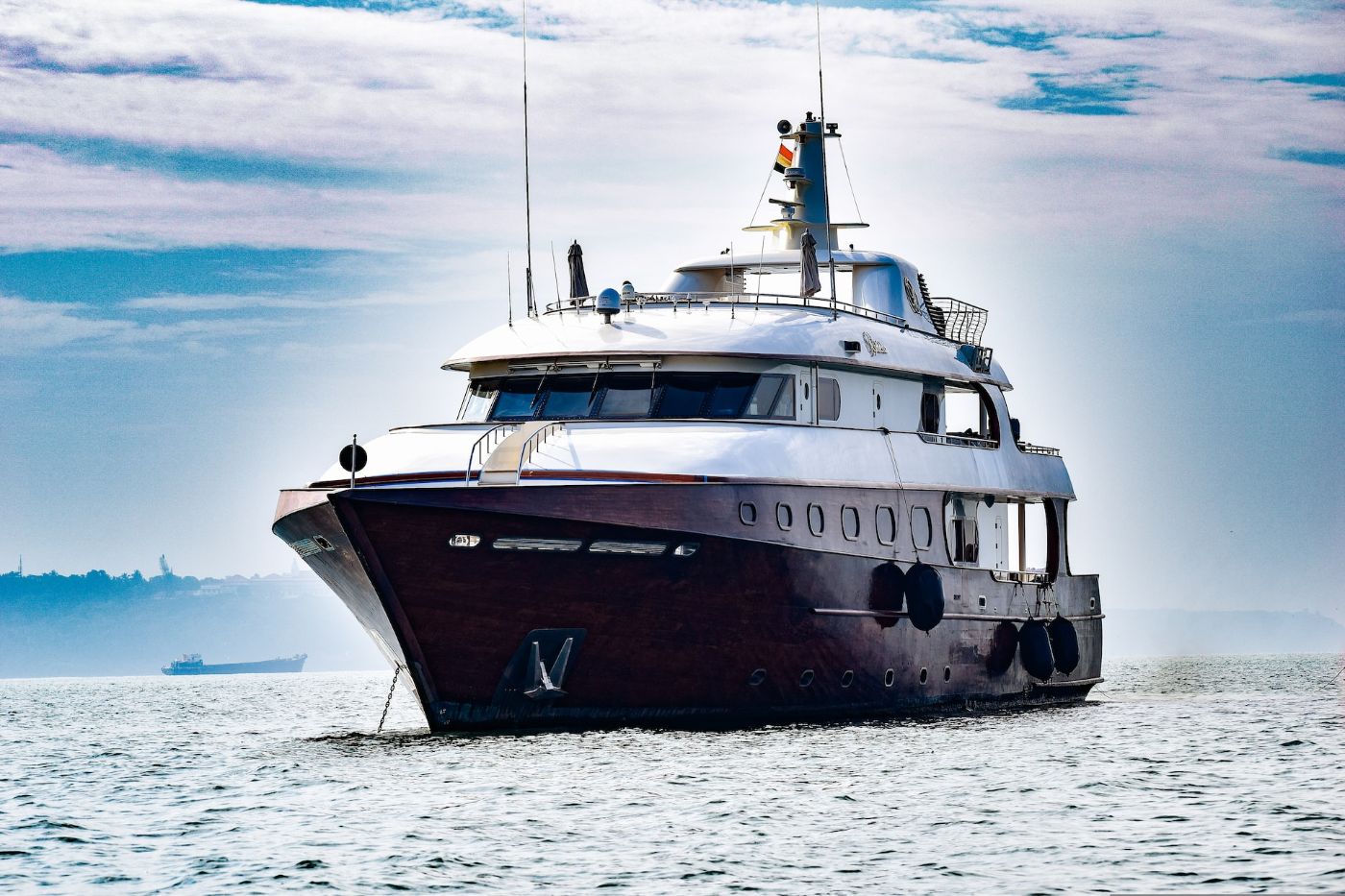
For recreational cruising, a crew of two to four people is usually sufficient . For larger yachts, there may be additional crew members such as a chef, stewardess, or engineer.
Crew size for yachts over 75 feet
Yachts that are over 75 feet in length generally require a crew to operate them safely. The exact number of crew members you will be based on the size and features of the yacht.
- A 90-foot yacht with multiple decks and luxury amenities may require a crew of 8-12 people, including a captain, first mate, chef, stewardess, and deckhand.
- A 100-foot yacht with advanced navigation and communication systems may require a crew of 10-15 people, including a captain, engineer, deckhand, chef, stewardess, and possibly a security officer.
- A 120-foot yacht with a helicopter pad, swimming pool, and other high-end features may require a crew of 12-20 people, including a captain, engineer, deckhand, chef, stewardess, helicopter pilot, and other specialized staff as needed.
Crew size for yachts over 300 feet
Bigger yachts require more crew members because they tend to be more complex and have more systems and equipment that need to be maintained and operated. Additionally, larger yachts typically have more amenities and features that require specialized staff, such as spa therapists, dive instructors, and security personnel.
A yacht that is 300 feet or more in length may have multiple decks, a helipad, a swimming pool, a movie theater, a gym, and other luxurious amenities that require a larger crew to operate and maintain.
In addition, larger yachts may require more crew members to ensure the safety of the guests and the vessel, especially when navigating in challenging waters or during adverse weather conditions. Larger yachts also often provide a higher level of service, which requires more crew members to ensure that every guest's needs are met.
Different types of yachts have different crew needs, which can depend on the yacht's size, features, and intended use. Here's what you need to know about yacht types and their crew needs:
Crew size for recreational yachts
Recreational yachts are typically smaller and used for leisure activities like fishing, cruising, and water sports. Yachts that are 30 feet or smaller can usually be operated by a single person without a crew.
However, larger recreational yachts, like those in the 50-100-foot range, may require a small crew for maintenance and management.
Crew size for sailing yachts
Sailboats are a popular type of yacht used for racing, cruising, and exploring. For sailing yachts between 30 and 50 feet, a crew of four to six is typically required. This crew would include a captain, a first mate, a cook, and one or two deckhands.

For yachts over 50 feet, the crew size can range from six to 20 or more. This is because some yachts may also have additional staff, such as a chef, a stewardess, and a masseuse. These staff members are typically hired to provide luxury services to guests onboard.
One of the hidden costs of buying and owning a 50-foot yacht is the costs for staff and crew, which ranges around $50,000 - $150,000 per year.
Crew size for superyachts
Superyachts are the largest and most luxurious yachts on the market, typically measuring over 100 feet in length. A small superyacht may have a crew of around 20 people, while a larger one may require a crew of 50 or more.
Larger superyachts with more amenities and more guests on board will require a larger crew to ensure that all aspects of the vessel are properly maintained and operated. The team will typically include a captain, first mate, engineer, chef, stewardesses, deckhands, and other specialized roles depending on the yacht's amenities.
Some owners may prefer a smaller crew to maintain a more intimate and personalized experience, while others may opt for a larger crew to ensure that all tasks are handled efficiently and to the highest standard.
Crew size for commercial yachts
Commercial yachts are required to have a crew size that is appropriate for the size and type of the vessel, as well as the number of passengers on board. The crew size can vary greatly depending on the yacht's size, amenities, and intended use.
In general, larger yachts will have a larger crew, while smaller yachts may only require a few crew members. For example, a small yacht that is used for day trips or short-term charters may only require a captain and a mate. However, a larger yacht used for extended charters or as a luxury hotel at sea may need a larger crew.
The crew size for commercial yachts is regulated by various maritime authorities, such as the International Maritime Organization (IMO) and the United States Coast Guard (USCG). These authorities have established minimum crew requirements based on the size and type of the yacht, as well as the number of passengers on board.

Based on USCG requirements, a commercial yacht that is less than 100 gross tons and carries up to 12 passengers must have at least one licensed captain and one crew member. If the yacht carries between 13 and 36 passengers, it must have at least two licensed crew members. For yachts that are over 100 gross tons, the crew size requirements will be higher.
A captain license costs around $700 - $800 , but this may vary according to the country as well as potential extras you might need to purchase.
Crew size for luxury yachts
Luxury yachts are designed for comfort and style, typically featuring high-end amenities like spas, gourmet kitchens, and entertainment systems.
Luxury yachts require a larger crew because they are typically larger, more complex, and more luxurious than other types of boats. A larger crew is necessary to ensure that everything runs smoothly and that the guests have an enjoyable and comfortable experience on board.
Here are some of the reasons why luxury yachts require a crew of 10-30 persons:
Safety: A larger crew is necessary to ensure the safety of the guests and the yacht. The crew must be trained and experienced in handling emergency situations, such as fires, medical emergencies, and adverse weather conditions.
Navigation: Luxury yachts require a skilled crew to navigate the vessel safely and efficiently. The captain and crew must be familiar with the yacht's systems, equipment, local waterways, and navigation rules.
Maintenance: Luxury yachts require constant maintenance to keep them in top condition. A larger crew is necessary to perform routine maintenance tasks, such as cleaning, painting, and repairing the yacht's systems and equipment.
Service: Luxury yachts are known for their high level of service and hospitality. A larger crew is necessary to provide guests with personalized service, including gourmet meals, housekeeping, and other amenities.
Entertainment: Luxury yachts often have a variety of entertainment options, such as water sports equipment, movie theaters, and music systems. A larger crew is necessary to operate and maintain these amenities, as well as to provide instruction and assistance to the guests.
The cost of hiring a full-time yacht crew can range from $50,000 to $200,000 per crew member per year. This includes their salary, benefits, and any other expenses associated with their employment, such as training and uniforms.
Here's a breakdown of the average annual salaries for different yacht crew positions:
The roles and responsibilities of the captain
- Responsible for the overall operation of the yacht including navigation, safety, and communication with other vessels
- Must have extensive knowledge of waterways
- Must make quick decisions in case of emergency
- Must hold valid Merchant Mariner Credential (MMC) issued by USCG
- For yachts over 100 gross tons, a captain must hold a USCG license for appropriate tonnage and route
- May need to hold specific endorsements, such as a towing endorsement or a radar observer endorsement
The roles and responsibilities of the captain engineer
- Responsible for mechanical systems on board the yacht such as engines, generators, and other equipment
- Must have a good understanding of how systems work
- Troubleshoots problems that arise
- Works closely with the captain and other crew members
- May be responsible for managing inventory and ordering spare parts and supplies
The roles and responsibilities of the stewardess
The stewardess is the first point of contact for guests and they are responsible for the following:
- Greet guests warmly and show them to their cabins
- Provide information about the yacht and its amenities, as well as local attractions and activities
- Clean and maintain guests' cabins
- Make beds and ensure fresh towels and linens
- Responsible for serving meals and drinks, setting the table, and clearing dishes
The roles and responsibilities of the deckhand
The deckhand is an entry-level position on a yacht and they work under the supervision of the first mate. They are responsible for a variety of tasks such as:
- Cleaning the yacht and handling lines and fenders
- Assisting with navigation and docking
- Maintaining the exterior of the yacht, such as washing and waxing the hull, cleaning the decks and windows, and maintaining the yacht's equipment and machinery
The roles and responsibilities of the chef

- Responsible for providing exceptional culinary experiences for guests
- Plans menus, prepares meals and manages galley and kitchen area
- Plans menus that meet the dietary preferences and restrictions of guests
- Creates menus for breakfast, lunch, and dinner, as well as snacks and appetizers
- Responsible for provisioning the yacht with fresh ingredients and supplies
- Prepares high-quality meals and presents them well
- Manages galley and kitchen area, including cleaning and maintaining the kitchen, managing inventory and ordering supplies, and ensuring that all equipment is in good working order
The roles and responsibilities of the first mate
- Considered as the second in command on a yacht
- Works closely with the captain to ensure the safe operation and navigation of the boat
- Responsible for managing crew and overseeing day-to-day activities on board
- Assists captain with navigation and piloting of yacht
- Monitors weather conditions, charts courses, and ensures the yacht is on track and avoiding potential hazards
- Manages crew and delegates tasks as needed
- May be responsible for scheduling and coordinating crew shifts, managing inventory and ordering supplies, and ensuring that the yacht is clean and well-maintained
- May serve as liaison between guests and captain, ensuring that their needs are met and that they have an enjoyable experience on board
The roles and responsibilities of the second mate
- Assists captain and first mate in navigation and operation of yacht
- Maintains the yacht's navigational equipment, including GPS, radar, and other electronic devices
- Ensures all charts and publications are up-to-date and that any necessary corrections or updates are made.
Leave a comment
You may also like, what-size-is-considered-a-yacht.

Do I Need a License to Drive a Boat? (Clear Info for 50 States)

Do You Need a License to Sail Around the World?

How Much Does It Cost To Get a Captain's License?
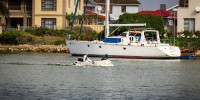
Cost of Buying & Owning a Small Yacht (Detailed Breakdown)
Own your first boat within a year on any budget.
A sailboat doesn't have to be expensive if you know what you're doing. If you want to learn how to make your sailing dream reality within a year, leave your email and I'll send you free updates . I don't like spam - I will only send helpful content.
Ready to Own Your First Boat?
Just tell us the best email address to send your tips to:
Exploring Yacht Size: Sail Solo Without a Crew
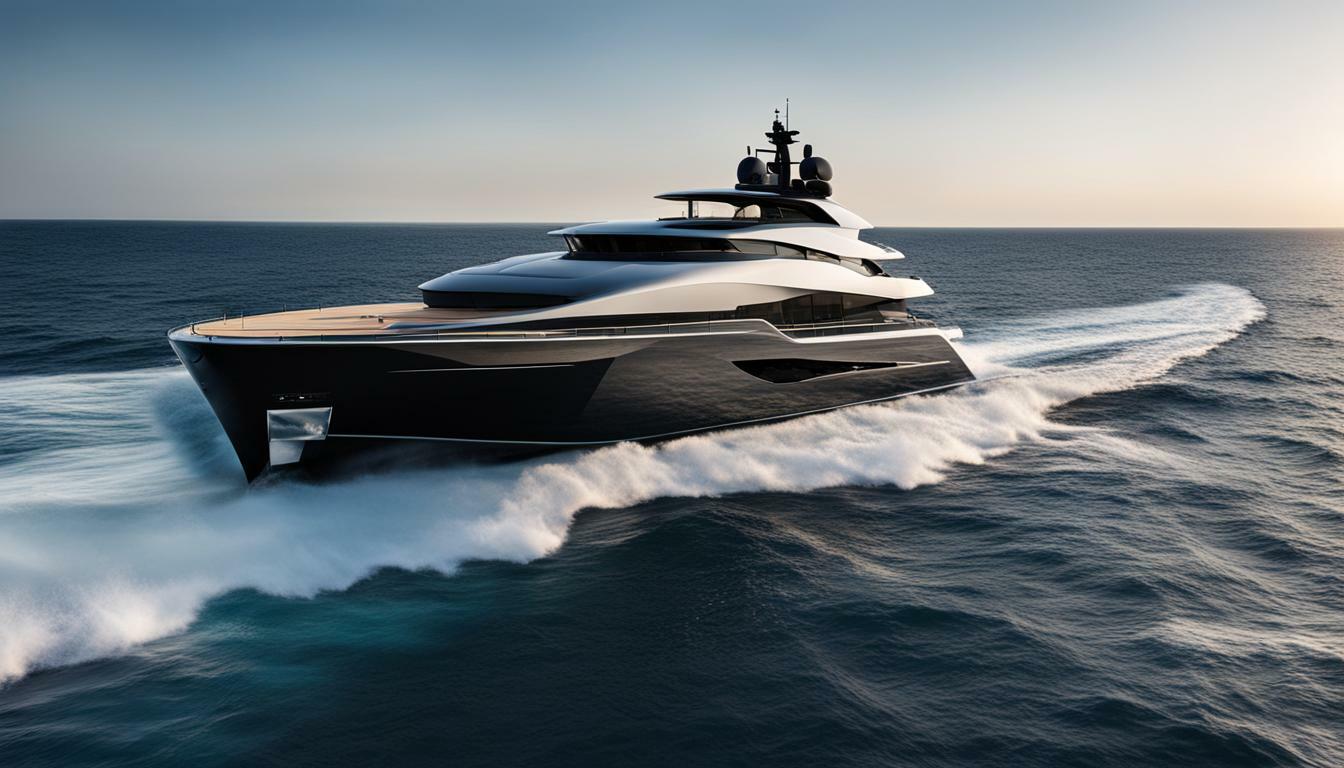
When it comes to sailing solo without a crew, selecting the right yacht size is crucial for a successful and enjoyable experience. The size of the yacht will depend on various factors, including individual preferences, budget, and sailing plans. Small yachts, typically between 35 to 45 feet, offer easier handling and maneuverability, making them ideal for solo sailors. On the other hand, larger yachts provide more speed, stability, carrying capacity, and comfort systems. However, they also come with higher purchase and ownership costs. It’s important to consider the choice between a monohull and a catamaran, with monohulls being more common for solo circumnavigation. Catamarans, on the other hand, offer comfort and stability at anchor but can be less comfortable in challenging weather conditions. Safety risks exist for both types of boats, and realistic risk assessment is essential. When selecting a yacht size, it is crucial to consider individual living space and performance requirements. Yachts under 25 feet are suitable for specialized adventures, while yachts between 25 to 45 feet are often considered the sweet spot for most cruisers, offering a balance between cost, comfort, and speed. Larger yachts over 50 feet provide more space and comfort but also come with higher costs. Ultimately, it is important to align the size of the yacht with personal sailing plans and budget.
Key Takeaways: 1. Selecting the right yacht size is crucial for solo sailing without a crew. 2. Small yachts offer easier handling and maneuverability, while larger yachts provide more speed and comfort. 3. Consider the choice between a monohull and a catamaran based on individual needs and preferences. 4. Assess safety risks realistically for both types of boats. 5. Choose a yacht size based on individual living space and performance requirements, considering specialized adventures or long-term lifestyles. 6. Yachts between 25 to 45 feet are often considered the sweet spot for most cruisers, offering a balance between cost, comfort, and speed. 7. Larger yachts over 50 feet provide more space and comfort but come with higher costs.
Factors to Consider for Solo Sailing
There are several important factors to consider when deciding on the dimensions of a crew-free yacht for solo sailing, including the size of luxury yachts that can be enjoyed without a crew. One of the primary considerations is the size of the yacht itself. Small boats, typically between 35 to 45 feet, are easier to handle and maneuver, making them a popular choice for solo sailors. They offer increased agility and responsiveness, allowing for greater control in various weather conditions.
On the other hand, larger yachts provide advantages such as increased speed, stability, and carrying capacity. With more space, they can accommodate additional comfort systems and tools that make handling easier. However, it is essential to keep in mind that larger boats come with higher purchase and ownership costs.
The choice between a monohull and a catamaran is another factor to consider. Monohulls are more commonly used for solo circumnavigation, offering a traditional sailing experience. Catamarans, on the other hand, provide comfort and stability at anchor, making them an excellent choice for those who prioritize leisurely cruising. It’s important to note that catamarans can be uncomfortable in rough conditions.
“When it comes to solo sailing, safety should always be a top priority. Assessing the risks associated with your chosen yacht size and understanding the safety features and equipment required is crucial for a safe and enjoyable solo sailing experience.”
Ultimately, the size of the yacht should align with an individual’s living space and performance requirements, as well as their overall sailing plans and budget. It is essential to consider both the practical aspects, such as handling and maneuverability, as well as personal preferences for comfort and functionality.
Benefits of Small Yachts for Solo Sailing
Opting for a smaller yacht size without crew offers numerous advantages for solo sailors, including enhanced handling capabilities and smaller dimensions suitable for crew-free sailing. Smaller yachts, typically ranging from 25 to 45 feet, provide greater maneuverability, allowing solo sailors to navigate tight spaces and handle the boat with ease.
These compact dimensions also make small yachts more manageable for single-handed sailing, as they require less physical effort to operate. Additionally, smaller yachts tend to have shallower drafts, allowing access to shallower anchorages and secluded coves that larger boats may not be able to reach. This enables solo sailors to explore lesser-known destinations and enjoy more intimate sailing experiences.
Furthermore, smaller yachts often come with lower purchase and ownership costs, making them more budget-friendly for solo sailors. Maintenance, docking fees, and insurance premiums are generally lower for smaller vessels compared to larger luxury yachts. This allows solo sailors to allocate their financial resources towards other aspects of their sailing adventures, such as exploring new destinations or investing in upgraded equipment.
In summary, opting for a smaller yacht size without crew provides solo sailors with increased maneuverability, accessibility to unique locations, and cost-saving benefits. It allows for a more intimate and personal sailing experience, while still providing the necessary comfort and functionality for solo sailing adventures.
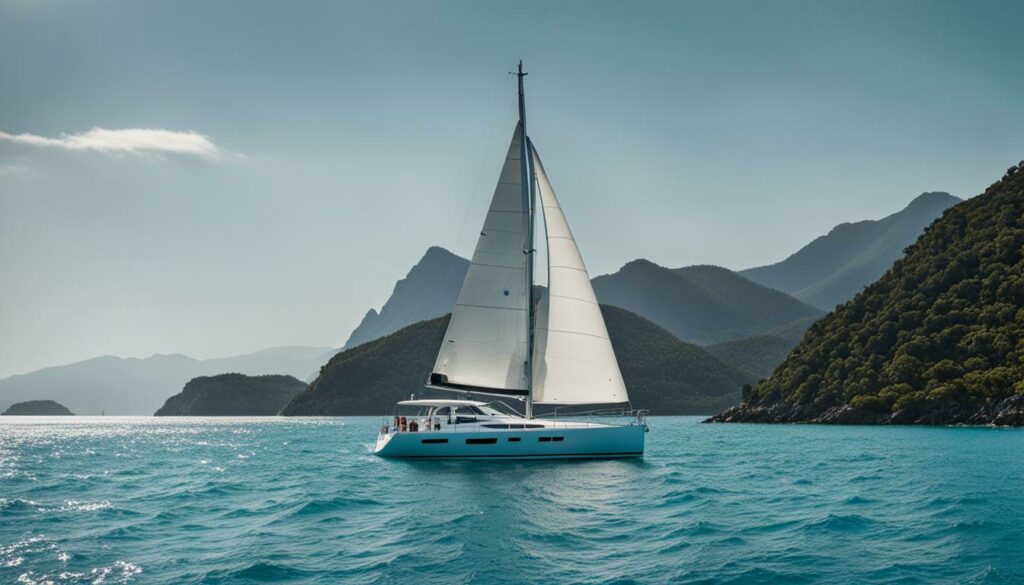
While smaller yachts have their advantages, larger yacht sizes without a crew offer greater speed, stability, carrying capacity, and access to advanced comfort systems and tools for ease of handling. For solo sailors looking to cover long distances quickly, larger yachts provide the necessary speed to navigate through different weather conditions effectively. With a larger sail area and more powerful engines, these yachts can maintain higher speeds, allowing solo sailors to reach their destinations in a shorter amount of time.
In terms of stability, larger yachts are less prone to rolling and pitching motions, providing a smoother and more comfortable sailing experience. This stability becomes especially important when sailing in rough seas or adverse weather conditions, as it reduces the risk of capsizing or losing control of the yacht. Additionally, larger yachts offer a higher carrying capacity, allowing solo sailors to bring along more supplies, equipment, and personal belongings for extended journeys. The additional storage space also comes in handy for stowing safety equipment and spare parts.
One of the major advantages of larger yachts without a crew is the availability of advanced comfort systems and tools that make handling easier for solo sailors. These yachts often come equipped with features such as electric winches, automated rigging systems, and bow thrusters, which streamline sailing operations and minimize physical exertion. This means that solo sailors can handle larger yachts single-handedly without the need for additional crew members.
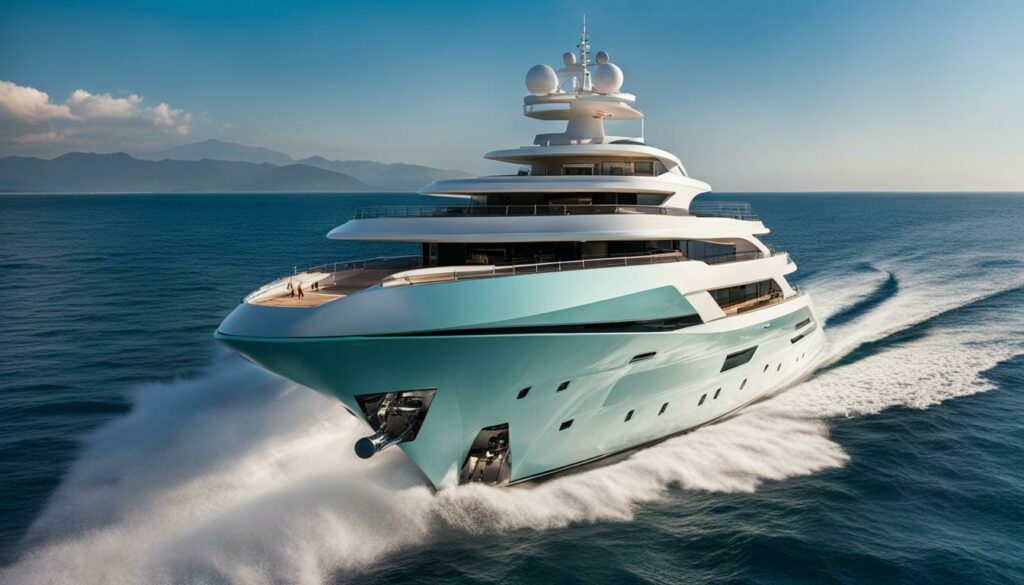
However, it’s important to note that larger yacht sizes also come with higher purchase and ownership costs. The initial investment for a larger yacht is typically higher, and maintenance, marina fees, and insurance costs can also be more substantial. It’s crucial for solo sailors to consider their budget and financial capabilities when deciding on the dimensions of their yacht without a crew. Striking a balance between the desired size and the associated costs is key to ensuring a sustainable sailing experience.
Considerations for Monohulls and Catamarans
When considering yacht size without a crew, it’s important to consider the pros and cons of monohulls and catamarans to find the right fit for your solo sailing adventure. Monohulls, which are traditional single-hulled boats, are more commonly used for solo circumnavigation. They offer a sense of simplicity and are known for their good upwind performance. On the other hand, catamarans, which have two hulls, provide greater comfort and stability at anchor.
When selecting the right yacht size without a crew, it’s important to consider the trade-offs between monohulls and catamarans. If you prioritize simplicity, good upwind performance, and lower maintenance costs, a monohull may be the better choice. However, if comfort, stability, and spacious living areas are your main concerns, a catamaran may be more suitable. Ultimately, the decision should be based on your individual preferences, sailing plans, and budget.
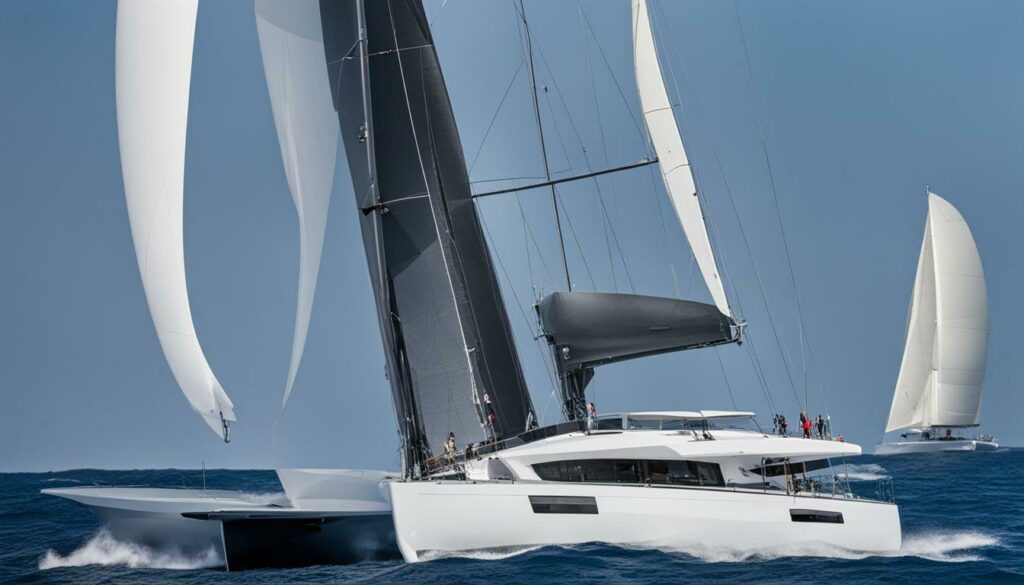
When it comes to solo sailing, choosing the right yacht size without a crew is essential. Small boats, typically ranging from 35 to 45 feet, are easier to handle and maneuver. They offer a sense of independence and are well-suited for solo adventurers who prefer a more hands-on approach. These smaller yachts provide the freedom to explore secluded anchorages and navigate narrow channels with ease.
On the other hand, larger yachts offer advantages in terms of speed, stability, and carrying capacity. They come equipped with more comfort systems and tools to make handling easier. However, it’s important to consider that bigger boats come with higher purchase and ownership costs. These larger yachts require more crew or advanced sailing skills to operate efficiently.
The choice between a monohull and a catamaran is another factor to consider. Monohulls are more common for solo circumnavigation due to their simplicity and traditional appeal. Catamarans, on the other hand, offer increased comfort and stability at anchor, making them popular choices for extended cruising. However, they can be uncomfortable in heavy seas and may have higher purchase and maintenance costs.
When choosing the size of your yacht without a crew, it’s important to assess the risks realistically and prioritize your individual living space and performance requirements. Yachts under 25 feet are suitable for specialized adventures rather than long-term lifestyles. Yachts between 25 to 45 feet are considered the sweet spot for most cruisers, offering a balance between cost, comfort, and speed. Yachts over 50 feet provide more space and comfort but come with higher costs.
Safety Considerations for Solo Sailing
Solo sailors must carefully evaluate the safety risks associated with both monohulls and catamarans, taking into account the dimensions of crewless luxury yachts and considering any potential safety concerns. When sailing alone, it’s important to have a yacht that is capable of handling the demands of solo navigation, ensuring a safe and enjoyable experience.
Monohulls are a popular choice for solo circumnavigation due to their simplicity and reliability. With their single hull design, they offer stability in rough seas and have a long history of successful solo journeys. However, it’s crucial to choose a monohull that is suitable for solo sailing, considering factors such as size, weight, and handling characteristics.
Catamarans, on the other hand, provide added comfort and stability at anchor. Their dual-hull design offers more living space and allows for better weight distribution, making them suitable for extended periods on board. However, it’s important to note that catamarans can be less comfortable in challenging conditions, as they are more prone to slamming and may require additional attention to maintain stability.
Regardless of the chosen yacht type, solo sailors should always prioritize safety when considering dimensions. It’s essential to assess the yacht’s stability, maneuverability, and self-sufficiency. Safety features such as adequate lifelines, grab rails, and easy access to essential equipment should also be considered. Additionally, taking into account weather conditions, route planning, and emergency preparedness are vital for a safe solo sailing experience.
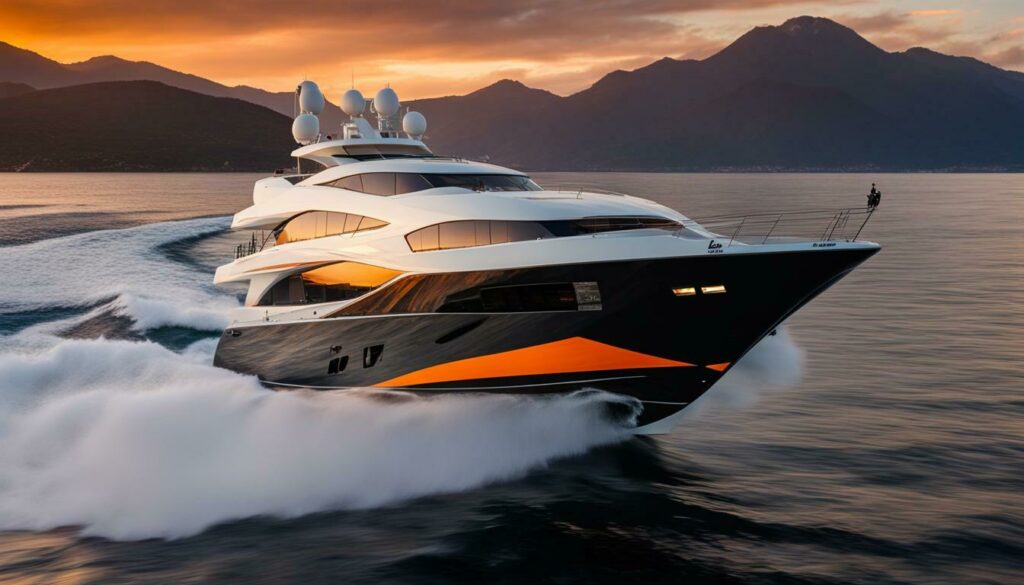
Ultimately, the dimensions of crewless luxury yachts should align with the individual’s sailing abilities, preferences, and safety requirements. By carefully evaluating these factors, solo sailors can make an informed decision that ensures a safe and enjoyable journey on the open seas.
Tailoring Yacht Size to Individual Needs
The ideal yacht size without a crew should be based on individual preferences, including the desired living space and performance requirements for solo sailing adventures. When considering the dimensions of a crew-free sailing yacht, it’s important to strike a balance between comfort, maneuverability, and cost.
For those looking for specialized adventures rather than long-term lifestyles, yachts under 25 feet can offer unique sailing experiences. These compact vessels are perfect for exploring shallow waters and secluded coves. Their smaller dimensions also make them more affordable in terms of purchase and ownership costs. Plus, their maneuverability allows for easy navigation in tight spaces.
On the other hand, yachts between 25 to 45 feet are the sweet spot for most cruisers. They provide a comfortable living space while still being manageable for solo sailors. These dimensions offer a good balance between cost, comfort, and speed, making them versatile options for different sailing plans.
For those seeking more space and luxury, larger yachts over 50 feet can provide the ultimate sailing experience. With their increased dimensions, these yachts offer ample living space, stability, and carrying capacity. However, it’s important to keep in mind that larger vessels come with higher purchase and ownership costs. It’s crucial to align the yacht size with individual budget constraints.
When choosing the ideal dimensions for a yacht without a crew, it’s essential to consider personal preferences and sailing goals. Whether it’s a compact vessel for specialized adventures or a spacious yacht for long-term cruising, finding the right size will ensure a memorable and enjoyable solo sailing experience.
Specialized Adventures with Small Yachts
Yachts under 25 feet in size are ideal for those seeking specialized adventures rather than long-term lifestyles, offering compact dimensions suitable for crewless motor yachts and the pursuit of unique sailing experiences. These small yachts provide the perfect opportunity to explore hidden coves, navigate shallow waters, and venture into tighter spots that larger vessels may not be able to access.
With their nimble handling and maneuverability, small yachts are well-suited for sailing in rivers, lakes, and coastal areas. They can be easily trailered, allowing for effortless transport and the ability to explore different bodies of water. Whether you’re planning a weekend getaway, fishing trip, or solo exploration, these small yachts offer the freedom and flexibility to create unforgettable memories on the water.
If you’re interested in embarking on specialized adventures such as fishing expeditions or day sailing trips, yachts under 25 feet provide the perfect platform. With their compact dimensions, these crewless motor yachts offer efficiency and versatility, allowing you to navigate with ease and focus on the activities you love. From casting a line in search of the perfect catch to enjoying a leisurely day under sail, these small yachts offer endless possibilities for exciting and unique experiences.
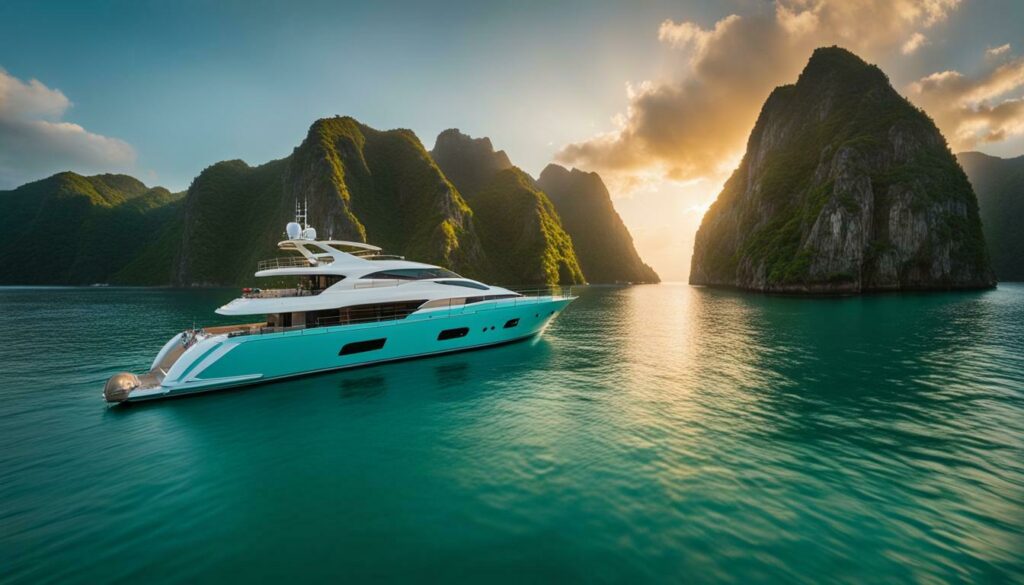
The Sweet Spot: Yachts between 25 to 45 feet
For the majority of solo sailors, yachts between 25 to 45 feet offer the perfect balance between cost, comfort, and speed, making them the ideal dimensions for crewless sailing yachts. These boats provide enough space to accommodate essential amenities and equipment while remaining manageable for single-handed sailing. With their moderate size, they strike a balance between being nimble enough to handle in various conditions and offering the necessary stability for extended journeys.
Yachts in this size range often come with a range of features and capabilities that cater to the needs of solo sailors. They typically offer comfortable living spaces, including sleeping quarters, a galley, and a bathroom, providing all the essentials for extended stays at sea. Additionally, they have sufficient storage capacity to carry food, clothing, and equipment, ensuring self-sufficiency during long voyages.
The dimensions of crewless yachts between 25 to 45 feet also contribute to their affordability. These boats are more cost-effective to purchase and maintain compared to larger vessels. Additionally, their moderate size leads to lower docking and mooring fees, making them a practical choice for solo sailors on a budget.
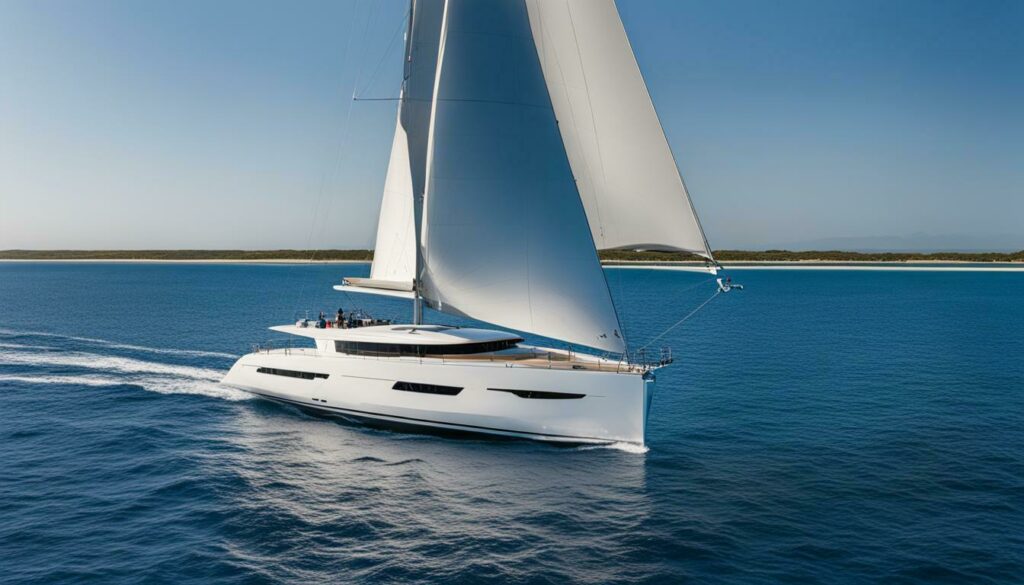
In terms of speed, yachts in this size range offer adequate performance. They are designed to strike a balance between speed and stability, allowing solo sailors to navigate efficiently and comfortably. While larger yachts may offer more speed, the difference is often not significant enough to justify the higher costs associated with increased dimensions.
Ultimately, when it comes to solo sailing without a crew, it is crucial to choose a yacht size that meets individual requirements. Yachts between 25 to 45 feet provide the perfect dimensions for most solo sailors, striking a balance between cost, comfort, and speed. Whether embarking on adventurous expeditions or leisurely cruises, these crewless sailing yachts offer the ideal platform for unforgettable solo sailing experiences.
The Allure of Larger Yachts
Larger yacht sizes over 50 feet offer a greater amount of space and comfort for solo sailors, but it’s essential to be aware of the higher costs that come with these crew-free superyacht dimensions . If you prioritize luxurious amenities and spacious living quarters, a larger yacht might be the perfect choice for your solo sailing adventure. These yachts provide ample room for relaxation and entertainment, with multiple cabins, gourmet kitchens, and expansive deck spaces.
One of the key advantages of larger yachts is the increased carrying capacity they offer. With more storage space, you can bring along all the necessary supplies for extended voyages without sacrificing comfort. These yachts are also equipped with advanced technology and systems to enhance your sailing experience, such as stabilizers for a smoother ride, advanced navigation tools, and powerful engines for increased speed.
However, it’s important to consider the financial implications of owning a larger yacht. The purchase price, maintenance costs, insurance, and mooring fees can be significantly higher compared to smaller vessels. It’s crucial to factor in these additional expenses when determining the feasibility of owning and operating a crew-free superyacht. Careful budgeting and financial planning are necessary to ensure a seamless and enjoyable solo sailing experience.
Ultimately, the decision to choose a larger yacht for solo sailing depends on your personal preferences, sailing goals, and budget. If space, comfort, and luxurious amenities are of utmost importance, and you are willing to invest in the additional costs, a crew-free superyacht can provide an unparalleled sailing experience. However, it’s essential to carefully evaluate the financial implications and ensure that the dimensions of a larger yacht align with your long-term plans and budget.
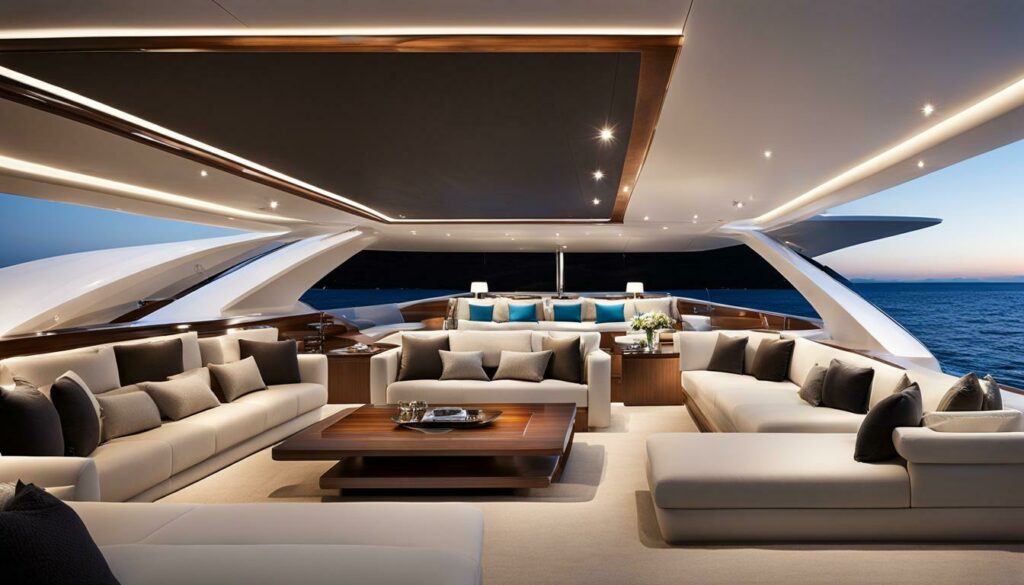
Selecting the appropriate yacht size without a crew should be a careful decision that takes into account individual sailing plans and budget, ensuring that the dimensions of luxury yachts align with personal preferences and financial considerations. When it comes to solo sailing, finding the right balance between size, cost, and comfort is essential.
For most cruisers, yachts between 25 to 45 feet offer the ideal dimensions. They provide a sweet spot in terms of cost, comfort, and speed. These yachts are large enough to offer a comfortable living space, yet small enough to be easily handled and maneuvered by a single sailor. They strike the perfect balance for adventurers who seek independence without compromising on necessary amenities.
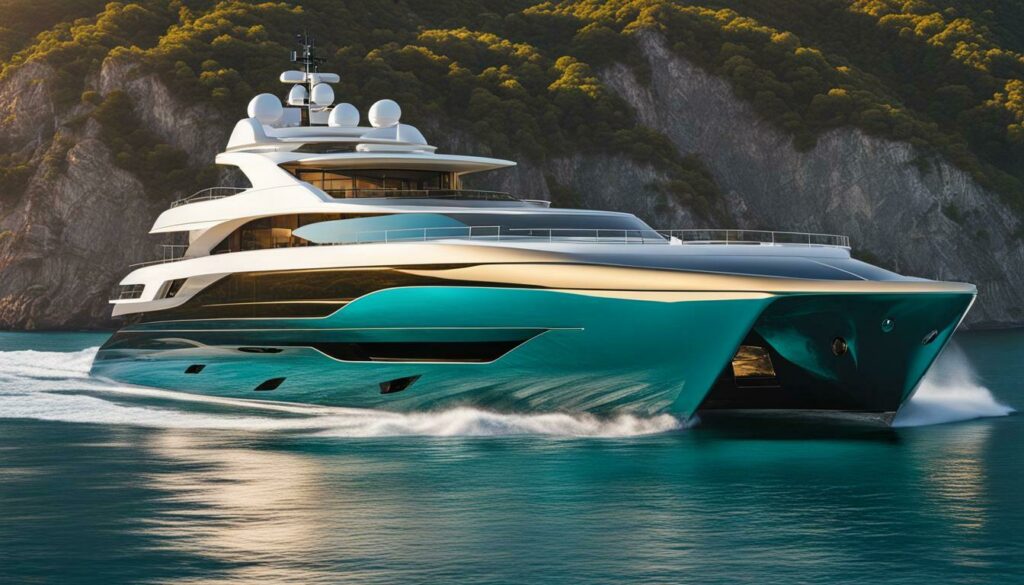
However, it’s important to consider that larger yachts, typically over 50 feet, offer more space and comfort. These dimensions come with higher purchase and ownership costs, including maintenance, insurance, and other expenses. It’s crucial to assess the financial feasibility of owning a larger yacht and ensure it aligns with the intended sailing plans and budget.
When considering yacht size, the choice between a monohull and a catamaran is another factor to keep in mind. Monohulls are more common for solo circumnavigation, while catamarans offer enhanced comfort and stability at anchor. Each option has its advantages and disadvantages, and personal preferences play a crucial role in deciding the dimensions of the yacht.
In summary, choosing the perfect yacht size without a crew involves considering individual sailing plans and budget. It necessitates finding the right balance between cost, comfort, and performance requirements. By aligning the dimensions of luxury yachts with personal preferences and financial considerations, solo sailors can embark on their adventures with confidence and peace of mind.
Choosing Your Perfect Yacht Size
With the information provided, it’s time to choose your perfect yacht size without a crew, considering the range of dimensions available for crew-free sailing and finding the one that fits your unique requirements. When it comes to yacht size for solo sailing, there is no one-size-fits-all answer. However, there are a few key considerations that can guide your decision-making process.
Firstly, think about the handling and maneuverability of the yacht. Smaller boats, typically between 25 to 45 feet, are easier to handle and maneuver, making them more suitable for solo sailors who may not have assistance on board. These boats are often more cost-effective and easier to maintain.
On the other hand, larger yachts can offer increased speed, stability, and carrying capacity. They also provide more space and comfort systems, making extended solo sailing more enjoyable. However, it’s important to consider that larger boats come with higher purchase and ownership costs, both in terms of initial investment and ongoing expenses such as fuel, maintenance, and insurance.
Another aspect to consider is the choice between a monohull and a catamaran. Monohulls are more common for solo circumnavigation, as they offer better upwind performance and are known for their seaworthiness. Catamarans, on the other hand, provide greater comfort and stability at anchor, but they can be less comfortable in certain weather conditions. Assessing the risks and the specific requirements of your sailing plans is crucial in making the right choice between these two types of boats.
Factors to Consider for Choosing Yacht Size Without a Crew:
- Handling and maneuverability
- Speed, stability, and carrying capacity
- Space and comfort systems
- Initial and ongoing costs
- Choice between monohulls and catamarans
With these factors in mind, take the time to assess your living space and performance requirements as an individual sailor. Consider the specific adventures you have in mind and how the chosen yacht size will support your goals. Whether you prefer smaller vessels for specialized adventures or larger yachts for extended cruising, finding the right dimensions is essential to ensuring a safe and enjoyable solo sailing experience.
Remember, there is no one-size-fits-all answer, but by considering these factors and aligning your yacht size with your plans and budget, you can embark on the journey of a lifetime with confidence and excitement. Happy sailing!
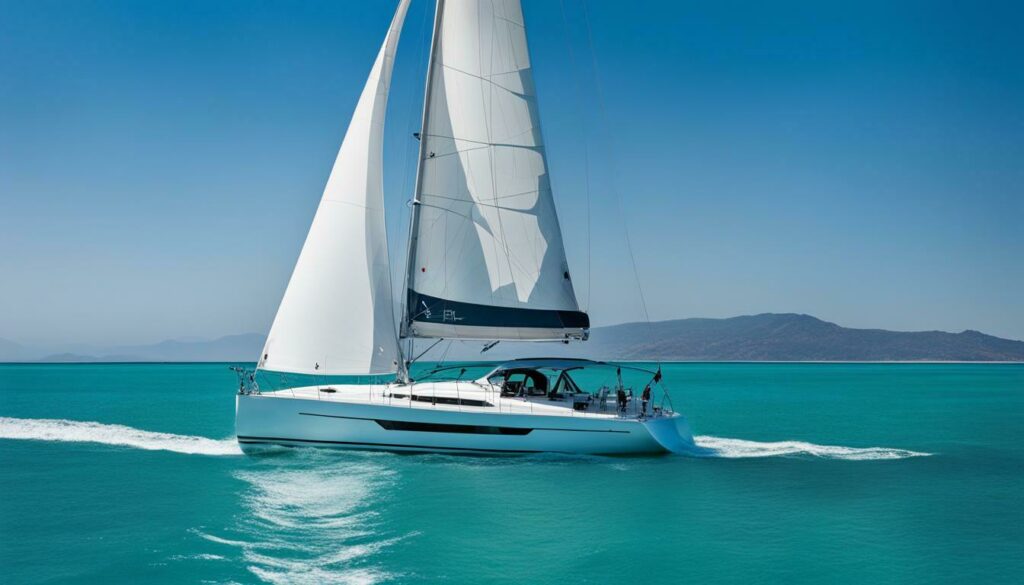
When it comes to sailing solo without a crew, choosing the right yacht size is essential. While there is no one-size-fits-all answer, the most common size range for solo sailing is between 35 to 45 feet. Small boats are easier to handle and maneuver, while larger boats offer more speed, stability, and carrying capacity. Bigger boats can also have more comfort systems and tools to make handling easier. However, larger boats come with higher purchase and ownership costs.
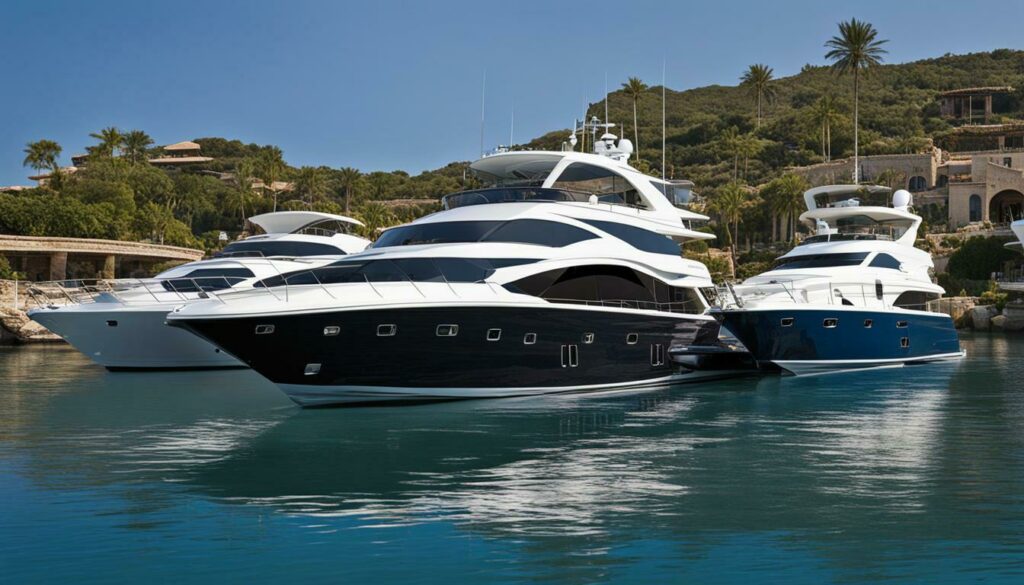
Exploring yacht ownership costs is an important step in selecting the appropriate yacht dimensions for crew-free motor yachts and crew-free superyachts, considering expenses such as maintenance, insurance, and other financial obligations. Owning a yacht involves regular maintenance and servicing to ensure its optimal performance and longevity. This includes routine inspections, cleaning, and repairs to keep the vessel in top condition. Insurance is also a crucial aspect of yacht ownership, protecting against unforeseen events, accidents, and damage. Additionally, there are other associated costs, such as docking fees, fuel, crew (if needed), and any ongoing upgrades or modifications.
Considering these expenses is crucial when selecting the dimensions of crew-free motor yachts and crew-free superyachts. It’s important to determine the budget available for yacht ownership and the ongoing costs that will be incurred. By carefully assessing ownership costs and aligning them with personal financial capabilities, individuals can make an informed decision about the size of the yacht that best suits their needs and budget. Ultimately, the dimensions of the yacht should provide both an enjoyable sailing experience and a sustainable ownership journey.
The Freedom of Solo Sailing
Solo sailing offers a remarkable sense of freedom and independence, allowing sailors to explore the vast oceans with crew-free yachts that perfectly fit their solo sailing dimensions. When choosing the right yacht size for solo adventures, there are various factors to consider. Small boats, typically ranging from 25 to 45 feet, are easier to handle and maneuver. They offer flexibility and agility, enabling solo sailors to navigate through tight spaces and challenging conditions.
Larger boats, on the other hand, provide advantages such as increased speed, stability, and carrying capacity. With more space, comfort systems, and tools, handling becomes easier for those looking for a more luxurious sailing experience. However, it is important to note that bigger boats come with higher purchase and ownership costs. These costs include maintenance, insurance, fuel, and docking fees, among others. Therefore, it is crucial to align the size of the yacht with personal sailing plans and budget constraints.
When deciding between a monohull and a catamaran, it is worth considering the type of sailing experience desired. Monohulls are commonly used for solo circumnavigation due to their seaworthiness and sailing performance. On the other hand, catamarans offer increased comfort and stability at anchor, but may be less comfortable in rough weather conditions. Safety is a paramount concern for solo sailors, and it is essential to assess the risks associated with both types of boats realistically.
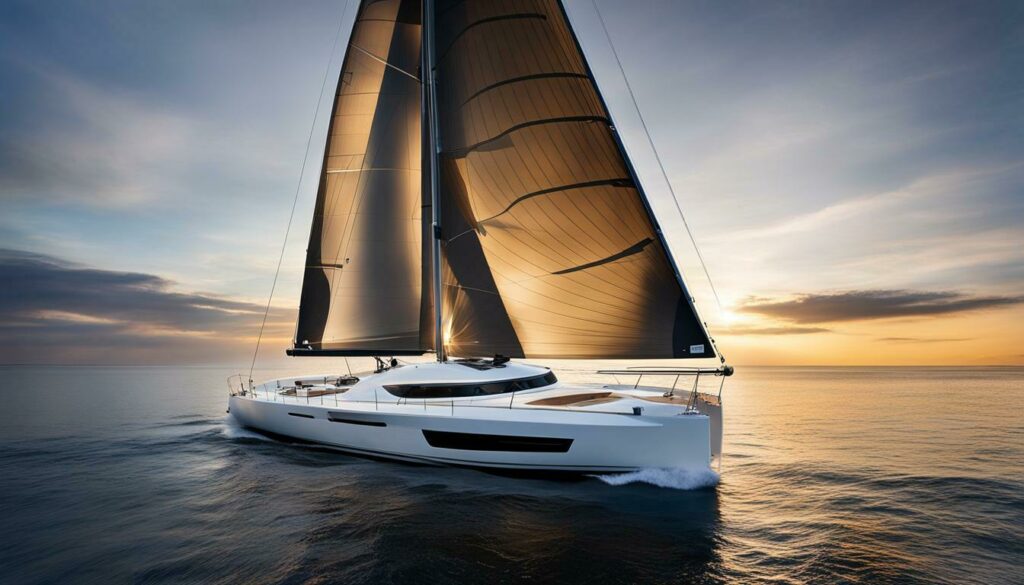
Ultimately, selecting the perfect yacht size without a crew depends on individual living space and performance requirements. Whether it’s a small boat for specialized adventures or a larger vessel for long-term cruising, finding the right dimensions ensures a satisfying and safe solo sailing experience. So set sail and embrace the freedom that comes with solo sailing, as you navigate the open seas in your crew-free yacht perfectly suited to your chosen dimensions.
In conclusion, choosing the right yacht size without a crew is a personal decision that should take into account individual requirements, acknowledging the dimensions of crew-free yachts and aligning them with personal preferences, plans, and budget.
When it comes to solo sailing, the size of the yacht plays a crucial role in the overall experience. Small yachts, typically between 25 to 45 feet, offer easier handling and maneuverability, making them ideal for solo adventurers. They strike a balance between cost, comfort, and speed, providing an enjoyable sailing experience without compromising on essentials.
On the other hand, larger yachts over 50 feet provide more spacious living areas, increased comfort, and additional amenities. They offer faster speeds, greater stability, and enhanced carrying capacity. However, it’s important to note that these larger dimensions come with higher purchase and ownership costs.
When deciding between a monohull and a catamaran, consider the sailing plans and conditions you’ll be encountering. Monohulls are more commonly used for solo circumnavigation, while catamarans offer increased comfort and stability at anchor. Both options have their pros and cons, so it’s vital to realistically assess the safety risks and select the dimensions that best suit your needs.
Ultimately, the choice of yacht size should be guided by individual living space and performance requirements. Specialized adventures can be enjoyed with yachts under 25 feet, while the sweet spot for most cruisers lies between 25 to 45 feet. However, if space and comfort are paramount, larger yachts may be the preferred option, despite the higher costs involved.
By carefully considering these factors and aligning them with personal preferences, plans, and budget, solo sailors can find the perfect yacht size that will enable them to embark on their sailing adventures with confidence and freedom.
Q: What is the most common size range for solo sailing without a crew?
A: The most common size range for solo sailing without a crew is between 35 to 45 feet.
Q: What are the benefits of smaller yachts for solo sailing?
A: Smaller yachts are easier to handle and maneuver.
Q: What are the advantages of larger yachts for solo sailing?
A: Larger yachts offer more speed, stability, carrying capacity, and comfort systems.
Q: Should I choose a monohull or a catamaran for solo sailing?
A: Monohulls are more common for solo circumnavigation, while catamarans offer comfort and stability at anchor.
Q: What are the safety considerations for solo sailing?
A: Safety risks exist for both monohulls and catamarans, and it’s important to assess the risks realistically.
Q: How should I tailor the yacht size to my individual needs?
A: The size of the yacht should be based on individual living space and performance requirements.
Q: Are yachts under 25 feet suitable for long-term lifestyles?
A: Yachts under 25 feet are more suitable for specialized adventures rather than long-term lifestyles.
Q: What is the sweet spot for most cruisers when it comes to yacht size?
A: Yachts between 25 to 45 feet offer a balance between cost, comfort, and speed.
Q: What are the allure and costs of larger yachts?
A: Larger yachts provide more space and comfort but come with higher costs.
Q: How should I choose the perfect yacht size?
A: Consider your sailing plans and budget, and find the dimensions that best suit your needs.
Q: What are the costs associated with yacht ownership?
A: Yacht ownership costs include maintenance, insurance, and other expenses.
Q: What is the freedom of solo sailing?
A: Solo sailing offers freedom and independence to explore unique experiences and adventures.
Source Links
- https://www.windward-islands.net/blog/boat-size-sail-around-world/
Baron Cooke has been writing and editing for 7 years. He grew up with an aptitude for geometry, statistics, and dimensions. He has a BA in construction management and also has studied civil infrastructure, engineering, and measurements. He is the head writer of measuringknowhow.com
Leave a Reply Cancel reply
Your email address will not be published. Required fields are marked *
Save my name, email, and website in this browser for the next time I comment.

Robb Report
8 Fascinating Facts About ‘Kokomo,' the Lightning-Fast 192-Foot Sailing Superyacht
Posted: March 15, 2024 | Last updated: March 15, 2024
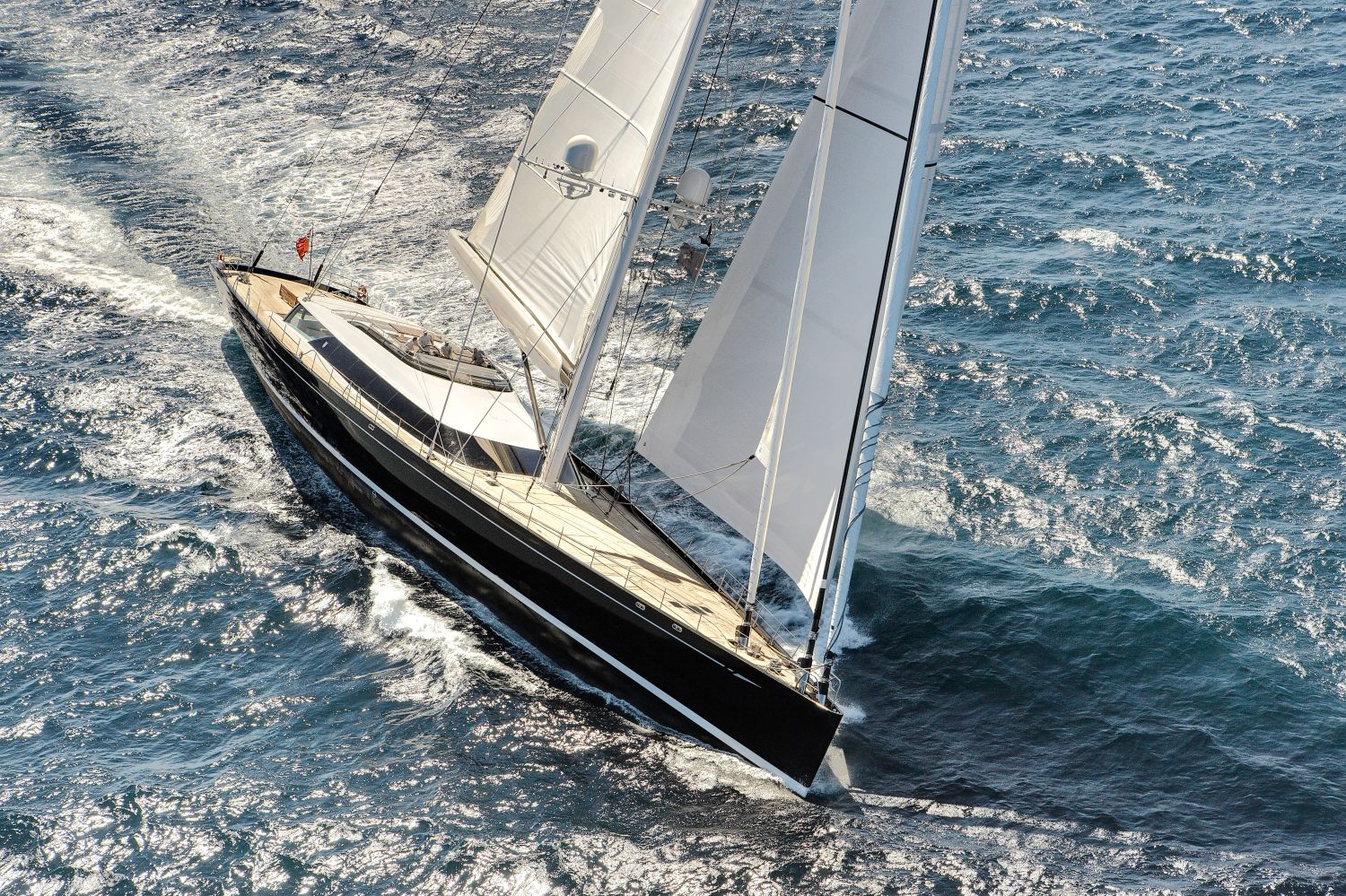
2.-SY-Kokomo_Sailing_1-064
The 192-foot Kokomo was the second largest sloop in the world when it launched from New Zealand’s Alloy Yachts shipyard in 2010. It remains the largest fast-cruising sloop available for charter. The yacht’s commissioning owner Lang Walker (who died in January 2024) was a seasoned sailor who gave all three of his yachts the same name.
The first was a 131-foot sloop, which Walker replaced five years later with a 171-footer. The same day he took delivery of his 171-foot sloop, he placed an order for the third and final 192-foot Kokomo, which he planned to use for racing and cruising around the world. He also kept the same design team for all three yachts, with exterior and naval architecture by Ed Dubois and interior by UK’s RWD.
The reference to the yacht’s name has had different explanations over the years, ranging from the pseudonym of a composer whose music Walker played as a child to a nod to the Beach Boys’s song from their 1988 album Still Cruisin’, which references a fictional utopian island called Kokomo. The island fantasy was brought to life in 2011 when Walker acquired a private island in Fiji’s Great Astrolabe Reef and named it Kokomo.
Here are eight unknown facts about one of the most game-changing sailing yachts on the water.
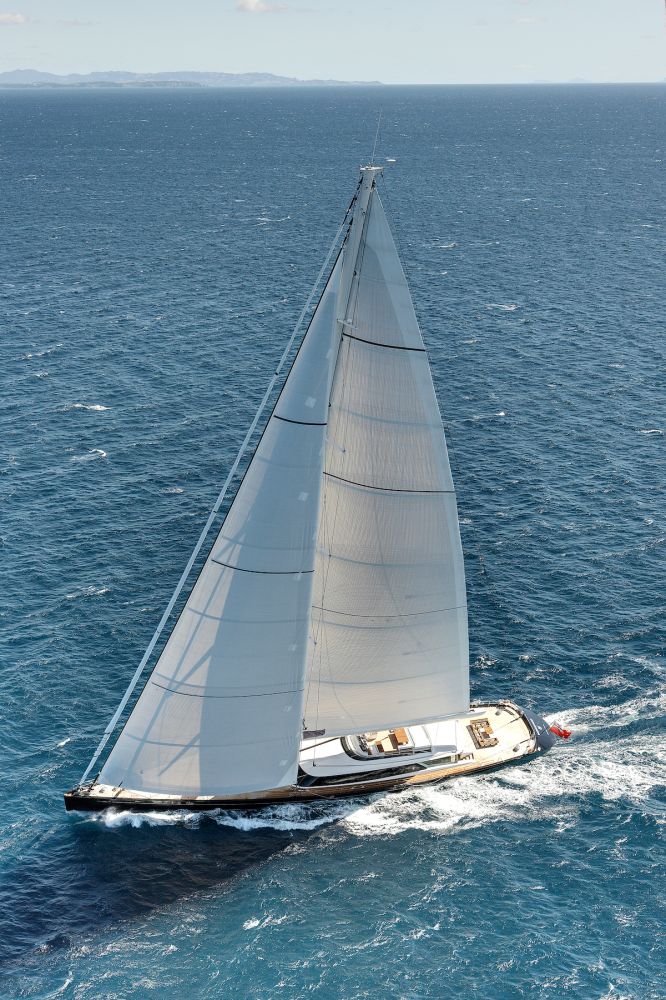
You’re Going to Need a Bigger Boom
When Kokomo was launched, she was the second-largest sloop in the world and carried the largest set of sails made by Doyle Sails in New Zealand. The 23,971-square-foot asymmetric spinnaker is half the size of a professional football field, while the 9,688-square-foot mainsail needs a crane to lift it. Because of the gargantuan size of the sails, the designers entered a new era of spar and winch design, having to “reinvent” the deck equipment—winches, mast, boom, rigging and sails—to cope with the 31.6-ton load on the genoa sheet and 32-ton load on the main sheet clew. The 244-foot carbon mast is the largest ever made by Southern Spars.
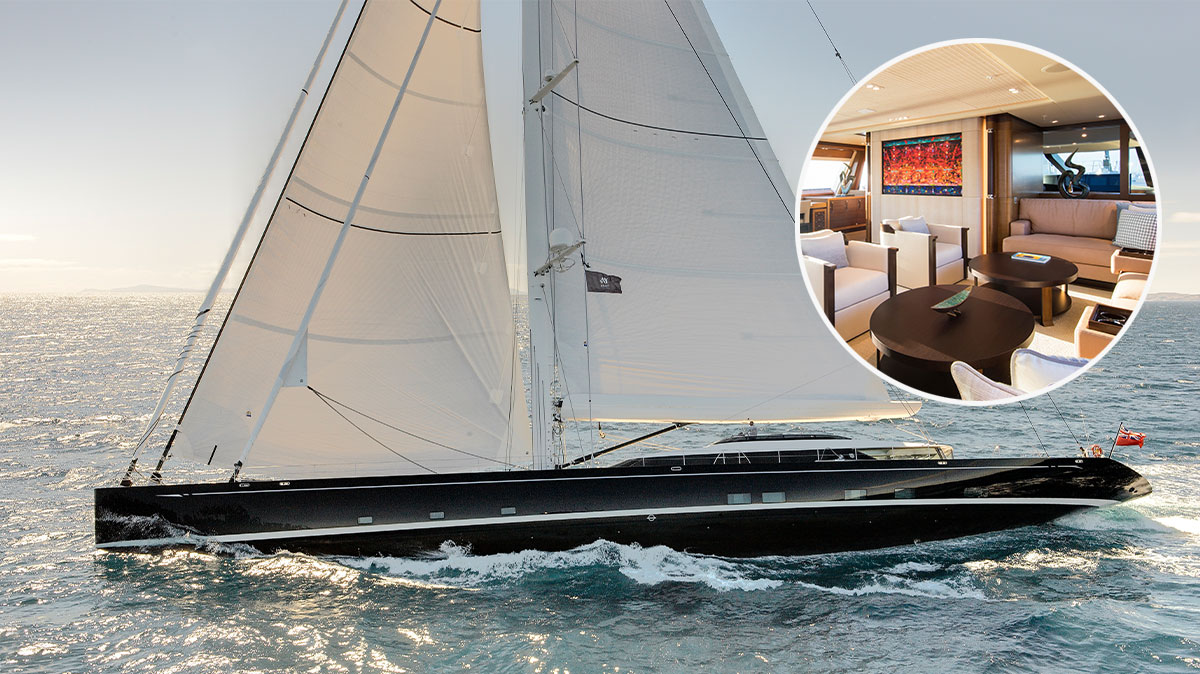
A Hidden Lifting Keel
The yacht’s 130-ton lifting keel is one of its most impressive features, though it’s largely left to the imagination. The interior layout is carefully designed so that the keel structure remains hidden. Dubois Naval Architects positioned the keel box to come above the main deck, serving as a partial separation between the bridge and the main salon (see inset). Kokomo was only the second yacht to be fitted with a lifting a keel, the first being 246-foot M5 (ex-Mirabella V), the world’s largest single-masted sailing yacht. This innovative design shortens Kokomo’s 28.5-foot draft when the keel is fully extended, to just 15 feet for shallow waters.
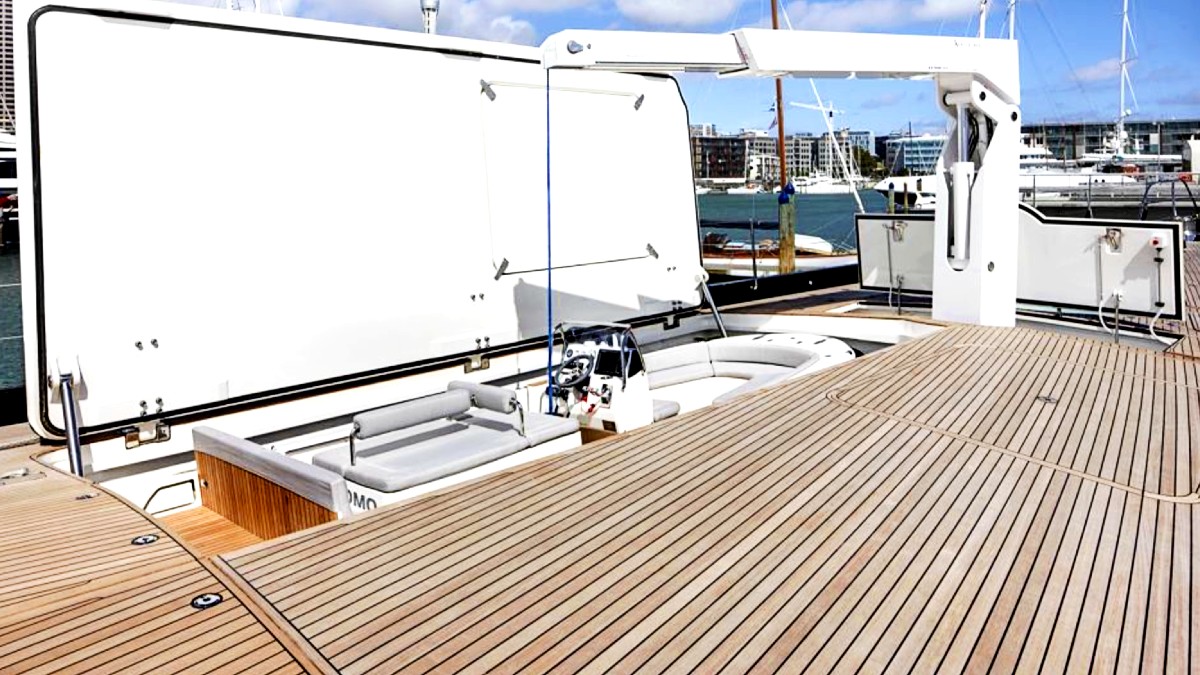
Now You See It, Now You Don’t
Kokomo might be big on technology, but never at the expense of design. The wheelhouse has fold-down computer screens that conceal the navigation equipment when not in use, converting to beautiful carbon counter tops. This design sleight of hand transforms a highly technical area into a tony lounge. It’s a theme that extends to the foredeck, where the yacht’s two tenders are concealed in dedicated lockers. There’s also a fully retractable tender crane that launches the tenders from either side of the boat but disappears out of sight when guests are using the Jacuzzi. “The designated deck lockers were an advanced feature at the time of her launch,” says Wynne, adding that another bonus is that diesel tanks are fully available. “The tenders can be fueled onboard before launching.”

It Takes Just A Few Good Sailors
Kokomo can accommodate up to 10 crew in total, but theoretically it only takes two to sail—a helm person and a sail trimmer. That sounds almost impossible given the size and complexity of yacht. But all sails are controlled by joystick on the flybridge. And when the boat is in full-on racing mode, there are control stations on both sides, providing visibility of the sails. Thanks to the hydraulics system, the mainsail can be hoisted and lowered on a wireless remote control. Of course, maneuvers like stowing the massive genoa can never be automated. That’s a job for a half-dozen good sailors.

Art On Board
The hallway that leads to the owner’s cabin is lined with a mosaic tapestry made from sea glass woven together with wire. Backlit to create an unusual effect, it’s just one of the eclectic works of art that decorates the interior. The main salon also has a stunning and colorful work of glass art as another example.
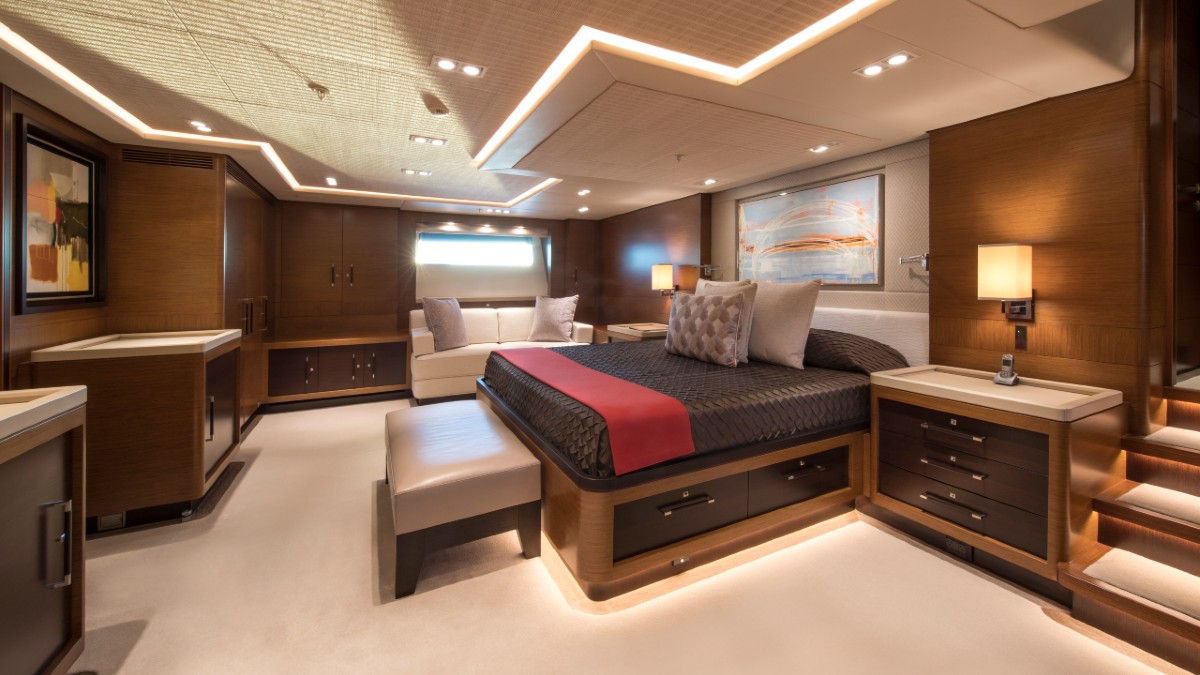
Interior Matters
Kokomo is not all tech features. The yacht’s modern interiors combine dark wood floors and calming cream furnishings start in the main salon and continue across the five guest cabins. Penned by British studio Redman Whiteley Dixon, the design carefully wraps around the lifting keel without sacrificing or impeding on any interior guest space. The yacht accommodates up to 10 guests in a master suite, VIP, one double cabin and two twins. There are other accommodations for up to 10 crew. On the foredeck, the Jacuzzi brings another element of outdoor entertainment, bolstered by a sunken cockpit.
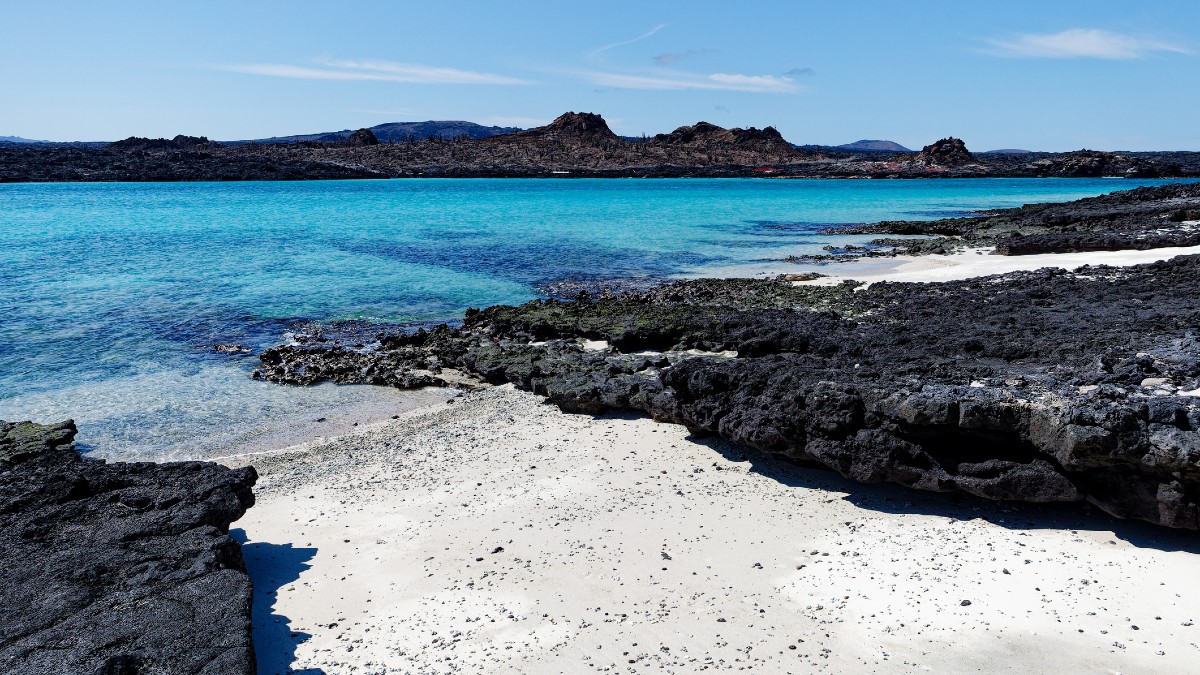
World Traveler
The mandate issued by Walker was to create a yacht that was a “quantum leap forward” from his previous yachts, with superior sailing characteristics and guest comfort. The mast’s height is too tall to sail through the Panama or Suez Canals, which meant it would have to be designed to sail around Cape Horn and the Cape of Good Hope to reach the Caribbean and Mediterranean. The maiden voyage took the yacht from the New Zealand shipyard to Australia, New Caledonia, the Solomon Islands, and Fiji. It also spent time at Walker’s private island (pictured above), also named Kokomo. The vessel has since spent many years exploring the Caribbean and Med. It’s based in both regions during the respective cruising seasons, with charters available through Cecil Wright.
More for You
Donald Trump's Candidates Get Warning From Republican Strategist
Pro-Trump attorney released from custody after promising to turn herself in on Michigan warrant
FTC just issued warning over this scam stealing thousands from Americans — how to stay safe
Dementia warning signs that can be spotted by the layout of a person's home
Megastar singer returns for high demand Las Vegas Strip residency
Jihadist and nuclear threat as African country tells US to leave amid Russian and Iranian gains
Key Republican Line Of Attack Is Thoroughly Dismantled In New Ad
Chubb ended Trump fraud bond talks after backing E. Jean Carroll appeal bond, court filing says
Larry Kudlow: Letitia James is running a scam
How a cheap, generic drug became a darling of longevity enthusiasts
Ruth Bader Ginsburg Award Ceremony Canceled After Honorees Draw Backlash
Jake Paul vs Mike Tyson: Date, fight time, rules, undercard, latest odds, how to watch, purse and more
These 9 House Republicans voted against a resolution condemning the Russian abduction of Ukrainian children
Vanguard unveils bold interest rate forecast ahead of Fed meeting
The next James Bond has reportedly been chosen, and film fans are divided
Jeff Bezos convinced his siblings to invest $10K each in Amazon in its early days and now their stake is worth over $1B — 3 ways to get rich outside of the S&P 500
The Georgia legal case against Donald Trump is falling apart
What’s the best fast-food fish sandwich? We ranked the top 5.
Posterchild for Russia's removal of Ukraine orphans says he was coached, threatened
Lindsey Graham Faces Backlash Over Ukraine Mobilization Call

What Size Yacht Requires a Crew? Here’s What You Need to Know

Do you dream of owning your own luxury yacht? Are you wondering what size yacht requires a crew and what kinds of responsibilities the crew members have? Whether you are just beginning to plan your yacht purchase or are a seasoned boat owner, this article will provide you with valuable information about the types of crew members, their responsibilities, and the benefits of having a crew on a yacht.
You will also learn how to choose the right crew for your yacht, considerations for hiring a crew, and how to properly care for your yacht crew .
So, let’s dive in and explore the exciting world of yachting!.
Table of Contents
Short Answer
Yachts that are over 30 feet in length generally require a crew to operate them safely.
This is because larger yachts typically require more maintenance and management than smaller ones, and without a trained crew, they can be difficult and dangerous to operate.
Some yacht owners opt to employ a full-time crew, while others may hire part-time or seasonal help depending on their needs.
What is the Definition of a Yacht?
When it comes to understanding what size yacht requires a crew, its important to first define what a yacht is.
A yacht is a large, luxurious vessel that is typically used for pleasure trips.
Yachts are typically motorized, and can vary greatly in size and design.
They may be used for leisurely cruises, racing, or any other type of recreational activity.
Yachts can range from small, open-deck vessels to large, multi-deck superyachts.
Generally, yachts over 80 feet in length are considered to be large enough to require a crew for operation.
The size of yacht that requires a crew depends on the size of the vessel, its intended purpose, and the needs of the owner.
Large yachts may require a larger crew to operate and manage the vessel, while smaller yachts may only need one or two crewmembers.
The crew will typically consist of a captain, engineer, mate, deckhand, steward or stewardess, and chef.
The captain is responsible for the navigation and operation of the yacht, as well as overseeing the other crewmembers.
The engineer is responsible for the maintenance and repair of the yacht.
The mate is responsible for deckhand duties such as cleaning and painting.
The deckhand is responsible for assisting the mate with various tasks.
The steward or stewardess is responsible for housekeeping and other guest services.
The chef is responsible for preparing meals for the guests.
Overall, the crewmembers are responsible for the day-to-day operation of the yacht, including navigation, maintenance, and housekeeping.
They are also responsible for providing a safe and enjoyable experience for the yacht’s guests.
Depending on the size of the yacht, the crew may also be responsible for additional tasks such as security, entertainment, and other services.
What Size Yacht Requires a Crew?

When it comes to yachts, size definitely matters.
If you want to enjoy the luxury of sailing the open seas, you’ll need to consider if a crew is necessary.
Generally speaking, yachts over 80 feet in length require a crew to operate.
Larger yachts may require a larger crew depending on the needs of the owner.
When it comes to crewmembers, they can include a captain, engineer, mate, deckhand, steward or stewardess, and chef.
These crewmembers are responsible for the day-to-day operation of the yacht, including navigation, maintenance, and housekeeping.
Additionally, they are responsible for providing a safe and enjoyable experience for the yacht’s guests.
The captain is typically the most experienced member of the crew and is in charge of all operations on the yacht.
The engineer is responsible for the maintenance and repair of the yachts mechanical systems.
The mate is responsible for navigation and safety, as well as assisting the captain with tasks.
The deckhand is responsible for taking care of the exterior of the yacht, such as cleaning, painting, and polishing.
The steward or stewardess is responsible for providing hospitality services to the guests, such as serving food and drinks.
Lastly, the chef is responsible for preparing meals for the guests.
Having a crew onboard a yacht is beneficial for many reasons.
A crew ensures that the yacht is operated safely, efficiently, and with the utmost care.
They also provide a level of luxury and convenience that many yacht owners desire, such as gourmet meals, drinks, and recreational activities.
Furthermore, having a crew onboard can help to alleviate stress and anxiety, allowing the yachts owner to focus on enjoying the voyage.
In conclusion, yachts over 80 feet typically require a crew to operate.
Depending on the size and needs of the yacht, the crew can include a captain, engineer, mate, deckhand, steward or stewardess, and chef.
Having a crew onboard provides a level of luxury and convenience that many yacht owners desire.
Furthermore, a crew ensures that the yacht is operated safely and efficiently.
Types of Crew Members and Their Responsibilities
When it comes to operating a yacht over 80 feet in length, a crew is necessary.
The size and number of the crew will depend on the needs of the yachts owner, as well as the size and type of yacht.
Common crew members can include a captain, engineer, mate, deckhand, steward or stewardess, and chef.
Each crew member has a unique set of responsibilities that are essential for the successful operation of the yacht.
The captain is the leader of the crew and is responsible for the overall safety, navigation, and maintenance of the yacht.
They must have the appropriate qualifications and experience to safely navigate the vessel and its passengers.
The captain is also responsible for ensuring that the yacht complies with all applicable laws and regulations.
They are often the main point of contact between the yacht and any authorities.
The engineer is responsible for the maintenance and upkeep of the yacht.
They must be knowledgeable in all aspects of the yachts mechanical and electrical systems, including engines, generators, and other onboard systems.
They are also responsible for troubleshooting and repairing any issues that may arise.
The mate is responsible for assisting the captain with navigation, maintenance, and other duties.
They must have an understanding of the vessels systems and be able to take the helm in the captains absence.
The deckhand is responsible for maintaining the exterior of the yacht.
This includes cleaning, polishing, and waxing the hull, decks, and exterior surfaces.
They must also be knowledgeable in the use of deck equipment, such as winches, windlasses, and mooring lines.
The steward or stewardess is responsible for housekeeping duties on board the yacht.
This includes cleaning and maintaining the interior of the yacht, as well as preparing meals and drinks for the guests.
The chef is responsible for preparing meals for the guests and crew.
They must be knowledgeable in all aspects of food preparation and presentation, as well as food safety and hygiene.
These are the typical crew members of a yacht over 80 feet in length.
Each crew member is responsible for ensuring the safe operation of the yacht and providing a pleasant and enjoyable experience for the guests.
An experienced and knowledgeable crew is essential for the successful operation of any yacht.
Benefits of Having a Crew on a Yacht

Having a crew on a yacht is an invaluable asset for any yacht owner.
A crew can provide a variety of services and benefits that can greatly enhance the experience of owning a yacht.
Having a crew on board can increase the safety of the yacht and its passengers.
A crew can help to navigate the yacht through unfamiliar waters, as well as handle any emergencies that may arise.
A well-trained crew can also help to maintain the yacht, ensuring that it is running at optimal performance.
In addition to safety, a crew can also provide a more enjoyable experience for those on board.
A crew can be responsible for housekeeping and meal preparation, freeing up the owner and guests to relax and enjoy the journey.
A crew can also help to organize activities, such as fishing, waterskiing, and sightseeing, to ensure that all passengers are entertained.
Having a crew on board also allows for greater flexibility when it comes to planning a trip.
A crew can help to plan a route, as well as provide advice on the best places to visit, the best restaurants to dine at, and the best activities to enjoy.
Finally, having a crew on board allows for peace of mind when it comes to operating and maintaining the yacht.
A crew can handle repairs and maintenance, as well as provide timely advice on any issues that may arise.
Overall, having a crew on a yacht can provide a wealth of benefits that can help to make the experience of owning a yacht much more enjoyable.
From increased safety and flexibility to more enjoyable activities, a crew can help to make owning a yacht a truly remarkable experience.
How to Choose the Right Crew for Your Yacht
Choosing the right crew for your yacht is an important decision that can make or break your boating experience.
Not only do you need to consider the size of the yacht and the number of crew members required, but you also need to make sure that the crew members you select are experienced, well-trained, and knowledgeable about the type of yacht you have.
When selecting a crew for your yacht, there are a few key factors to consider.
First, you need to make sure the crew members are qualified and certified to operate the vessel.
It is important to have a captain and crew that have the necessary certifications and experience to safely operate the yacht.
Additionally, you should consider the size of the crew you need.
Depending on the size of your yacht and the activities you plan to do, you may need more or fewer crew members.
In addition to experience and qualifications, you should also consider the personalities of the crew members.
You want a crew that is professional and knowledgeable, but also friendly and accommodating.
You want to make sure that the crew you select will be able to work well with the yachts guests and make sure everyone has a safe and enjoyable experience.
Finally, you should consider the cost of the crew.
Different crew members may have different rates depending on their qualifications and experience.
You should also factor in the cost of any additional supplies or equipment needed to operate the yacht, as well as any licensing or permit fees.
With careful consideration and research, you can select a crew that is qualified, knowledgeable, and friendly, and that will ensure that everyone aboard the yacht has a safe and enjoyable experience.
Considerations for Hiring a Crew

When it comes to hiring a crew for a yacht over 80 feet in length, there are a few key considerations to keep in mind.
The first is the size of the yacht.
Depending on the size and layout of the yacht, the number of crew members required may vary.
Larger yachts typically require a larger crew to manage maintenance, navigation, and housekeeping duties.
The second is the type of crew members you need to hire.
Yachts over 80 feet will typically require a captain, mate, engineer, deckhand, steward or stewardess, and a chef.
These crew members are responsible for the day-to-day operation of the yacht, and must be experienced and knowledgeable in their respective areas.
The third is the budget.
Hiring a crew for a yacht of this size can be expensive.
Depending on the size and scope of the vessel, the cost of hiring a crew can range from tens of thousands of dollars to hundreds of thousands of dollars.
Finally, you should also factor in the experience of the crew.
It is important to hire experienced and knowledgeable crew members who are familiar with navigation, maintenance, and housekeeping.
They should also be able to provide a safe and enjoyable experience for the yacht’s guests.
By taking all of these considerations into account, you can ensure that your yacht is well staffed and that the crew is up to the task of operating and maintaining the vessel.
How to Care for Your Yacht Crew
Having a yacht crew can be a great way to make sure your yacht is running smoothly, but it also comes with certain responsibilities.
As the yacht owner, you must ensure that your crew is taken care of and their needs are met.
This means providing them with proper wages, benefits, and a safe and comfortable working environment.
The first step to taking care of your crew is to ensure they are paid a fair wage.
This should be based on the size of the yacht, the type of work they will be doing, and the amount of experience they have.
It’s important to remember that the crew is responsible for the safety and enjoyment of the yacht and its guests, so they must be adequately compensated for their work.
In addition to wages, the crew should also be provided with benefits such as health insurance and paid vacation.
This ensures they are taken care of and that they can take time off if needed.
It also shows that you value their contributions to the yacht and appreciate their hard work.
Finally, you should also provide a safe and comfortable working environment for your crew.
This means making sure the yacht is well-maintained and that all safety protocols and regulations are followed.
It also means providing adequate rest and leisure time for the crew, as well as ensuring that their living quarters are clean and comfortable.
Taking care of your yacht crew is essential for ensuring that your yacht runs smoothly and that your guests have a safe and enjoyable experience.
By providing them with a fair wage, benefits, and a safe and comfortable working environment, you can make sure your crew is taken care of and your yacht is running at its best.
Final Thoughts
As you can see, owning a yacht larger than 80 feet will require a crew to operate.
Depending on the size of your yacht, you may need to hire a captain, engineer, mate, deckhand, steward or stewardess, and chef.
When choosing your crew, it is important to consider their experience, qualifications, and availability.
Additionally, it is important to be mindful of their wellbeing and provide them with a safe and comfortable environment.
Ultimately, having a crew on your yacht can provide many benefits and provide you with a memorable and enjoyable experience.
James Frami
At the age of 15, he and four other friends from his neighborhood constructed their first boat. He has been sailing for almost 30 years and has a wealth of knowledge that he wants to share with others.
Recent Posts
Does Your Boat License Expire? Here's What You Need to Know
Are you a boat owner looking to stay up-to-date on your license requirements? If so, youve come to the right place! In this article, well cover everything you need to know about boat license...
How to Put Skins on Your Boat in Sea of Thieves? (Complete Guide)
There is a unique sense of pride and accomplishment when you show off a boat you customized to your exact specifications. With Sea of Thieves, you can customize your boat to make it look like your...
A guide to Indian Lake, hammered by Thursday's storms
The Indian Lake area of Ohio was torn by storms Thursday night . Here's a guide to the lake:
Where is Indian Lake?
Indian Lake is in Logan County, about 70 miles northwest of Columbus.
How big is Indian Lake?
The lake is about 5,100 acres, making it the third largest lake in Ohio, behind Grand Lake St. Marys (13,500 acres) in Auglaize and Mercer counties and Mosquito Creek Lake (7,850 acres) in Trumbull County, according to the Ohio Department of Natural Resources. In addition, Pymatuning Reservoir, which straddles Ohio and Pennsylvania, covers 14,000 acres.
Is Indian Lake natural?
Indian Lake is man-made. According to the ODNR , it began in 1851 as "Old Indian Lake," a feeder lake for the Miami & Erie Canal. A bulkhead completed in 1860 allowed the lake, then called Lewiston Reservoir, to grow to more than 6,300 acres. Although Indian Lake is very shallow, with an average depth of 6 feet, it has largely been spared the algae that has stained other Ohio lakes because of the Indian Lake Watershed Project, established in the 1990s to keep the water clean.
How many people live on Indian Lake?
About 1,300 people live in the lake's largest town, Russells Point, and another 1,200 live down the road in Lakeview, both on the lake's southern shore. Hundreds more live around the lake, many of them in seasonal trailer parks and campgrounds, making the area vulnerable to storms.
What is Indian Lake best known for?
For decades, an amusement park and dance halls along the lake's southern rim drew visitors from miles around and provided the lake's nickname, the "Midwest's Million Dollar Playground." The last bits of the amusement park were torn down in the early 1980s; only the I ndian Lake Rollarena in Russells Point provides a hint of the lake's entertainment past.
Was the 1960s hit "Indian Lake" about this lake?
No. The Cowsills' 1968 Top 10 hit "Indian Lake" is thought to be based on a lake in Upstate New York.
What is housing like around Indian lake?
Much of Indian Lake's homes remain trailers in campgrounds, especially on the north and west sides of the lake. But a growing number of large new homes have been built on the lake this century, especially on the lake's multiple islands and eastern shore. Many of the older, modest homes still sell under $100,000, but newer homes can command more than half a million dollars. The lake's real-estate landed it a spot on the HGTV shows "Island Life" and "Island Hunters."
What impact did the storms have on the lake's state park?
The ODNR has closed Indian Lake State Park, on the west side of the lake, until further notice. "ODNR staff and other emergency crews will assess the impact of the storm and reevaluate the status of the park later today," the department posted Friday . The 8,400-acre park is one of Ohio's four original state parks, created in 1949.

IMAGES
VIDEO
COMMENTS
1. Luxury Yacht. Yachts are normally classified as any watercraft that can be used for pleasure or sport and can range from 30 ft to over 100 ft. While a yacht can be as small as 30 ft. long, a yacht is often considered a cabin cruiser until it is 39 ft. or more, then it is considered a proper yacht.
The Sailing Yacht A, initially known as Project 787 'White Pearl,' was delivered by Nobiskrug to her owner, Andrey Melnichenko, in 2017. As the world's largest sailing yacht, she measures an impressive 143 meters (469 ft) in length with a beam of 25 meters (82 ft). Featuring eight decks, SY A can accommodate 20 guests and a crew of 20.
The rig and sail plan of Sailing Yacht A. Three colossal unstayed masts - the largest carbon masts in the world - define Sailing Yacht A. The mainmast towers 100 metres above the waterline - taller than Big Ben. An enclosed electric gimballed crow's nest is incorporated, to whoosh a crew member 60 metres up the mast for what will surely ...
A superyacht is a luxury yacht with high-end amenities and extravagant features. These yachts often offer spacious cabins, multiple decks, swimming pools, helipads, and other luxurious facilities. FAQ 4: What is the average size of a yacht? Yachts can vary greatly in size. The average size of a yacht ranges from 30 to 60 feet.
SAILING YACHT A is the most expensive sailing yacht in the world and cost an estimated price of US $600 million - a relatively "affordable" price considering her large size and tonnage. A calculated US $48,000 per ton is considered low in the yachting industry, where European yachts are usually priced at US $60,000 per ton and over.
Common Motor Yacht Sizes: 40-49 Feet >>> Perfect size yacht for couples and small families. Motor Yachts in the 40-50 foot range make great starter yachts and can be owner operated. In this range, motor yachts will typically highlight 1-3 staterooms, sleeping anywhere from 2-6 people. 50-59 Feet >>> Motor yachts 50-60 feet are great for larger ...
This list of motor yachts by length, is a table of the world's longest active superyachts, with an overall length of at least 75 metres (246 ft) and up.. These boats are also known as "megayachts", "gigayachts" and even "terayachts", usually depending on length. It has been generally accepted by naval architects and industry executives that superyachts range from 37 m (≈120 ft) to 60 m (≈ ...
Yachts of this size will need 4-6 crew members: yacht captain, one or two deckhands, one or two stewardesses, a yacht chef, and presumably an engineer. 22-40 meter long motor yachts normally can host up to 8 guests.
Yachts can range up in size astonishingly. Any yacht that is 79 feet long or longer is classified as a "large yacht." Beyond a length of 130 feet, the vessel is typically called a "super yacht" (sometimes written as one word, superyacht).
B. Mid-Size Yachts. Mid-size yachts are typically between 40 and 80 feet in length. They offer more space and amenities than small yachts, and they are perfect for those who want a comfortable and spacious vessel for extended trips. C. Large Yachts. Large yachts are typically over 80 feet in length and offer an unparalleled level of luxury and ...
Yacht. A 45-foot cruising yacht in 2010. The superyacht Azzam, the largest private yacht by length, as of 2018. [1] A yacht ( / jɒt /) is a sailing or power vessel used for pleasure, cruising, or racing. [2] [3] [4] There is no standard definition, though the term generally applies to vessels with a cabin intended for overnight use.
Joining online yacht groups like those on Facebook and Twitter is a great place to seek answers when deciding on the right size yacht. Most yacht groups have some knowledge on the subject. The same goes for online forums like Reddit and Quora; a wealth of information at your fingertips if you ask the right people the right questions.
Choosing the Right Size Yacht. Selecting the right size yacht is a pivotal decision that should align with your preferences and needs. Here's some guidance on how to make this important choice: Budget: Determine how much you're willing to spend on purchasing and maintaining a yacht. Larger yachts generally come with higher purchase prices ...
Al Said - 509 FT. (155M) Prince Abdul Aziz - 482 FT. (147M) El Mahrousa - 475 FT. (145M) First, let's take a look at the new king - now the largest motor yacht in the world: 1. SOMNIO- 728 FT. (222M) Somnio will be the world's first 'yacht-liner'. Image credit: Winch Design. Due for launch in mid-2024, Somnio is expected to ...
Determine the yacht size that best suits your needs by considering key factors like intended use, guest capacity, and budget. Learn how the size impacts maintenance, operational costs, and staffing requirements. Explore the balance between comfort and manageability, with practical advice on how to assess your own boating experience and potential crew needs. With informed decision-making, find ...
Step into the role of a discerning buyer with our expert guide, crafted to aid you in choosing the ideal yacht size and capacity to complement your needs. Dive into the dynamics of yacht dimensions and how they impact everything from dockage options to entertainment spaces, ensuring a fit tailored to your social and navigational preferences. Our insights will help you determine the optimal ...
By Size. Based on length and size, yachts can be classified into the following categories: Megayachts: These are the largest of their kind. Most yachts under this category have lengths of over 50 meters. They are used for leisure or recreational purposes and are suitable for large families or groups. Most of such yachts are owned and operated ...
A boat becomes a "ship" often once it's reached a specific size, which tends to be on the bigger side and suitable for sea travel. In most cases, ships serve as working vessels, such as transport or cruise liners. "Yachts" are also more substantial, but they're solely recreational vessels and often used for luxury purposes.
The crew size can vary greatly depending on the yacht's size, amenities, and intended use. In general, larger yachts will have a larger crew, while smaller yachts may only require a few crew members. For example, a small yacht that is used for day trips or short-term charters may only require a captain and a mate. However, a larger yacht used ...
Living Aboard Motor Yachts. For a solo nomad, the ideal size sailboat to live on would be 35 feet for most people. However, if you are planning to live aboard a boat with a family, you will need a boat between 45-50 feet. Any boat below 35 feet would be too cramped for living, and you would quickly get cabin fever.
Benefits of Small Yachts for Solo Sailing. Opting for a smaller yacht size without crew offers numerous advantages for solo sailors, including enhanced handling capabilities and smaller dimensions suitable for crew-free sailing. Smaller yachts, typically ranging from 25 to 45 feet, provide greater maneuverability, allowing solo sailors to navigate tight spaces and handle the boat with ease.
Kokomo can accommodate up to 10 crew in total, but theoretically it only takes two to sail—a helm person and a sail trimmer. That sounds almost impossible given the size and complexity of yacht.
The size of yacht needed to safely and comfortably cross the Atlantic Ocean will depend on factors such as the number of people on board, the type of voyage, and the experience of the captain and crew. Generally, the vessel should be a minimum of 36 feet in length and have enough stowage capacity to carry enough supplies and provisions for the ...
When it comes to operating a yacht over 80 feet in length, a crew is necessary. The size and number of the crew will depend on the needs of the yachts owner, as well as the size and type of yacht. Common crew members can include a captain, engineer, mate, deckhand, steward or stewardess, and chef.
How many people live on Indian Lake? About 1,300 people live in the lake's largest town, Russells Point, and another 1,200 live down the road in Lakeview, both on the lake's southern shore.